March 30, 2018
Fiona Shaw's The Marriage of Figaro returns to the London Coliseum
As the walls of the Almaviva abode revolve, constantly, we are whisked into the back-quarters - the kitchen, the boot-polishing room, the laundry - which underpin aristocratic luxury. It’s a sort of horizontal upstairs-downstairs of class divisions, as maids slyly observe mistresses’ misdemeanours and footmen feign indifference to aristocratic indiscretions. Figaro and Susanna plan the construction and placement of their wedding bed while a scullery maid scrubs the stairs; as the Count woos Susanna, a housemaid carries a basket of oranges through the room, head bowed but eyes and ears craning.
Shaw strives to create a sense of the busyness of the back-room personnel, whose labours ensure that the front-of-house is a portrait of tasteful tranquillity and aristocratic idleness. But, despite having seen this production in both 2011 and 2014, I still can’t fathom why so many of the Almavivas’ workforce are suffering from a sleep disorder, unless the aim is to show the inefficacy and impotence of the Count as master of the house. Even the gardener Antonio is encountered asleep in a chair: and, so, his leap from la-la-land to lambasting fury makes a nonsense of the idea that he has just come running from the flowerbeds, his anger at window-hopping page’s destruction of his gardenias throwing another spanner into the maelstrom of the Act 2 finale.
Revival director Peter Relton hasn’t injected much of a pick-me-up into the proceedings, but part of the blame for the slightly lackadaisical spirit that I felt on this occasion seemed to lie with Brabbins. The ENO Orchestra sounded decidedly messy at times - though things did tighten up in Acts 3 and 4 - and pit-stage coordination was often adrift (though subsequent performances in the run will surely improve in this regard). But, tempi felt perennially just a shade too slow, with soloists often seeming to be tugging at the bit. The action of the recitatives sometimes laboured and dragged, though that’s also a weakness of the production, for it makes heavy work of the dramatic business: the intrigues and mishaps simply don’t buzz, fizz and whirl.
There are plentiful motifs, but they don’t always for mischief make. For example, Shaw has turned Basilio into a blind chorus-master (a variation on the piano-tuner stereotype I guess) which facilitates a few visual gags - incessant tapping of a white stick, the conducting of an invisible choir as the actual wedding chorus revolve off the set - but lost is the irony of such vicious lines as ‘What I said about the page, it was just a suspicion’ in the Act 1 trio, when Cherubino is discovered hiding and quaking in a trunk in Susanna’s room. Colin Judson sings with phrasing of curling obsequiousness and pertinently nasal piquancy but, deprived of his Act 4 aria, Basilio fades into the ‘foliage’ by Act 4.
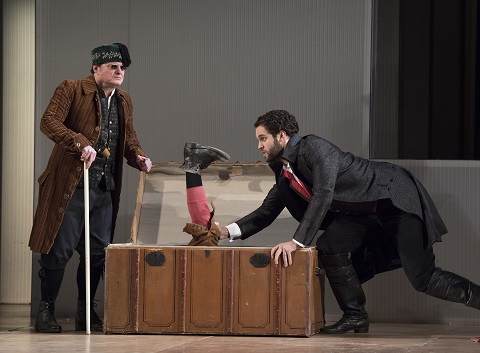 Colin Judd (Basilio) and Ashley Riches (Count Almaviva). Photo credit: Alastair Muir.
Colin Judd (Basilio) and Ashley Riches (Count Almaviva). Photo credit: Alastair Muir.
A few pre-curtain chuckles were garnered when a bedpost-carrying Figaro fiddled with an on-stage harpsichord, only to leap back in amazement when the keyboard seemed unilaterally to strike up the opera’s overture; but the gesture was less amusing when the Count repeated it with variations at the start of Act 3. And, the thumps and bumps (festive fireworks?) which accompanied the lengthy scene change before the final Act, as well as the vomiting in a flowerbed by an inebriant servant, were simply tiresome.
When the main ‘funny business’ of the first couple of Acts is some front-of-curtain shenanigans then things have gone awry, and there were times in Acts 1 and 2 when I had to remind myself that Figaro is an opera buffa. Fortunately, the arrival in Act 3 of Janis Kelly’s Marcellina, eager to claim the fulfilment of her marriage contract with Figaro only to discover that her ‘husband-to-be’ is her long-lost son, Rafaello, tipped the scales enchantingly, from to humdrum to humorous. Kelly, alongside Keel Watson’s bemused but beaming Doctor Bartolo, really did show how it’s done; and the comic duos’ esprit lifted the sharpness and sprightliness of the spat between Thomas Oliemans’ Figaro and Rhian Lois’ Susanna, resulting in an invigorating Act 3 sextet. One could only regret that Kelly, too, was deprived of her Act 4 aria.
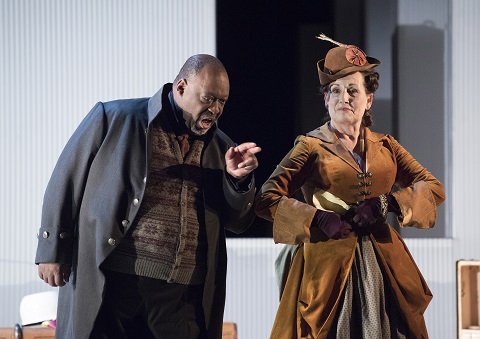 Keel Watson (Doctor Bartolo) and Janis Kelly (Marcellina). Photo credit: Alastair Muir.
Keel Watson (Doctor Bartolo) and Janis Kelly (Marcellina). Photo credit: Alastair Muir.
Much of the appeal of this production derived from the appearance of several young singers in role debuts. Lois was the best of the bunch: ‘progressing’ from her WNO turn as Barbarina, she was a vibrant, nimble, quick-witted Susanna, animated both dramatically and vocally, who had no trouble getting the better of both the loyal but laborious Figaro and the fickle but foolish Count. ‘Deh vieni, non tardar’ was beautiful, Lois’ unadorned melodic sincerity proving a masterful counterfeit.
Ashley Riches both sang and acted superbly as the hapless Count, puffing out his chest, squaring his shoulders, striding imperiously in his black leather boots, but ever sporting an air of slight bafflement as to how everyone else seemed to be in the know. Riches’ recitatives were fluently and convincingly delivered and in ‘Vedrò mentr’io sospiro’ he used all of his vocal might and nuance to offer a momentarily persuasive riposte to the uncovered plotting of Susanna and Figaro.
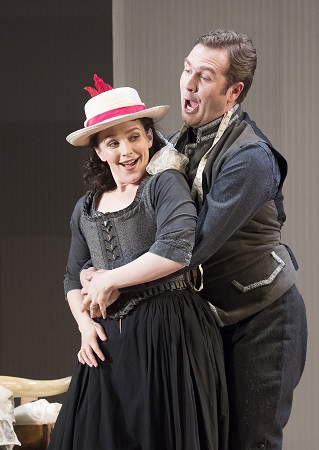 Rhian Lois (Susanna) and Thomas Oliemans (Figaro). Photo credit: Alastair Muir.
Rhian Lois (Susanna) and Thomas Oliemans (Figaro). Photo credit: Alastair Muir.
Thomas Oliemans’ Figaro was a pleasant enough chap. The Dutch tenor has a relaxed manner and attractive voice, but I’d have liked a bit more vocal ebullience, and physical presence. I was impressed by Katie Coventry’s Cherubino: just the right amount of richness in the voice to suggest nascent sexual burgeoning but balanced by a lovely gamine gentleness which Coventry did not overplay.
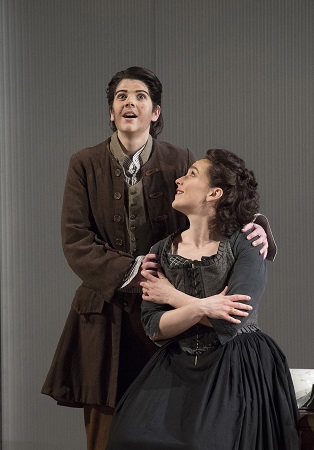 Katie Coventry (Cherubino) and Rhian Lois (Susanna). Photo credit: Alastair Muir.
Katie Coventry (Cherubino) and Rhian Lois (Susanna). Photo credit: Alastair Muir.
The appearance of Lucy Crowe making her role debut as Countess Almaviva was one of the big draws of this revival for me, but I left the Coliseum feeling slightly disappointed. We did have an occasional glimpse of the heavenly threads of Crowe’s high soprano, and her voice has become enriched with both new weight and fullness; but I felt that Crowe did not display the plushness of tone and colour required to communicate the Countess’s genuine distress and the pathos of her situation. She was able to soar over the ensemble, as in the Act 2 finale, but in the Countess’s two arias there was neither the enveloping luxuriousness nor the poignant eloquence to really win this listener over to the abused Countess’s cause. If the vocal characterisation seemed rather one-dimensional then Crowe also seemed not entirely comfortable dramatically: obviously attracted to Cherubino (she stroked his cheek during ‘Voi che sapete’), she later accepted her husband’s apologies at the close only to don modern dress and pick up her suitcase, heading, it seemed, for the marital exit. It may not have been Crowe’s fault, but the characterisation didn’t seem to add up.
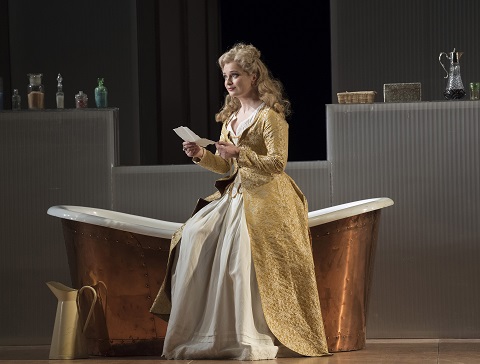 Lucy Crowe (Countess Almaviva). Photo credit: Alastair Muir.
Lucy Crowe (Countess Almaviva). Photo credit: Alastair Muir.
Shaw’s production tells the tale clearly - and given the nonsensical complexity of both libretto and back-story that in itself is no mean feat. Moreover, there are many vocal performances to enjoy in this revival. I think that my dissatisfactions come back to the production and design. The white-washed walls are lowered for Acts 3 and 4, opening up spaces which could be anything and anywhere. The cast may sport - at least until the close - period costumes, and oranges, flags and bull-fight motifs hint at a Sevillian setting, but the monochrome architecture and flowerless garden provide no context in which da Ponte’s larger-than-life characters can come to musical life and convincingly convey the human forgiveness which, in its concluding episode, Mozart’s opera so enchantingly and comfortingly espouses.
Claire Seymour
Mozart: The Marriage of Figaro
Count Almaviva - Ashley Riches, Countess Almaviva - Lucy Crowe, Susanna - Rhian Lois, Figaro - Thomas Oliemans, Cherubino - Katie Coventry, Marcellina - Janis Kelly, Doctor Bartolo - Keel Watson, Don Basilio - Colin Judson, Don Curzio - Alasdair Elliott, Antonio - Paul Sheehan, Barbarina - Alison Rose, Village Girls - Jane Read/Lydia Marchione; Director - Fiona Shaw, Conductor - Martyn Brabbins, Revival Director - Peter Relton, Designer - Peter McKintosh, Lighting Designer - Jean Kalman, Revival Lighting Designer - Mike Gunning, Movement Director - Kim Brandstrup, Video Designer - Steven Williams, Orchestra and Chorus of English National Opera.
English National Opera, London Coliseum; Thursday 29th March 2018.
image=http://www.operatoday.com/Alastair%20Muir.jpg image_description=The Marriage of Figaro: English National Opera, London Coliseum product=yes product_title=The Marriage of Figaro: English National Opera, London Coliseum product_by=A review by Claire Seymour product_id= Above:The Marriage of FigaroPhoto credit: Alastair Muir
Lenten Choral Music from the Choir of King’s College, Cambridge
Not that I did, of course: I tended to go to my own chapel services more than others’; I also tended to prefer the services down the road at St John’s, less packed with tourists and thus seemingly less of a ‘concert’. I also preferred, in many ways, the more ‘Continental’ sound of St John’s to the typically ‘English’, whiter sound of King’s. Nevertheless, it was always quite an experience, first to set foot in that masterpiece of late Perpendicular Gothic – pay no heed to its cultured despisers, the same sort who will tell you that St Paul’s is a monstrous hybrid – gowned (and thus in slightly better seating than the non-Cambridge congregants), and to hear that celebrated choir, which, through radio and other recordings, I had known for so long before my time in the city that was essentially my home for fifteen years.
Ben Parry, an old boy from the choir and Assistant Director of Music at King’s, substituted for Stephen Cleobury, who was recovering from a bicycle accident. Parry certainly knew the choir and how to play to its strengths; it is difficult to imagine anyone having been disappointed, even in the almost diametrically opposed (to its echoing Chapel home) acoustic of Cadogan Hall. If some tempo choices, perhaps especially in the closing Brahms motets, seemed chosen more to help the boys than on ‘purely’ musical grounds, there is no great harm in that. The business of a collegiate (or other) choral foundation, after all, is far more than providing concert material; indeed, that is not really its business at all. Perhaps those works by Brahms, Warum ist das Licht gegeben? and Schaffe in mir, Gott, the latter a setting of part of Luther’s translation of the Miserere (Psalm 51), will have flowed more readily, especially in the relationship between different sections, and indeed have benefited from surer intonation, but there was much to enjoy, especially in their respective closing sections.
Two settings of the Stabat Mater, by Palestrina and Lassus, opened the concert’s two halves. Both were nicely shaded, without jarring (to my ears, without any) anachronism. The performance of the former imparted, when called upon, a real sense of ‘dec and can’ ( decani and cantoris) antiphony in a different setting. It perhaps sounded closer to Monteverdi than often one hears, less ‘white’ than I had expected. Whatever the Council of Trent’s suspicion of the poem, I was struck by the essential simplicity, however artful, of the music and by the guiding role of words. Lassus’s setting came across as darker, a little more Northern perhaps. (He was, after all, Kapellmeister in Munich.) Within the context of an undoubtedly ‘Anglican’ performance, full of tone yet not too full, the sound seemed – or maybe it was just my ears adjusting – to become a little more Italianate as time progressed.
Poulenc’s Quatre motets pour un temps de penitence offer a challenge, not least intonational, to any choir, and are more often heard with older (female) voices. In these forthright performances, there was – rightly, I think – no great attempt made to ape other performing traditions, but there was nevertheless sometimes a harshness, even perhaps, in the closing ‘Tristis est anima mea’, an anger, we do not necessarily associate with the choir. The shading of ‘Vinea mea electa’ was intelligent, fuller than Anglican reputation would have you believe. If intonation proved far from perfect, especially in the opening ‘Timor et tremor’, nor should one exaggerate; one always knew where the music and indeed the text were heading.
The music of Tallis and Byrd is home territory for King’s – albeit here without the trebles. Naturally, in their absence, countertenors came more strongly to the fore. Parry wisely made no attempt to do too much in terms of word-painting in the Tallis; the words speak for themselves, and did so here especially on the Lenten cries for ‘Ierusalem, Ierusalem’ to return to her God. The two Byrd motets offered, for me, the highlight of the concert. Without a hint of blandness or routine, there was simply – or not so simply – that ineffable sense of ‘rightness’, of ease with the music, the composer’s recusancy notwithstanding. Music and words spoke freely, in greatly satisfying performances. As we heard in both, ‘Sion deserta facta est, Jerusalem desolata est.’ And yet, there was comfort to be had, if not in the wilderness and desolation of Jerusalems heavenly and earthly, then in their artistic representation – which is doubtless as it should be.
Mark Berry
Programme:
Palestrina: Stabat Mater; Tallis:Lamentations of Jeremiah (Part 1); Poulenc:Quatre motets pour un temps de penitence; Lassus:Stabat Mater; Byrd: Ne irascaris, Domine;Civitas sancti tui; Brahms: Warum ist das Licht gegeben; Schaffe in mir, Gott. Choir of King’s College, Cambridge/Ben Parry (conductor). Cadogan Hall, London, Wednesday 21 March 2018
image=http://www.operatoday.com/choral-services-full-music-list-lent-2018-1.png image_description=Photo courtesy of King's College, Cambridge product=yes product_title=Lenten Choral Music from the Choir of King’s College, Cambridge product_by=A review by Mark Berry product_id=Above: Photo courtesy of King's College, CambridgeA New Faust at Lyric Opera of Chicago
The role of Marguerite is sung by Aylin Pérez and that of her brother Valentin by Edward Parks. Siébel is performed by Annie Rosen, Marthe by Jill Grove, and Wagner is Emmett O’Hanlon. The performances are conducted by Emmanuel Villaume and the Lyric Opera Chorus is prepared by its Chorus Master Michael Black. This new production of Faust is designed by John Frame and directed by Kevin Newbury. Sets and costumes are designed by Vita Tzykun, projected imagery is designed by David Adam Moore, lighting by Duane Schuler, and wigs and makeup by Sarah Hatten.
The predominantly dark stage in the opening scene depicts a workroom or studio, interior windows are covered with drapes while ladders are placed near these channels to the exterior world. A small screen shows a video projection. As light begins to pervade the studio, a scrim rises, and attention is focused on the doddering movements of an elderly man. His resigned words beginning with “Rien” (“Nothing”) express dissatisfaction with an oppressive existence. Mr. Bernheims’ monologue continues with an impassioned statement on the vanity of Faust’s efforts until now. While applying a constant volume in vocal projection, Bernheim colors distinctly individual words, “Salut” and “destin,” by which Faust “greets” his purported final day when he plans to take poison and master his “destiny.” In response to Faust’s doubt in God’s help and his repeated curses, Bernheim’s final evocation forte to “Satan! à moi!” brings Méphistophélès out from behind a draped window. Mr. Van Horn’s entrance establishes this Satan as a master of all situations: his cool control and unyielding intrusion into the dramatic progression make him here a force that cannot be shut off. From the start, Van Horn’s supple voice lends even greater credibility to his characterization of the demonic force in nature. His performance throughout shows a remarkable command and ability to adapt his voice to varying dramatic needs. Van Horn’s emphasis here on “puissance” (“power”) is countered by Bernheim’s insistence on “la jeunesse” (“youth”) as a goal. Two innovations of this productions support the dramatic flow at this point and again in subsequent acts. The video projection of a woman moving through a natural setting captures Faust’s thoughts and desires of the moment. Once he commits his signature guaranteeing future service to Méphistophélès, Faust drinks the potion of youth and is transformed by a band of masked minions who appear henceforth in this production at strategic moments to carry out the devil’s bidding. “En route” (“Let us away”) is taken as a journey of discovery for Faust with Méphistophélès leading the path immediately into the public space and tavern starting in Act Two.
The drinking song is performed by a chorus dressed now in nineteenth-century garb; gradually soldiers wearing French uniforms from the time of Gounod drift onto the scene. At the entrance of Valentin attention is focused on the supervision of Marguerite during the brother’s forthcoming military absence. Mr. Parks performs the signature aria “Avant de quitter ces lieux” (“Before departing thee lands”) with a soldierly tone, while expressing lyrical warmth primarily in the middle section of the piece. His confrontation with Méphistophélès is facilitated by the masked assistants pushing stage center the table onto which the devil climbs to sing “Le veau d’or” (“The calf of gold”). Van Horn’s crisp intonation of the melodic line and his exciting delivery of the final verse, “Et Satan conduit le bal” (“And Satan leads the ball”) characterizes the unflagging power of this demonic force. During this first, extended scene of the act Faust lurks about and wanders among the citizens, students, and soldiers assembled, as though reinforcing Mr. Newbury’s program comments that “the whole story is in Faust’s imagination.” Once he reenters vocally in keeping with Gounod’s score, the protagonist persists in reminding Méphistophélès of his promise. As the crowd separates, Marguerite appears here in a solitary, seated pose. Ms. Pérez rebuffs Faust’s offer “pour faire le chemin” (“to escort you on your way”) with understated yet thoughtfully intoned lines. Once she is spirited away with the intercession of the minions, Bernheim declares fortissimo his affection for Marguerite. A stylized, projected image of Faust appears on the stage rear wall at the close.
Such emphasis on demonic control continues into the central Act Three. Through a scrim, village trees are gradually visible during the entr’acte as well as Van Horn’s Méphistophélès posed in contemplation with a lit cigarette. In delivering Siébel’s couplets of a lovelorn suitor’s devotion Ms. Rosen pours out cascades of sincere emotion while addressing the flowers to be left for Marguerite. Rosen’s attention to key lines and application of rubato communicate her character’s pivotal attempts to shield the heroine with innocent love. The final “doux baiser” (“tender kiss”) which Siébel hopes to send via the flowers is held by Rosen with an achingly extended pitch. Faust’s approach to Marguerite’s dwelling is, likewise, accompanied by his cavatina praising nature for its formation of Marguerite. Bernheim’s slightly nasal, reedy voice caresses the individual lines as he credits “Nature” for having developed this ideal. The repetition of “Salut” and Bernheim’s panegyric to Marguerite’s beauty is accomplished with seamless legato and shifts in color to indicate emotional intensity. During and after the iconic aria this production’s external visualization of a character’s feelings is displayed to good effect just as an image of large, colorful lilies is projected onto the stage, while Bernheim concludes with a sustained note Faust’s outpouring of devotion. Almost immediately the Satanic helpers bring a box of jewels and place it at a strategic locale near Marguerite’s dwelling. This cottage appears raised on stilts so that the helpers can crawl beneath the house and indicate their watchful temptation. In her performance of the “Roi de Thulé” Pérez sings with an introspective, wistful tone to capture the king’s fond memory of his departed wife. Her exquisite piano phrasing at the close forms a transition to the startled reaction of finding the box. Pérez begins the “Jewel Song” indeed softly with enthusiasm and vocal decoration building after she tries on a pair of earrings. This curiosity increases as one of Satan’s helpers emerges to hold up a mirror and thereby tempt Marguerite even further. The following quartet of Marthe and Méphistophélès, Marguerite and Faust is cleverly staged, so that the interests of both couples remain constant while they continue to perform from different focal points. Ms. Grove shines in the cameo tole of Marthe with both her singing and acting contributing comic relief and a motivation to further the plot. Yet the ultimate prod is here Méphistophélès, at whose urging Faust is now pushed by the minions into the arms of Marguerite.
The scenes of progressive emotional starkness in the remaining parts of the opera present Marguerite first with a callous Faust, then alone, and next as a penitent in church. In this latter scene the lighting on the stage rear suggests a religious interior when Marguerite sits on a bench. Positioned next to her, and clearly plaguing her conscience as symbol, Méphistophélès’s ringing statements accelerate as the orchestral volume swells. At the same time the lighting through a mock window now resembles the flames of hell. The chilling determination unleashed by Van Horn’s performance in this scene in church epitomizes the dramatic power communicated by this superb singer and actor. His facial expression etches a relentless force which dominates through to the inevitable conclusion. Marguerite’s faith will save her as declared, but Faust must pay for his transgressions. As an ironic reminder in the final scene of the opera in this production, Faust dons one of the sculpted masks to follow the others as henceforth one of the band of Méphistophélès.
Salvatore Calomino
image=http://www.operatoday.com/benjamin_bernheim_faust_t8a0811_c.cory_weaver_preview.png
image_description=Benjamin Bernheim [Photo © Cory Weaver]
product=yes
product_title=A New Faust at Lyric Opera of Chicago
product_by=A review by Salvatore Calomino
product_id=Above: Benjamin Bernheim [Photo © Cory Weaver]
March 26, 2018
Netrebko rules at the ROH in revival of Phyllida Lloyd's Macbeth
Key scenes take place at night. The witches, who meet Macbeth ‘’ere the set of sun’, are, says Banquo, ‘ The instruments of darkness [who] tell us truths’. Lady Macbeth invokes darkness to help her to descend to hellish depths: ‘Come, thick night,/And pall thee in the dunnest smoke of hell,/That my keen knife see not the wound it makes,/Nor heaven peep through the blanket of the dark,/ To cry “Hold, hold!”’ While one would not doubt the transformative magic effected by Shakespeare’s text, it’s a play that seems less suited to a sun-lit staging on the broad platform of London’s Globe Theatre, say, than to the candle-lit intimacies of the Sam Wanamaker Playhouse which now sits alongside.
This might have been a matinee performance but Anthony Ward’s designs and Paule Constable’s lighting set for Phyllida Lloyd’s 2002 Macbeth, receiving its third revival at the ROH under revival director Daniel Dooner, certainly plunged us into an enveloping blackness. And, as we moved through murky vaults and weightily panelled castle rooms, strong contrasts of shrouding coal-blackness and concentrated brightness vividly evoked the claustrophobic darkness of the troubled mind - none more effectively than the dagger of light that streaks like a bolt of lightning across the floor as Macbeth contemplates regicide and its consequences. Even the cherished and acquired golden sceptre, for all its bright gleam, suffocates with hollow promise rather than liberates through ambition fulfilled: kingship is a gilded cage, sometimes a miniature casket, sometimes spinning throne room, but always sterile and unrewarding.
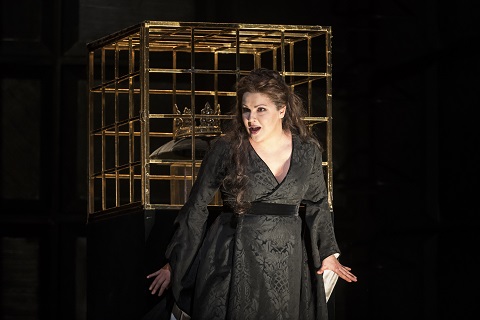 Anna Netrebko (Lady Macbeth). Photo credit: Bill Cooper.
Anna Netrebko (Lady Macbeth). Photo credit: Bill Cooper.
However, Lloyd and Ward also successfully enlarge the vista at times, particularly with the arrival of Macduff’s and Malcolm’s armed soldiers in Act 4. In this way, Macbeth reverses the trajectory of Othello which moves from Venetian streets, the beaches of Cyprus, and rooms of state towards the terrible poignant intimacy of the bedchamber. And, there are some impressing visual images which cut through the prevailing gloom: the body of the executed traitor, Cawdor, splayed behind the battlefield; Duncan’s blood-stained corpse displayed in a glass coffin in the subterranean mausoleum where Banquo will meet his untimely end; Lady Macbeth’s bath - a marble sarcophagus into which she slips at the end of her first scene, thereby introducing the juxtaposition of blood and water which runs through the play and will be underscored when the bath returns in the sleep-walking scene.
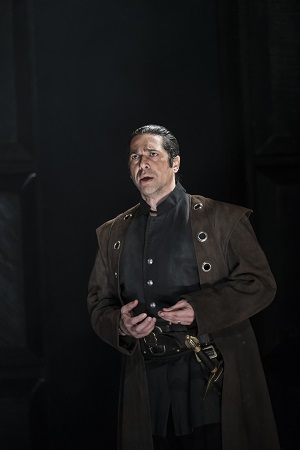 Ildebrando D’Arcangelo (Banquo). Photo credit: Bill Cooper.
Ildebrando D’Arcangelo (Banquo). Photo credit: Bill Cooper.
I am less enamoured by Lloyd’s decision to make the witches not just the messengers of Fate but its very agents: they carry Macbeth’s letter from the battlefield to his wife; they open a trapdoor which enables Fleance to escape from the murderers who slay his father. Surely this undermines the very notion of Fate which needs no assisting interventions? More significantly, it conflicts with Shakespeare’s Queen’s conviction that her husband will wear ‘the golden round,/ Which fate and metaphysical aid doth seem/ To have thee crown'd withal’ [emphasis added]. And, in weakening Lady Macbeth’s own authority over her husband, the ambiguity of influence is destroyed: is it Fate, evil as embodied by the witches, his wife’s insatiable lust for power or Macbeth’s own ‘vaulting ambition’ that drives the inexorable tragedy. Verdi himself had described Lady Macbeth as ‘il demonio dominatore’ (the dominating demon … [who] controls everything’. [1]
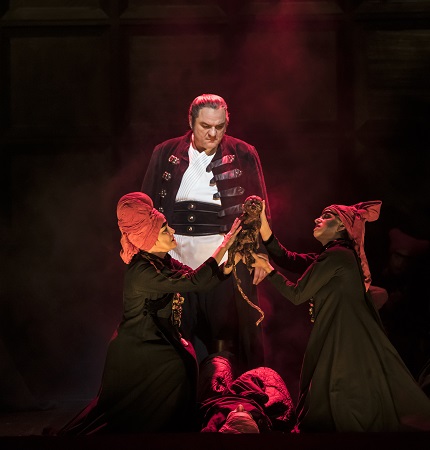 Željko Lučić and witches chorus. Photo credit: Bill Cooper.
Željko Lučić and witches chorus. Photo credit: Bill Cooper.
Admittedly, Verdi’s opera is less interested in individual psychologies than Shakespeare’s play. Terrible acts are carried out, but the pace is swift and there’s not time for much self-scrutinising soul-raking. And, Lloyd uses the witches to create visual and dramatic coherence, as when their red turbans metamorphose into the military sashes sported by Macduff’s troops. Moreover, the branches from Birnam Wood which the soldiers clutch are the very staffs so roughly stamped into the ground by the witches in the opening chorus. The latter gesture and other choreographic exaggerations, such as the witches’ tortured writhing at the start of Act 3, sometimes border on pantomime. But, there are other effectively choreographed moments such as the monk-habited murderers killing of Banquo as he pays homage at Duncan’s tomb, and the staging of the banquet scene which spins with slippery unease - though Banquo’s ghost fails to make its present felt in the maelstrom.
I also remain unconvinced by the production’s intimation that it is the anguish of childlessness that drives the usurping couple. Shakespeare’s Lady Macbeth has ‘given suck’ (though admittedly the Macbeth’s children don’t loom large in the play text); but, more importantly, she taunts the unmanly, wavering Macbeth with her own derision for feminine and maternal feeling and the fortitude of her purpose: ‘I … know/How tender 'tis to love the babe that milks me:/ I would, while it was smiling in my face, Have pluck’d my nipple from his boneless gums, /And dash’d the brains out,had I so sworn as you/ Have done to this.’
Lloyd’s reading seems to negate one of the most chilling images of the play. In Act 3, Macbeth’s imagined dreams of happy family life are briefly fulfilled by the witches who bring in a brood of children to perch upon the marriage bed, bearing them aloft like angels, only to snatch them away again and for the bed to divide, the schism between the couple - who remain onstage, asleep on their single beds as Malcolm’s troops gather - forever irreparable. But, it is surely guilt which isolates the couple? Verdi, unlike Shakespeare, has Lady Macbeth in on the plot to murder Banquo, but it’s hard to imagine that she kills herself - if indeed it is suicide that brings about her end - because she is not a mother.
If the conflicts of conscience are suggested by Constable’s contrasts of blackness and brightness, then conductor Antonio Pappano conjured equally striking chiaroscuro effects from the ROH orchestra. The pianissimo wind melody and violin whispers which begin the overture were brutally thrust aside by the loud heralding triplet motif of dark bassoons, trumpets and trombones; then, from the silence, crept the slightest, most tentative of violin forays, only for the strings to be obliterated by a tutti onslaught. So the battle of light and darkness went on, as vividly painted, and at times as shocking, as a Caravaggio biblical drama. Pappano also knows how to make something of Verdi’s rum-te-tum accompaniments, not quite, but almost, overcoming the disjuncture we sometimes feel between the surprisingly jaunty musical sound-world and what we imagine to be the unsettling maelstroms within the individuals’ psyches.
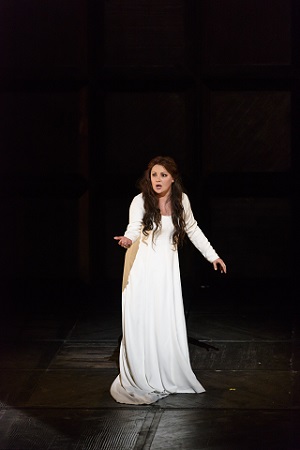 Anna Netrebko (Lady Macbeth). Photo credit: Bill Cooper.
Anna Netrebko (Lady Macbeth). Photo credit: Bill Cooper.
Of course, Verdi’s Macbeth needs a Queen who can reign over all, and the ROH was fortunate to have Anna Netrebko to draw in the crowds and preside vocally. I have to say that the icing on the cake of this theatrically imperial performance - which was throughout and at the final curtain vigorously and loudly lauded - would have been, for this listener at least, a little more pitch-precision and occasionally a less steely hardness. Netrebko’s Queen was reckless from her the first, storming wildly through ‘Vieni! T'affretta!’ with impetuous fire and undeniable wilfulness and in Act II’s ‘La luce langue’ (the 1865 revised Paris score was used) her implacable desire, bordering on insanity, could not be doubted. Netrebko’s soprano has tremendous weight - at the close of Act 2 she brilliantly and brazenly surmounted the choral majesty - and both sheen and darkness, and a whole host of other textures and colours in between. And, if I longed for a little more grace at times then my wish was fulfilled in the sleep-walking scene were such is the Russian soprano’s technique - already greatly in evidence in the tight trills of the brindisi - that she was able to bring together the conflicting voices of Lady Macbeth’s inner conscience - the disjointed fragments, the leaps between registers, the arioso which tantalisingly offers the all too brief consolation of cantabile lyricism - and she almost nailed the quiet Db peak at the close. Perhaps Netrebko’s acting was a little too self-conscious at times, but there’s no doubt that she created a lustrous-voiced Queen to please the composer who called for a Lady Macbeth who was ‘ugly and evil … [with] a diabolical quality’. [2]
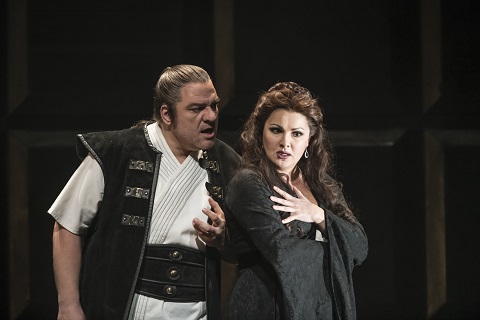 Željko Lučić and Anna Netrebko. Photo credit: Bill Cooper.
Željko Lučić and Anna Netrebko. Photo credit: Bill Cooper.
Netrebko was reunited with baritone Željko Lučić with whom she appeared in Macbeth at the Met in 2014. Lučić’s warrior seemed psychologically wounded from the start, unnerved by the appearance of the witches and dominated by his wife, and he didn’t really plumb the depths of vaulting ambition nor convince me that there was any chemistry between the regal pair. But, Lučić’s baritone is mellow, if not velvety, and the line elegant. If the vocal vacillations of Act I’s ‘Due vaticini’ were not totally persuasive, and if the Serbian baritone had a tendency to be just below the note, then Act IV’s ‘Pietà, rispetto, amore’ was measured, powerful and true.
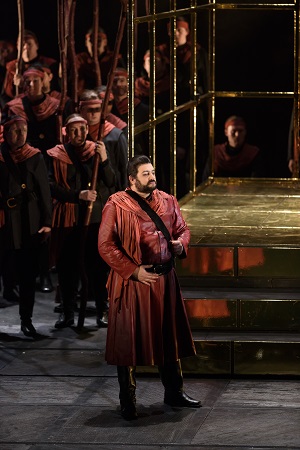 Yusif Eyvazov (Macduff). Photo credit: Bill Cooper.
Yusif Eyvazov (Macduff). Photo credit: Bill Cooper.
All of the emphasis in Macbeth is on the central protagonists - Macduff is not an antagonist but a tenore comprimario and the murder of Lady Macduff and her children are excised (though Lloyd makes their presence felt briefly, when they make a hasty exit from the banquet) - but the ROH cast for this revival is uniformly strong and we enjoyed a beautiful exemplification of bel canto technique from Yusif Eyvazov (Macduff) and a strong performance by Jette Parker Young Artist Konu Kim as a reluctantly crowned Malcolm. I particularly liked the directness and sombre colour of Ildebrando D’Arcangelo’s Banquo, and as the Doctor and Lady-In-Waiting respectively, JPYA’s Simon Shibambu and Francesca Chiejina introduced the somnambulist in clearly enunciated recitative.
This may not be a ‘perfect’ Macbeth, if there can be such a thing, but the cast - from fictional monarch to minion - conjure Verdi’s and Shakespeare’s darkness powerfully and persuasively.
Claire Seymour
Giuseppe Verdi: Macbeth
Macbeth - Željko Lučić, Lady Macbeth - Anna Netrebko, Banquo - Ildebrando D'Arcangelo, Macduff - Yusif Eyvazov, Lady-in-waiting - Francesca Chiejina, Malcolm - Konu Kim, Doctor - Simon Shibambu, Fleance - Matteo di Lorenzo, Assassin - Olle Zetterström, First Apparition - John Morrissey, Second Apparition - Gaius Davey Bartlett, Third Apparition - Edward Hyde, Herald - Jonathan Coad; Director - Phyllida Lloyd, Conductor - Antonio Pappano, Designer - Anthony Ward, Lighting designer - Paule Constable, Choreography - Michael Keegan-Dolan, Orchestra of the Royal Opera House, Royal Opera Chorus (Concert Master - Sergey Levitin).
Royal Opera House, Covent Garden, London; Sunday 25th March 2018.
[1] Quoted in David Rosen and Andrew Porter, Verdi’s ‘Macbeth’: A Sourcebook (New York, 1984), p.99.
[2] Verdi, letter to Salvatore Cammarano, 23rd November 1848; trans. in Verdi’s ‘Macbeth’, p.67.
Photo credit: Bill Cooper
March 25, 2018
San Diego’s Ravishing Florencia
I had been hoping for years to catch up with a production of this acclaimed piece, but schedules have conflicted and life had intruded. Happily, I have made up for lost time, and the SDO mounting was so persuasive that I immediately vowed to seek out another performance of this masterwork at the earliest opportunity.
San Diego has long had a connection with the composer, having produced his Rappaccini’s Daughter (La hija de Rappaccini), the first work by a Mexican composer to be presented by a major opera house in the United States. The success of Rappaccini's Daughter brought Catán international attention, launching his musical career in the United States and sealing the commission of his next opera, Florencia en el Amazonas by the Houston Grand Opera .
In this local premiere, the piece was so lovingly mounted that it was clear the company was treating the work as the masterpiece it decidedly is. The lush score borrows stylistically from Puccini here, Debussy there, here a taste of Strauss, there a dash of Britten, but the unifying whole is peppered with Latin undertones and the voice is uniquely Catán’s.
Almost the entire plot unfolds on the deck of a ship sailing up the Amazon bound for Manaus. There, a legendary opera house awaits the return engagement of diva Florencia Grimaldi, performing a concert as she returns to her homeland to reunite with her lover Cristobal, a hunter of exotic butterflies. Her quest to rediscover her lover Cristobal is the whole driving force of the piece. Although she is traveling among other passengers in disguise, Florencia’s enigmatic persona drives the motivations of the other characters.
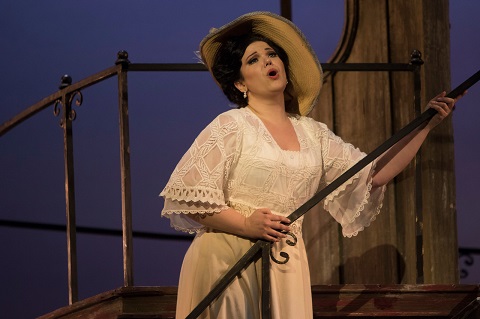 Elaine Alvarez as Florencia Grimaldi. Photo credit: J. Katarzyna Woronowicz.
Elaine Alvarez as Florencia Grimaldi. Photo credit: J. Katarzyna Woronowicz.
The music making was superlative, starting with the vocals. In the title role, Elaine Alvarez made a stunning impression. Her pliable spinto soprano easily encompassed every demand of three wide-ranging arias. The rich, pulsing tone was absolutely even throughout the wide-ranging part, and her alluring vocal presence anchored the performance with a poised, polished musical presence. Ms. Alvarez made us abundantly aware of why the public was in awe of her towering talents.
Every bit her equal, María Fernanda Castillo was a luminous Rosalba, her plush lyric soprano soaring above the staff to provide many of the evening’s most goose bump inducing moments. Ms. Castillo’s substantial soprano is tinged with pure gold and her sympathetic phrasing endeared her to the spectators. As her partner in romance, dashing Daniel Montenegro (Arcadio) provided exceedingly poised singing in equal measure. Mr. Montenegro is not only an ingratiating lyric tenor, but also has a winning way with a high-lying, pulsing phrase that made a fine impression. As the two love interests, the pair provided one of the evening’s highlights with a rhapsodic Act II duet.
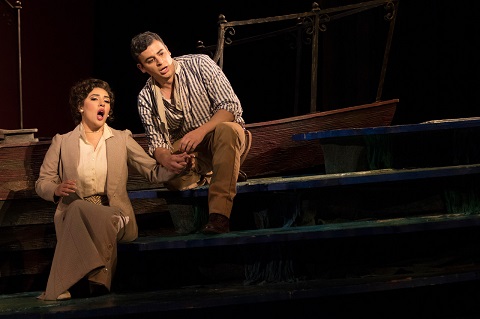 Maria Fernanda Castillo as Rosalba and Daniel Montenegro was Arcadio. Photo credit: J. Katarzyna Woronowicz.
Maria Fernanda Castillo as Rosalba and Daniel Montenegro was Arcadio. Photo credit: J. Katarzyna Woronowicz.
Luis Alejandro Orozco was a galvanizing presence as Riolobo. Part narrator, part demigod, Mr. Orozo’s imposing baritone was a potent presence, and his shirtless strutting provided handsome eye candy for the opera glasses crowd.
As the bickering, dyspeptic married couple, Levi Hernandez (Alvaro) and Adriana Zabala (Paula) were alternately amusing, annoying, and ultimately, touching. Mr. Hernandez has a beefy baritone that communicates securely and sympathetically.
Ms. Zabala’s rather barbed opening pronouncements eventually morphed into some mellifluous phrases infused with deference and luminosity. Hector Vásquez was a solid presence as the stolid Capitán, his seasoned baritone ringing out with honesty and clarity. Chorus Master Bruce Stasyna’s well-schooled ensemble not only sang with glowing tone and dramatic fire, but also cleanly executed some inventive staging while doing it.
Conductor Joseph Mechavich worked wonders with the orchestra, mastering every harmonic surge and eliciting finely tuned detail from the pit. Maestro Mechavich also skillfully wed singers, dancers and instrumentalists into a seamless ensemble. He controlled the arc of the piece with refined skill, all the while he somehow magically made the outpouring of melodies and effects feel exuberantly spontaneous.
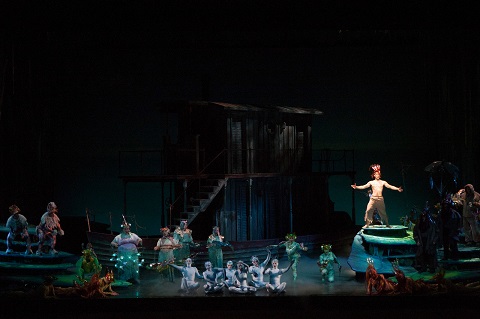 Luis Alejandro Orozco as Riolobo is joined by the San Diego Opera Chorus. Photo credit: J. Katarzyna Woronowicz.
Luis Alejandro Orozco as Riolobo is joined by the San Diego Opera Chorus. Photo credit: J. Katarzyna Woronowicz.
The handsome physical production originated at Indiana University, but seemed a perfect fit for the resources of the Civic Theatre. A forty-two-foot, double-decker riverboat dominates the stage as part of Mark Frederic Smith’s masterful set design. It begins at a pier in the opera’s first scene, with a boathouse structure framing the action. However, as the craft soon sets sail on the murky Amazon, the house flies away, and lush foliage droops artistically around the action.
The effect never becomes tiresome since the ship rotates on a turntable to reveal different, detailed perspectives of its construction. When the ship beaches in the storm, terraced riverbanks swing into place down left and right, and up right, which afford mystical river creatures to gambol and pose with enigmatic abandon.
Those “creatures” (aka the chorus and corps de ballet) were lavishly costumed by Linda Piano, who seems to have limitless imagination. The masks, fanciful accessories, painted body stockings and footwear were meticulously coordinated, and were complemented marvelously by Steven W. Bryant’s wacky, winning wig and make-up design. Ms. Piano also created lovely, character specific period wear for the diva Florencia, upper and lower-class guests, and laborers, greatly helping to define the relationships.
Todd Hensley’s brooding, ever-changing lighting design perfectly captured the emotional shifts in the plot, as well as the climate changes on the river. His choices of color filters were especially apt. Only two effects might have been improved upon: the storm lightning was tracked to look too predictable, and the overall threat of the turbulent storm (as heard in the music) was not realized with enough abandon. And the climactic moment of Florencia transforming into a butterfly went for too little. The unfurling of the costume, creating two wings, was a great start, but the rotating star gobo was a far cry from the coup de theatre that was called for. Think Defying Gravity, Wicked’s Act One closer, where the main character soars up to the wings as the black cloth of her cape spreads to fill the entire backdrop around her, and you get some idea of the jaw-dropping effect that might be needed.
Still, director/choreographer Candace Evans worked wonders with her resources, achieving moments that were beautifully judged for character revelations and dramatic insights. Ms. Evans deployed her assemblage of spirits with aplomb, creating a fine diversity of groupings and movement without ever creating a distraction. Indeed, she instilled a keen sense of dramatic focus was one the productions strong suits.
From the downbeat and the start of the engaging musical effects, to the ascendant metamorphosis that rang the curtain down, this was one memorable river journey I wished would never end.
James Sohre
Daniel Catán: Florencia en el Amazonas
Florencia Grimaldi: Elaine Alvarez; Rosalba: María Fernanda Castillo; Riolobo: Luis Alejandro Orozco; Arcadio: Daniel Montenegro; Capitán: Hector Vásquez; Alvaro: Levi Hernandez; Paula: Adriana Zabala; Sailor: Bernardo Bermudez; Conductor: Joseph Mechavich; Director/Choreographer: Candace Evans; Set Design: Mark Frederic Smith; Lighting Design: Todd Hensley; Costume Design: Linda Piano; Wig and Make-up Design: Steven W. Bryant; Chorus Master: Bruce Stasyna.
image=http://www.operatoday.com/FLORENCIA%20EN%20EL%20AMAZONAS.Photo%20J.%20Katarzyna%20Woronowicz%20Johnson.jpg image_description=Florencia en el Amazonas: San Diego Opera product=yes product_title=Florencia en el Amazona: San Diego Opera product_by=A review by James Sohre product_id= Above: Cast of Florencia en el AmazonasPhoto credit: J. Katarzyna Woronowicz
Samantha Hankey wins Glyndebourne Opera Cup
Mezzo-soprano Samantha Hankey, 25, from the USA, was crowned the overall winner, receiving £15,000 and the guarantee of a role within five years at one of the top opera houses represented on the competition jury. She also won the Media prize, chosen by a panel of opera critics and classical music journalists.
A native of Massachusetts, Hankey attended the Merola Opera Program in San Francisco and recently graduated from The Juilliard School. In 2017/18 she makes her debuts as Rosina in Il barbiere di Siviglia at Den Norske Opera, Siébel in Faust at Grand Théâtre de Genève, and her Carnegie Hall debut in Handel’s Messiah with Musica Sacra. She was Grand Finals winner of the 2017 Metropolitan Opera National Council Auditions and first prize winner of the Dallas Opera Guild Competition.
‘I am honoured and humbled to be awarded the Glyndebourne Cup,’ she says. ‘The announcement left me speechless. This entire week has been incredible working with the staff at Glyndebourne and all who were involved in the competition, and it means so much to me to have been acknowledged as having something to say in interpreting Mozart’s music. I cannot say “thank you” enough for this honour”
Winning the Audience Prize, with a third of all votes cast by those in the auditorium who watched the final, was Kosovan soprano Elbenita Kajtazi, 27. Kajtazi as a young girl was forced to flee her home in war-torn Kosovo with her family, and live as a refugee in Albania. ‘Every time there would be a dangerous situation - the soldiers would come into our house or something like that - I would find a corner and sing to myself. Singing was my way to be able to feel safe,’ she recalls.
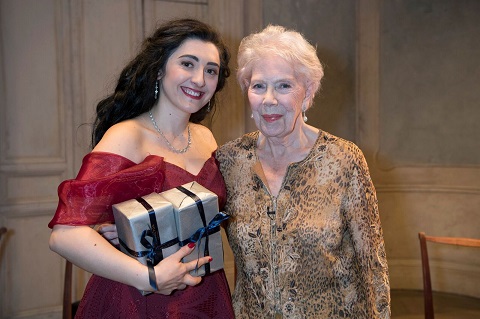 Elbenita Kajtazi and Dame Janet Baker Photo credit: Richard Hubert Smith.
Elbenita Kajtazi and Dame Janet Baker Photo credit: Richard Hubert Smith.
On her win she commented: ‘The audience prize means that the audience loved me and what more could I ask for? I’m for the first time here in England and I get this kind of treat and I’m able to get in people’s hearts, this means the world to me.’ Kajtazi also took Third place.
Second place went to American soprano Jacquelyn Stucker, 28, currently a Jette Parker Young Artist at the Royal Opera House, where she recently performed the role of Frasquita in Barrie Kosky’s production of Carmen.
The Ginette Theano prize for most promising talent was awarded to American soprano Emily Pogorelc, 21. Pogorelc was the youngest competitor to reach the final and is currently entering her final year at the Curtis Institute of Music.
The prizes were presented by Dame Janet Baker, the competition’s honorary president who helped to adjudicate the final. The final of the Glyndebourne Opera Cup was broadcast live on Sky Arts, hosted by Chris Addison and Danielle de Niese.
image=http://www.operatoday.com/Glyndebourne%20Cup%20winner.jpg image_description=The Glyndebourne Opera Cup 2018 product=yes product_title=The Glyndebourne Opera Cup 2018 product_by= product_id= Above: Samantha Hankey with Dame Janet BakerPhoto credit: Richard Hubert Smith
Handel's first 'Israelite oratorio': Esther at the London Handel Festival
In fact, Handel’s first ‘Israelite oratorio’, Esther, dates from Handel’s early years in London. Like Acis and Galatea, which the London Handel Festival had presented at St. John’s Smith Square a few days earlier, it was written for James Brydges (later Duke of Chandos) and thought to have been performed at Cannons, Brydges’ Middlesex estate, during 1718-20.
The libretto, which was probably fashioned by the poets Alexander Pope and John Arbuthnot, is a dramatic adaptation of the Old Testament narrative, in which the pious Esther acts to save the threatened Israelites from a pogrom at the hands of their Persian oppressors, and Jean Racine’s play Esther of 1688 (which had been seen in London in 1715 in an English paraphrase by Thomas Brereton), which emphasises the challenge to God’s authority and the divine salvation of the Israelite people. Musicologists and commentators have sought allegorical relevance in the affirmation of Jewish courage and conviction but have been as likely to suggest a parallel between the English Anglicans and the ‘Chosen People’ as to see the Jewish minority as representative of the English Catholics within a Protestant majority. When the worked received its ‘public’ premiere, in London in 1732, additional text by Samuel Humphreys enhanced the connection to the Hanoverians through implied compliments to George II and Queen Caroline.
This performance by the London Handel Orchestra at Wigmore Hall was stylishly directed by Adrian Butterfield, who fulfilled a dual role as violinist-conductor. In fact, with such an accomplished band of musicians before him, I wondered if Butterfield might not have relinquished his fiddle on this occasion; for, while the vocal standards were high, not all of the young soloists were equally adept at creating character and developing the narrative momentum. The numbers that were most successful were the choruses, when Butterfield laid his violin aside and stood to conduct, creating exciting drive and momentum.
Indeed, one might feel that Handel’s finest achievements in Esther are the choral sections: the contrasting joy - when the Jews rejoice that Esther, a believer, has become Queen - and despair, when they learn of Haman’s vicious decree that they should be annihilated; their confident assertion, ‘He comes!’, that God will defend them; and the magnificent triumphal chorus which closes the oratorio. Almost all of the soloists joined to form the choral ensemble, producing a lively, bright sound, with the strings’ generating zip and vigour and Darren Moore’s trumpet adding majesty and jubilance to the final triumph: ‘The Lord our enemy has slain’.
The instrumental contributions in the arias were no less affecting and accomplished. Stephen Mills’ relaxed, pure tenor was graciously accompanied by the violins’ gentle pizzicato and James Eastaway’s beautiful oboe obbligato, as the First Israelite expressed the people’s unwavering trust in ‘great Jehovah’, and Mills’ clean tone was equally well-suited to persuading us of the condemned Mordecai’s faith. The horns (Gavin Edwards and Clare Penkey) added relish to the glorification of Jehovah of the start of Act 3.
Best of the soloists was Erica Eloff as the eponymous saviour of the nation. The winner of the 2008 Handel Singing Competition, Eloff has impressed before ( Adriano in Siria , Elpidia ) and on this occasion I was struck by the extended range of colours that the South African soprano deployed to convey Esther’s love, fear, doubts and hopes. She really made the text count in Esther’s first air, capturing the deep sincerity of the queen’s prayer, and her angry dismissal of Haman’s ‘flatt’ring tongue’ left none in doubt of Esther’s inner strength, an impression which grew in the elaborated repetitions of the aria’s da capo. Eloff even managed a convincing ‘faint’ when Esther quakes in fear before Ahasverus as she pleads for Mordecai’s deliverance, before reviving to invite her lord to a banquet at which she intends to expose Haman’s vendetta with sufficient beauty of voice and manner to convince Ahasverus to submit to his wife’s entreaties.
As Ahasverus, William Wallace - in common with some of the other soloists - took a little while to judge the acoustic of Wigmore Hall, in which a capacity audience was seated. Initially he forced his tenor a little too much, but as Esther’s appeals worked their magic, Wallace’s voice relaxed and charmed in ‘O beauteous Queen’. Baritone Josep-Ramon Olivé colourfully revealed Haman’s vengeful exasperation in the oratorio’s opening aria, expressing his indignant fury with plenty of bluster, though a little less might have been more - the diction was rather muddy.
Timothy Morgan was also somewhat over-earnest as the First Priest of the Israelites, which affected his tuning at times, but Morgan’s counter-tenor is appealing, and he communicated with directness. As the Israelite Boy, Camilla Harris displayed a lovely sheen and graceful phrasing in her single aria, which was further enhanced by exquisite interplay from the pianissimo violins, flute (Rachel Brown) and harp (Frances Kelly). Tenors Ben Smith (Habdonah) and Laurence Kilsby (Officer/Second Israelite) completed the accomplished vocal ensemble.
Claire Seymour
Handel: Esther HWV50
London Handel Orchestra: director/violin - Adrian Butterfield.
Esther - Erica Eloff, Ahasverus - William Wallace, Haman - Josep-Ramon Olivé, Israelite Boy - Camilla Harris, Priest of the Israelites - Timothy Morgan, Mordecai/First Israelite - Stephen Mills, Habdonah - Ben Smith, Officer/Second Israelite - Laurence Kilsby.
Wigmore Hall, London; Thursday 22nd March 2018.
image=http://www.operatoday.com/Erica%20Eloff.jpg image_description=Esther: London Handel Festival, Wigmore Hall product=yes product_title=Esther: London Handel Festival, Wigmore Hall product_by=A review by Claire Seymour product_id= Above: Erica EloffMarch 23, 2018
Probing Bernstein and MacMillan double bill in Amsterdam
Clemency is based on an episode in Genesis in which three strangers visit Abraham and Sarah. They promise that Sarah, who is childless and past her climacteric, will bear a son within a year, but also announce the obliteration of the sinful cities Sodom and Gomorrah. In Trouble in Tahiti, Sam and Dinah already have a son, Junior, and everything else they could wish for, but they can’t seem to muster any patience or tenderness for each other, let alone love. Both one-acters deal with barrenness, emotional and biological, and director Ted Huffman stages them symbolically in an empty swimming pool. For Trouble in Tahiti the well-lit pool is cluttered with furniture, accessories and everything money can buy. The soft pastels are then replaced by Clemency’s dim interior. All the stuff is gone, and the bottom of the pool is lined with leaves. Alex Brok lights Abraham and Sarah’s dining table with beams from above, as in paintings depicting visitations from heaven. Set and costume designers Elena Zamparutti and Gisella Cappelli use clean lines and make marked statements with color. Like the rest of the production team and cast, they are young artists with great promise.
In the pit, Duncan Ward conducted the Netherlands Chamber Orchestra with alertness and dash. Musically, the two works are worlds apart. Bernstein uses a wide orchestral palette for his feather-light jazzy tunes and swelling lyricism. MacMillan’s string-only orchestra sounds like an augmented string quartet. His dark, threatening score is imaginatively crafted, with frequent tempo switches and harmonies that toss and turn as in a fever. Perhaps because MacMillan’s chamber opera is the more operatic piece, Clemency was more musically successful. Both the musical theatre idiom and the language of Trouble challenged the singers, most of whom are not North American. Even the orchestra, despite some very accomplished playing, did not sound completely free. In particular, the singers in the jazz Trio that provides a running commentary on suburban vapidity seemed to be working a little too hard. They bravely aimed for, but missed, the called-for powder-puff, breathy effect.
Theatrically, they fleshed out the plot by playing the invisible characters in the opera, such as Dinah’s psychiatrist. Dressed as clowns, they remained constantly onstage, ineffectually trying to direct Sam and Dinah to act like an American dream couple. Sebastià Peris i Marco sang Sam with a lovely, soft-grained baritone. A more assured attack on the words would have given his character more defined contours, especially in Sam’s anthem for alpha manhood and jockhood “There’s a law”. Soprano Turiya Haudenhuyse gave a winning performance as Dinah. Haudenhuyse is not only an expressive singer, but also an inherently natural actress who easily takes possession of the stage. Richly colored at the center and pliant throughout, her voice is a special instrument. For the hit number “What a movie”, Huffman put her on a flower swing, the visual high point of the evening. He dealt with the cultural appropriation and misattribution in Dinah’s plot summary by labeling the scene “Mom sees a racist movie”. The staging was chock-full of such entertaining and insightful touches, but was marred by live black-and-white video of the performers, distractingly out of sync with their movements. Whether this was on purpose or not, the video was superfluous. The libretto makes it clear enough that the silver screen is, for Sam and Dinah, both an ideal to strive for and a form of escapism.
Everything worked in Clemency and it will be among the best productions of DNO’s current season. Resonant bass-baritone Frederik Bergman hijacked the public’s attention with the first, full-bodied notes of Abraham’s Chant, and the rest of the performance followed suit. The orchestra rendered the tense score with horrific splendor. The five excellent soloists, whose voices blended with and overlaid each other perfectly, moved with studied purpose. Soprano Jenny Stafford was a penetrant Sarah, a heroine in a psychological thriller falling to pieces bit by bit. Lucas van Lierop, Stefan Kennedy and Alexander de Jong were the Triplets, the polite visitors who turn out to be suicide bombers on their way to destroy the Twin Towns, an echo of the Twin Towers. Taking his cue from MacMillan’s dissonant warnings, Huffman reveals the travelers’ ambivalent nature much earlier. Their annunciation plays out as a macabre ritual as they put Sarah on the table and lay their hands on her intrusively. From then on the tension started mounting and never let up.
Jenny Camilleri
Cast and production information:
Leonard Bernstein: Trouble in Tahiti
Dinah: Turiya Haudenhuyse; Sam: Sebastià Peris i Marco; The Trio: Kelly Poukens, Lucas van Lierop and Dominic Kraemer; Junior (Actor): Jasper Fleischmann.
James MacMillan: Clemency
Sarah: Jenny Stafford; Abraham: Frederik Bergman; The Triplets: Lucas van Lierop, Stefan Kennedy and Alexander de Jong.
Director: Ted Huffman; Set Design: Elena Zamparutti; Costume Design: Gisella Cappelli; Lighting Design: Alex Brok; Video: Pierre Martin; Conductor: Duncan Ward. Netherlands Chamber Orchestra.
Seen at the De Meervaart Theatre, Amsterdam, on Thursday, 22nd of March 2018.
image=http://www.operatoday.com/DNO_troubleintahiti_1600x900.png image_description=Photo courtesy Dutch National Opera & Ballet product=yes product_title=Probing Bernstein and MacMillan double bill in Amsterdam product_by=Review by Jenny Camilleri product_id=Photo courtesy Dutch National Opera & BalletDon Carlos in Lyon
Mr. Honoré has reduced his Lyon Don Carlos to some sort of obscure theater metaphor. Thus basic scenic accoutrements and machines of an empty stage are the environments wherein the complexities of Phillip II’s filicide, uxoricide and amicicide unfold.
For the Fontainebleau forest there were some theatrical drapes and a dense, very dense fog of choking theatrical fog and not very much theatrical light. For Saint-Just there was another plane of theatrical drape and not much light, but there was a stage floor trap open to somewhere below. The masquerade was an orgy, theatrical drapes moving back and forth, hide and seek, peeking at couplings (sexual) certainly not that public during the Spanish Inquisition.
For the auto-da-fe the stage became an old raw wood theater, the Spanish court, the Flemish supplicants, and the Madrid populace stuffed into a side wall of boxes, the heretics (four total) were twitching architectural detail. Phillip II’s bedroom was a variation of the raw wood theater structure whose side boxes served to hint at cloister for the Grand Inquisitor. The stage was an empty black box for Rodrigo’s death in Carlos’ cell.
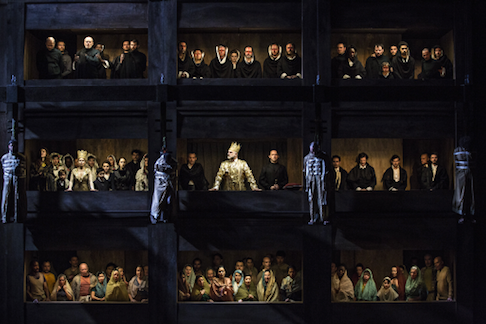 The Auto-da-fé
The Auto-da-fé
Back in Saint-Just the floor trap was again open to allow the entrance of incarnate Carlo V ashes in the form of a sort of walking cherub with a lighted breast plate. There was a scenic coup de theatre to let us know something had happened (what?) when a panel of drapes fell to the floor revealing a huge, seated blue madonna.
The evening was divided into two two-hour segments. At first we sat patiently during the lengthy minutes it took to cobble, and re-cobble together these set changes, and then impatiently in disbelief at such conceptual, indeed abusive ineptitude.
The edition was cobbled together as well. Among other machinations a part of the ballet was restored. Given that Ferrando had showered before his tryst with Fiordiligi back in Aix we knew a water feature would come. Voilà! The four soon to be immolated heretics fought and frolicked under an inexplicable shower of water as the ballet music chugged on. These four dancers appeared a final time laid out in Phillip II’s study during his famous soliloquy.
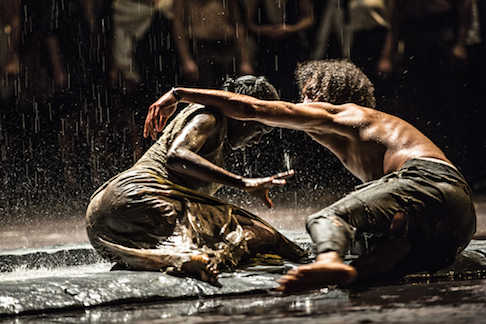 Two of the four heretics in the shower
Two of the four heretics in the shower
Mr. Honoré embellished his concept by confining Princess Eboli to a wheel chair. French mezzo Eve-Maud Hubeaux is a lyric mezzo whose presence is non-threatening even without a broken leg. Her Eboli was of an engaging comic energy. French baritone Stéphane Degout is a quite lyric baritone as well, conferring a youthful naïveté on Rodrigue (Posa) that precluded a poetic gravitas we might expect from the opera’s one sympathetic personage. The easy energy of these two performers made them audience favorites.
Russian tenor Sergei Romanovsky carved a plausible Don Carlos, his light lyric voice responding to this character’s presumed epilepsy, though his swoon before Elisabeth found none of its magic. But this Don Carlos could not plausibly challenge his father. British soprano Sally Matthews has a significant wobble in her low and medium register evoking a maternal rather than romantic presence. She did find some convincing phrasing in her high voice that made her "Toi qui suis la néant" (Tu che la vanita) one of the few dramatic successes of the evening.
Italian bass Michele Pertusi as well captured some of the sublimity of phrasing in Phillip II’s "Elle ne m'aime pas" (Ella giammai m'amò) though the dignity of this scene dissolved into a dry anger that permeated his character start to finish. Italian bass Roberto Scandiuzzi was a warm voiced, bland Grand Inquisitor, though the night before he had created a dynamic Banquo in Macbeth.
With the conceptual, directorial and casting malaise of the production it was difficult to access the contribution of the pit to the evening. The Opéra de Lyon orchestra put forth some beautiful sounds, notably in the strings. Conductor Daniele Rustioni did indeed support the few successful moments of the evening with stylistic precision.
It was a long, very long, too long evening in Lyon.
Michael Milenski
Cast and production information:
Philippe II: Michele Pertusi; Don Carlos: Sergey Romanovsky; Rodrigue, marquis de Posa: Stéphane Degout; Le Grand Inquisiteur: Roberto Scandiuzzi; Un Moine: Patrick Bolleire; Elisabeth de Valois: Sally Matthews; La Princesse Eboli: Eve-Maud Hubeaux; Thibault, page d’Elisabeth: Jeanne Mendoche; Une Voix d'en haut: Caroline Jestaedt; Le Comte de Lerme: Yannick Berne; Un Héraut royal: Didier Roussel; Députés flamands:Dominique Beneforti, Charles Saillofest, Antoine Saint-Espes, Paolo Stupenengo, Denis Boirayon, Thibault Gerentet. Orchestre, Chœurs et Studio de l'Opéra de Lyon. Conductor: Daniele Rustioni; Mise en scène: Christophe Honoré; Décors: Alban Ho Van; Costumes: Pascaline Chavanne; Lumières: Dominique Bruguière; Chorégraphie: Ashley Wright. Opéra de Lyon, March 16, 2018.
image=http://www.operatoday.com/DonCarlos_Lyon1.png
product=yes
product_title=Don Carlos in Lyon
product_by=A review by Michael Milenski
product_id=Above: Eboli (in wheelchair) and Elisabeth at masquerade [All photos copyright Jean-Louis Hernandez, courtesy of Opéra de Lyon]
March 21, 2018
Macbeth in Lyon
It’s a hard stretch of imagination indeed to connect the dynastic intrigue of Verdi’s opera (and this is Shakespeare’s play) with money hungry stock trading witches. Nonetheless the high tech trading room provided a rich backdrop of arbitrary decor — binary numbers flashing on countless monitors, the myriad screens morphing into interpretive pop television images from time to time, the entire back wall of the white stage box becoming a gigantic TV screen of surveillance camera images of the opera’s murders, its apparitions, and the TV reportage of Occupy Wall St.
All this was simply the counterpoint of passionate pursuit of riches to an intense Freudian drama playing out center stage, Lady Macbeth nurturing the ambitions of her husband Macbeth with her idea of a realpolitik — the simple elimination of competing parents and their progeny. These acts evolved into the couple’s shared moral and physical sterility that precluded all possibility of creating their own succession.
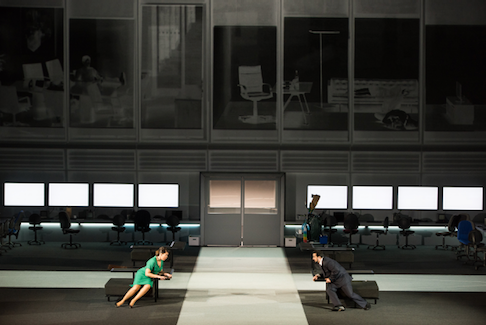 Lady Macbeth and Macbeth, above is negative projection of soon-to-be-murdered Duncan's rooms
Lady Macbeth and Macbeth, above is negative projection of soon-to-be-murdered Duncan's rooms
Stage director Ivo van Hove defied Verdi’s wishes for a Lady Macbeth of ugly voice and overt madness by creating a full breasted, nurturing Lady Macbeth of powerful, even beautiful voice to match her fully confident if morally hesitant and certainly beautifully voiced husband. Mr. Van Hove further defied Verdi (and Shakespeare) by ultimately joining husband and wife into one tortured being, Macbeth shadowing and suffering with Lady Macbeth in her final moments of torture. His ultimate spousal compassion was his strangulation of Lady Macbeth.
This was not the blood and thunder Verdi of political action, it was a Verdi of bel canto, two tortured beings singing themselves into a complicity of mutual understanding that was to become their destruction. It was the stuff of high tragedy.
Conductor Daniele Rustioni found the precise balance between beautiful singing and stinging feeling countered from time to time with Verdi’s interwoven compassionate flute and oboe solos. Mo. Rustioni worked unrelentingly with Azerbaidjan baritone Elchin Azizov, a fine singer and a gifted actor, and Italian soprano Susanna Branchini, a physically and musically elegant singer to find and musically achieve this latent, and very real human tragedy.
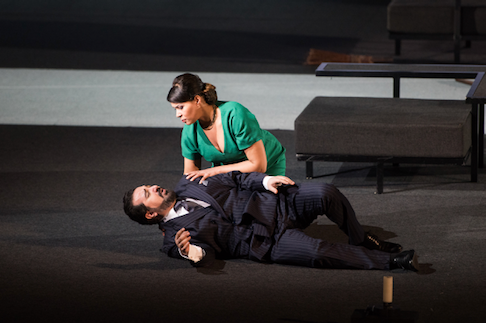 Macbeth and Lady Macbeth
Macbeth and Lady Macbeth
Director van Hove wittily introduced a silent, observant black janitress who cleaned up the messes left on stage — the trader/witches’ printouts, Lady Macbeth’s bloody rags, the thrown chairs — and generally replaced the grim emotional residue with a stoic calm. She was a pointed, sarcastic comment on big money.
Director van Hove’s chorus scenes were masterfully configured, the chorus of female witches spread around the edges of the huge white box stage, its disembodied sound coming together in occasional center stage groupings. Of particular effect was the staging of the chorus of Scottish refuges, here something like later day East Coast flower children, who emerged in solo movements to animate individual suffering.
The opera’s triumphal chorus was a Occupy Wall Street camp bacchanal of live TV coverage including an gigantic cameo of beautifully sung lines by Macduff, Russian Arseny Yakovlev. There were splendid takes of cocky young Malcolm, the new king, sure to soon become, together with the balance of the Occupy Wall Street demonstrators, as greedy as Mr. and Mrs. Macbeth.
And such inevitable domestic tragedies to begin anew.
Maybe Mr. Van Hove did not have this resolution in mind when he created this production in the aftermath of the 2008 financial markets crisis and the 2011 demonstrations. But his fine production has discovered unexpected new resonance.
It was a splendid evening of beautifully produced opera.
Michael Milenski
Cast and production information:
Macbeth: Elchin Azizov: Lady Macbeth: Susanna Branchini; Banco: Roberto Scandiuzzi; Macduff: Arseny Yakovlev; Médecin: Patrick Bolleire; Malcolm: Louis Zaitoun. Chorus and orchestra of the Opéra de Lyon. Conductor: Daniele Rustioni: Mise en scène: Ivo van Hove; Décors et lumières: Jan Versweyveld; Costumes: Wojciech Dziedzic; Vidéo: Tal Yarden. Opéra de Lyon, March 15, 2018.
image=http://www.operatoday.com/Macbeth_Lyon1.png
product=yes
product_title=Macbeth in Lyon
product_by=A review by Michael Milenski
product_id=Above: Arseny Yakovlev as Macduff (live projection) and Occupy Wall St. demonstrators [All photos copyright Stofleth, courtesy of Opéra de Lyon]
An Interview with Soprano Lisette Oropesa
Staged in conjunction with Joffrey Ballet Chicago, the production features both dance and singing. Since Oropesa sings with silver tones and moves as gracefully as a dancer, she is a natural for the part.
Where did you grow up?
I grew up in Baton Rouge, Louisiana. I went to several different schools growing up, and got to know lots of different people. We attended church on Sundays, and my mom was the junior choir director there. That's where I got my major start in singing in public, as I sang solos almost every week. I started playing the flute as a “tween” as well, and have many wonderful memories of being in band and orchestra.
Did you study piano? Other instruments? Guitar?
Yes I studied the flute formally for about 10 years, and I do play some piano by ear, as well as guitar!
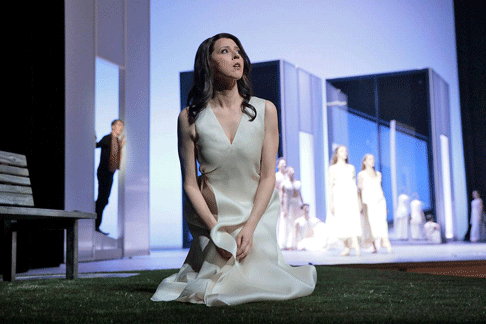 Lisette Oropesa as Eurydice [Photo © Ken Howard]
Lisette Oropesa as Eurydice [Photo © Ken Howard]
When did you see your first opera?
My mom, Rebeca Oropesa, was a singer so I saw operas that she was in. I think my first was La Traviata when she was singing Violetta. The first opera I was ever in was Hansel and Gretel, at the Baton Rouge Opera, in which I played one of the gingerbread children. I saw very littls opera on TV, but we heard it on the Met radio broadcasts, which my grandpa diligently recorded every week. He had an extensive collection of recordings that he accumulated for many years. So yes, I heard my fair share!
Does that treasure trove of broadcast recordings still exist?
Sadly, a lot of it was destroyed in Hurricane Katrina years ago, but my grandparents still do have a lot.
Are there any artists or musicians from the past whose work has significantly influenced you?
My mom was a big fan of Anna Moffo growing up, so I heard her voice and artistry a lot. My grandfather had a beautiful tenor voice so we heard a lot from the three tenors, too. My mom would always discuss their voices, including which ones we liked best in which repertoire.
Who were your most important teachers?
My mom was my first real teacher and she still gives me a lot of help with my singing. My voice teacher in my university years as well as now, is Robert Grayson at Louisiana State University. My New York based voice teacher is Bill Schumann. They are the people I trust the most and get the most advice from.
What did you learn from your teachers that you would like to see passed on to the next generation of artists?
There are lots, but one of the most important things I learned from them that I do use daily, and pass on, is the International Phonetic Alphabet! It's so important to know your vowel sounds and be able to us them across all languages.
Do you teach?
I don’t teach private students but I have taught a few master classes and given voice lessons at the university level.
Have you won any big competitions?
Yes! I won the Metropolitan Opera Competition, The George London Award, the Loren Zachary Society Vocal Competition, as well as prizes at the Richard Tucker Foundation and Operalia.
Did you attend one or more young artist programs?
Yes, I attended the Lindemann Young Artist Development Program at the Met from 2005 to 2008. It was like conservatory training in the setting of a real opera house. I had coachings, language classes, studied roles, took voice lessons, and movement classes. I was at the Met all the time seeing how the incredible opera house runs. We got to see every single final dress rehearsal so we got to enjoy a lot of productions and learn from the best!
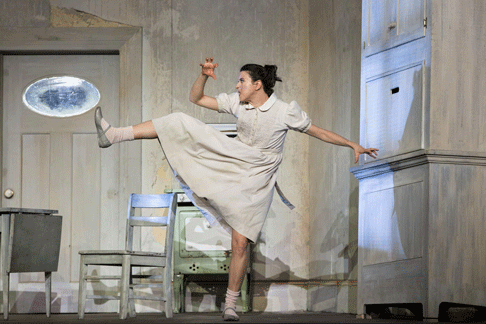 Lisette Oropesa as Gretel [Photo © Marty Sohl]
Lisette Oropesa as Gretel [Photo © Marty Sohl]
What kind of role best suits your voice?
I have said no to roles that are too high or too heavy. I feel that the best roles for me are lyric coloratura parts, a few Mozart and Handel roles, and a few French parts that are on the lyric end of true coloratura.
Which are your favorite roles?
I enjoy singing Violetta in La Traviata and Lucia di Lammermoor
the most. I like these roles because they are very fulfilling musically and dramatically. They are the epitome of bel canto and a true showcase for the soprano. They are also great characters to play because they both have incredible stories, and difficult circumstances. They live in an unfair society which dictates a lot of their struggle. I love playing both of these characters very much.
What important performances do you have coming up this season and next?
I've got debuts coming up that I'm excited about, such as the one at the Rossini Opera Festival in Pesaro. I will sing the title role in Rossini's Adina and I will make my debut at the Teatro la Fenice in Venice as La Traviata. I'm also really excited to be returning to the Paris Opera for L'Elisir d'Amore. It's my role debut.
How do you feel about the emergence of the stage director as a major force in opera?
I have learned a lot of incredible things about performance from stage directors, both for acting and movement, as well as interpretation. They are often like psychologists and can read you at the deepest level. I feel that I have done my best work because of directors who bring out those depths in all of us in the cast and we all inspire each other.
What recordings do you have out?
I released my first album, officially, last year. It's called Within/Without. It's available on iTunes and via my website; here's the link to it. https://lisetteoropesa.bandcamp.com/album/within-without
I did a Spanish set of Obradors, along with music by: Schubert, Haydn, Mendelssohn, Poulenc, and Barber, plus Meyerbeer for my encore aria.
Do you have other recordings coming out in the near future?
I'm working on releasing some more recital repertoire as downloadable tracks online.
What do you see yourself doing five years from now?
Hopefully the same things I'm doing now but with a few more new roles sprinkled in, such as Juliette, Puritani, and Manon.
How much modern technology do you use in your work?
Not that much really, I still use paper scores, highlighters, pencil and paper, and a piano. I do record myself with my iphone, marking through any hard bits in a part so I can memorize them. I also listen to recordings but I don't really rely heavily on them.
How do you feel about downloads replacing compact discs?
For opera recordings I'm thrilled to have so many resources available online! There is is a wonderful wealth of music out there available for us as singers. I have been bringing CDs to my recitals and it's nice for people to be able to walk away with a copy if they want one. I am also working to get the album available in opera gift shops. It's at the Met, Los Angeles Opera, Dutch National Opera, and Glyndebourne.
Do you ever have time for a private life?
Yes, my wonderful husband Steven travels with me and we have made our work homogeneous. He's a web developer, and his skills with technology have been irreplaceable in producing my recordings, creating and maintaining my website, photos, social media, and videos. We run together and cook together, and really are so happy in this life. He loves traveling and has found his stride in this career path with me. I'm so lucky!
Do you have any interesting hobbies?
Yes we love cooking, running, wine, and good old fashioned debate. We are vegan so we cook all kinds of incredible dishes from all different types of cuisines. Our favorites are Indian curries. We love to drink Burgundy wines, or wines from the state of Oregon such as Pinot Noir and Chardonnay. When we debate it's usually about big philosophical ideas that have no right or wrong answer. We try to solve the world's problems.
Maria Nockin
image=http://www.operatoday.com/Oropesa_Homa.png
image_description=Lisette Oropesa [Photo © Jason Homa]
product=yes
product_title=An Interview with Soprano Lisette Oropesa
product_by=By Maria Nockin
product_id=Lisette Oropesa [Photo © Jason Homa]
Barber of Seville Is Fun in Tucson
The Washington National Opera and Opera Omaha. His sets were replete with perspective, flowing red curtains painted on flat canvas, and three chandeliers that could be raised and lowered at will. No designer was credited for the attractive soft colored eighteenth century costumes.
The cast was entirely made up of young singers and the stage director was Joshua Borths, Arizona Opera’s director of education and community engagement. Borths kept everyone on stage in constant motion. Six non-singing actors playing servants and townspeople kept the movement constant even when the singers were rendering major arias. However, their antics drew a profusion of laughs from the Sunday matinee audience.
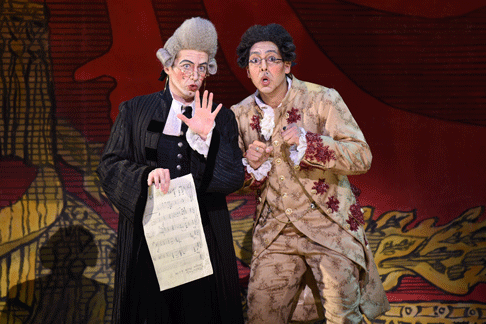
Baritone Jared Bybee was a sophisticated Figaro who seemed totally at home in his part and delivered his lines with the panache expected of the town hero. Without a padded costume to make him seem portly, bass baritone Calvin Griffin looked much too young and vital to be cast as the aging Dr. Bartolo. He sang with a young man’s energy, but his fast patter lines were lacking in volume.
Having heard a mezzo Rosina at Opera Santa Barbara on Friday evening, it was interesting to hear a soprano sing the role on Sunday Afternoon in Tucson. Katrina Galka was a kittenish, feminine Rosina who had no intention of marrying her elderly guardian. Best of all, she sang her coloratura lines clearly with silvery tones and great attention to Rossinian style. Tenor Anthony Ciaramitaro sang with a relatively large voice that was flexible enough to sing Rossini’s runs and decorations with ease. I am looking forward to hearing both Galka and Ciaramitaro again.
Stephanie Sanchez, a most amusing Berta with commanding low tones, thought Don Basilio would make her a good husband. The Don, played by Zachary Owen, thought otherwise, however, and he seemed much more interested in his men friends. A limber and energetic performer, Owen sang his venomous aria with good diction but was hard to hear in its faster passages.
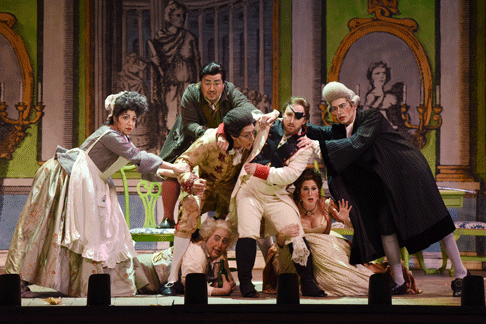
Jared Porter, Dale Dreyfoos and Jeffrey Stevens were amusing and helpful as Fiorello, Ambrogio, and the Notary while Daniel Prunaru was a serious Officer who pointed out class differences in that time and place. The men of Henri Venanzi’s chorus sang and cavorted wonderfully in this full-blooded rendition of Rossini’s most famous comic opera.
Under the leadership of Conductor Francesco Milioto, the orchestra played with high spirits and technical brilliance. Thanks to his brisk tempi, the comedy moved swiftly and joyously. The audience seemed delighted with the performance and responded with heavy applause for the artists.
Maria Nockin
Cast and production information:
Figaro, Jared Bybee; Rosina, Katrina Galka; Almaviva, Anthony Ciaramitaro; Dr Bartolo, Calvin Griffin; Don Basilio, Zachary Owen; Berta, Stephanie Sanchez; Fiorello, Jared Porter; Ambrogio, Dale Dreyfoos; Officer, Daniel Prunaru; Notary, Jeffery Stevens;
Conductor, Francesco Milioto; Director, Joshua Borths; Lighting Design, Gregory Allen Hirsch; Chorus Master, Henri Venanzi.
image=http://www.operatoday.com/Arizona-Opera_The-Barber-of-Seville_Tim-Trumble_21.png
image_description=Photo © Tim Trumble
product=yes
product_title=Barber of Seville Is Fun in Tucson
product_by=A review by Maria Nockin
product_id=Photos © Tim Trumble
Moody, Mysterious Morel
The piece is composed by Stewart Copeland (co-founder and drummer for The Police) to a libretto he wrote with Jonathon Moore. The surreal tale is based on La invención de Morel by Adolfo Bioy Casares. Being highly theatrical, the story is anything but linear. Impressions go back and forth in time, blurring reality, fantasy, truth and illusion.
There is a nice suspenseful build to the revelation of the exactnature of Morel’s “invention.” Character relationships are Pinteresque in their blurred details. Dr. Morel and his guests are on an island having an outing of some sort. Or are they really? A Fugitive happens upon the island from “somewhere.” Or has he? The Narrator figure is actually the Fugitive observing himself as he comments on the disordered episodes his doppelgänger experiences in real time. Got that? Or is it all in his head? Or ours? The creators turn time and space on their heads in this puzzling yet satisfying magical mystery tour.
![image[8].png](http://www.operatoday.com/image%5B8%5D.png) Nathan Granner and Jamie Chamberlin
Nathan Granner and Jamie Chamberlin
LBO was blessed with a superlatively talented cast. As the mirror image, co-dependent Fugitive and Narrator, baritones Andrew Wilkowske and Lee Gregory were uniformly superb. Mr. Wilkowske has a buzzy, commanding sound and he invests his interpretation alternately with a tormented heat and touching vulnerability that make his character very sympathetic. Mr. Gregory manages the feat of commenting powerfully and cogently on the actions even as he is forced to relive unutterably painful moments over and over again. Lee’s overwhelming, highly polished, emotion laden vocalizing was one of the production’s great glories.
As the Eternal Feminine character Faustine, Jamie Chamberlin offered some astonishingly limpid and secure singing, her shimmering soprano gleaming in all register and volumes. Ms. Chamberlin conquered al the demands of this rangy role, offering some jaw-dropping forays above the staff. Nathan Granner was a revelation as Dr. Morel, lavishing his every phrase with an effortlessly produced lyric tenor that had substantial, gold-infused weight. Mr. Granner was fearlessly accurate in his easy execution of passages lying so high they threatened to live where only dogs can hear.
As the guests “along for the ride” in this surreal happening, Cedric Berry was a solid, suave, warm-voiced Stoever; Doug Jones clearly relished his sturdy double duty as Alec and Ombrellieri; Suzan Hanson was an alluring, silver-toned Dora; and Danielle Marcelle Bond deployed her rich, plummy mezzo to fine effect as the Duchess.
Jonathon Moore directed a wonderfully varied, purposefully spare, exquisitely stylized production. The total use of the space, the dropped hints of the character identities, the inexorable path to a cataclysmic denouement, all were beautifully realized. While each of the performers made the roles their own, Mr. Moore’s greatest gift may have been in forging an ensemble that was tireless in its unified purpose. The director was certainly aided mightily by the design team.
Alan E. Muraoka’s set design consisted of a large platform placed in the middle of a thrust configuration, capable of being under lit, over lit and every sort of “lit” by David Jacques, whose lighting was a wondrous mix of overall atmospheric washes, variegated colors, and telling specials. Back to Mr. Muraoka, his stylized upstage hanging suggested a skeletal seaside colonnade, and I enjoyed the mid stage platform that rose and fell to become, among other things, a dining table. The careful selection of simple set pieces that could be added or subtracted by a commendable corps of supers was all that was needed to make the effects required.
The highly effective video design from Adam Flemming did yeoman’s work in effectively establishing the mood and clarifying the action. Jenny Mannis’ diverse costumes encompassed both distressed peasant wear and wealthy chic with equal success. Bob Christian’s reliable sound design was occasionally a bit too “present.”
![image[13].png](http://www.operatoday.com/image%5B13%5D.png) Doug Jones, Danielle Marcelle Bond, and Suzan Hanson
Doug Jones, Danielle Marcelle Bond, and Suzan Hanson
Conductor Andreas Mitisek led an assured reading of this knotty score, and his orchestra, sequestered stage right played with enthusiasm and commitment. Maestro clearly believes in this (and other) new work, and his dedicated leadership invested the evening’s music making with passion and clarity. So, what about the work itself?
If you like your opera tuneful and lush, you will probably find yourself at the wrong address. Mr. Copeland seems to relish rhythmic motifs more than lyric motifs, although they do occur. Vocal writing is most often suitably angular. The churning, forward musical motion rarely relaxes, but it is quite fascinating in its insistence. There are indeed also moments of serene, layered, ethereal repose that are all the more effective for the aural chaos that precedes them.
The percussive effects are many, and occasionally obscure the singing, and pretty much the rest of the orchestra. A bit of restraint in the “thunder and lightning” would likely benefit the overall result. Perhaps Maestro Mitisek could impose some volume control in coming performances. I do wish that Faustine had been given an entrance arioso to help establish her magnetism that is so important to the story thread.
That said, there is no doubt that the writing admirably serves the script in weaving an absorbing look into a specific, inscrutable tale that was staged with utmost care and dedication. While this piece may never bump your favorite Puccini off the play list, it is an important and intriguing new work that deserves attention.
James Sohre
Cast and production information:
The Invention of Morel
Music by Stewart Copeland
Libretto by Jonathan Moore and Stewart Copeland
Based on La invención de Morel by Adolfo Bioy Casares
Fugitive: Andrew Wilkowske; Narrator: Lee Gregory; Faustine: Jamie Chamberlin; Morel: Nathan Granner; Stoever: Cedric Berry; Alec/Ombrellieri: Doug Jones; Dora: Suzan Hanson; Duchess: Danielle Marcelle Bond; Conductor: Andreas Mitisek; Director: Jonathan Moore; Set Design Alan E. Muraoka; Lighting Design: David Jacques; Video Design: Adam Flemming; Costume Design: Jenny Mannis; Sound Design: Bob Christian
image=http://www.operatoday.com/image%5B7%5D.png image_description=Suzan Hanson and Nathan Granner [Photo © Kip Polakoff] product=yes product_title=Moody, Mysterious Morel product_by=A review by James Sohre product_id=Above: Suzan Hanson and Nathan GrannerPhotos © Kip Polakoff
Acis and Galatea: 2018 London Handel Festival
However, in the light of this accomplished performance at St John’s Smith Square, one of first events of this year’s London Handel Festival, perhaps such enthusiasm can be indulged. After all, Winton Dean described the final aria, which expresses the transfiguring effect of Galatea’s love and loss, as ‘one of the most sublime things Handel ever wrote’ ( Handel’s Dramatic Oratorios). The work was popular in Handel’s day, and remains so, judging by the capacious and appreciative audience at St John’s.
This year’s festival is titled Handel in London. Since Handel, who settled in the capital in 1712 and became a naturalised citizen fifteen years later, spent most of his working-life in London there are plentiful works from which to choose. But, the Festival also aims to explore the wider social context of Georgian London, and Acis and Galatea is a good place to start. For, it not only represents the young Handel’s attempts to enchant native audiences suspicious of foreign art forms and styles, but also, through the comic satire of John Gay’s libretto which abounds with contemporary references, throws light on the cultural politics of the period.
Commissioned by James Brydges, Earl of Carnavon and later Duke of Chandos, Acis and Galatea had its first performance sometime between 1718-20 at Cannons, the stately home on the grand Middlesex estate where Brydges maintained a group of musicians for his chapel and private entertainments. Gay adapted Dryden’s translation of Ovid and threw in a sprinkle of quotations from and allusions to John Hughes and Alexander Pope.
Ignoring the advice of the pragmatic Damon, two besotted lovers - shepherd Acis and sea nymph Galatea - relish their pastoral seclusion. Their bucolic happiness is, sadly, but brief, brusquely disturbed by the smitten cyclops, Polyphemus, whose raging jealousy and rampant passion have tragic consequences. Fortunately, Galatea’s love effects a divine metamorphosis: the murdered Acis, whom Polymethus has crushed with a rock, is transformed into a crystal stream which fountains from the rock.
Under Laurence Cummings’ elegant direction, the London Handel Orchestra and the nineteen singers of Pegasus complemented the vocal solos stylishly. The orchestral colourings were shrewdly highlighted by Cummings, with David Miller’s theorbo contributions providing particularly well-judged rhetorical enhancement. Tempos were swift enough to conjure lightness of spirit, but never too fast for the emotional import to be lost.
Cummings was willing to let the music speak for itself, nowhere more so than in the final hushed chorus, ‘Mourn all ye muses’, the graded diminuendo of which evoked a tender but profound Purcellian pathos, equal to the close of Dido and Aeneas upon which Handel draws. Similarly, the interlacing of the stricken Galatea’s pained questions - ‘Must I my Acis still bemoan/ Inglorious, crush’d beneath that Stone … Must the lovely charming Youth/ Die for his Constancy and truth?’ - the oboe’s plaintive melodic echoes, and the consoling choral responses - ‘Cease, cease, Galatea, cease to grieve’ - was beautifully shaped. And, the orchestral dotted rhythms that represent Acis’ ‘resurrection’ and continuing presence in the burbling stream were intimated with delicacy. Handel certainly doesn’t come much better than this.
As Galatea, Lucy Page sang with a fresh, clean soprano, sweeping sweetly across the registers though not always projecting strongly. Nick Pritchard’s tenor is rich and refined; Acis displayed both romantic ardour and, in his martial aria in Act 2, heroic potential.
Edward Grint made an impressive entrance through the red curtains behind the instrumentalists, bristling with fury. But, even in Polymethus’ first recitative, ‘I rage, I rage, I rage, I melt, I burn’, Grint’s bass balanced ballast and beauty - ‘I melt’ was beguilingly languorous: it was clear why the Cyclops fancied his chances with the nubile nymph. With paradoxical elegance, Grint negotiated the ungainly vocal contours and stuttering breathless which so often characterises the giant’s melodies, Polymethus’ unrest being sweetly countered by the obbligato ‘flauto’ (Catherine Latham, recorder) in the well-known ‘O ruddier than the cherry’. Similarly, the leaping octaves - ‘Torture, fury, rage, despair’ - with which the cyclops interrupts the lovers’ mournful duet were cleanly articulated and prickled with frustration.
Tenor Jorge Navarro Colorado, whom I have not previously heard, displayed a pleasingly mellow tenor and relaxed stage presence. Damon’s second aria, ‘Consider fond shepherd’, was beautifully sung, the top light but true.
This was a staged performance and as, upon entering St John’s, I wheezed through the eddying dry-ice smoke in a haze of lurid pink and green, I had slight misgivings about what might be in store. In the event, the pastoral partying was of a tame, traditional nature. Though Miles Fisher’s lighting provided a rainbow of hues from satanic crimson to elysian gold, the design was quaint rather than quirky. A criss-cross canopy of silken scarves foreshadowed the concluding watery transfiguration and green helium balloons bobbed over the orchestral players (obscuring the singers when they were positioned at the rear), whose music-stands were festooned with Arcadian foliage. Alongside conventional pastoral apparel, Galatea’s dress was a briny green; Polymethus’ fur conveyed his brutishness.
St John’s is no easy venue in which to present staged works. The lovely acoustic is tempered by poor sightlines and intrusive pillars. Director Martin Parr sought to overcome the limitations by employing varied entrance points, shifting soloists from left to right and moving the chorus around the venue, including the gallery. Unfortunately, Parr repeatedly instructed his soloists to deliver their arias from a sitting or prone position, thus rendering the protagonists invisible to all but those seated in the first few front-rows.
The result was that this was less of ‘staging’ of Acis and Galatea than a performance with gimmicks. Laurence Cummings was drawn into the fun. First evicted from the harpsichord by Damon, his score tossed into the air, then required to provide the gallant Acis with his sword, Cummings also turned to the nave to give the chorus their cue to release a shower of balloons from the gallery during the end-of-Act 1 chorus, ‘O happy we’ (some in the audience seemed more interested in batting the balloons back and forth than in listening to the musical accompaniment to the air-borne ballet). As the two-Act serenade was performed without a break, there was no opportunity for a balloon-gathering foray; the result was repeated explosive bursting throughout Act 2, painfully disrupting moments of emotional weight, not least Damon’s Act 2 aria and Galatea’s final aria of transformation.
My reservations had begun when it seemed that the sopranino recorders had not been not trusted to evoke the ‘warbling quire’ which Galatea dispatches to fetch her beloved Acis, and during the nymph’s plea, the chorus dangled and waggled paper ducks from fishing rods. As I recalled childhood visits to fairgrounds and endeavours to ‘hook the duck’, the mannered order of Arcadia seemed far away.
I’m probably guilty of humourlessness and many undoubtedly enjoyed the antics. Admittedly, there is much irony in Gay’s text, with its parodic echoes of nonsensical Arcadian conceits and interplay of ‘high’ and ‘low’. But, to me, Handel’s music is sincere, and the challenge is to distinguish between, and marry, textual levity and musical earnestness. Interestingly, when Handel presented a London performance of Acis and Galatea in 1732 it was announced that ‘There will be no action on the stage’. As Hawks observes, the serenade is ‘no shallow soap opera, but a deep exploration of emotions and psychology’. Fortunately the musicians and singers concurred.
The London Handel Festival continues until 17th April 2018.
Claire Seymour
London Handel Festival 2018
Handel: Acis and Galatea HWV49
Acis - Nick Pritchard, Galatea - Lucy Page, Polyphemus - Edward Grint, Damon - Jorge Navarro Colorado; Director - Martin Parr, Conductor - Laurence Cummings, Costume designer - Charlotte Epsiner, Lighting designer - Jack Weir, London Handel Orchestra, Pegasus Choir.
St John’s Smith Square, London; Monday 19th March 2018.
image=http://www.operatoday.com/Lucy%20Page%20Robert%20Workman.png image_description=Acis and Galatea: London Handel Festival, St John’s Smith Square product=yes product_title=Acis and Galatea: London Handel Festival, St John’s Smith Square product_by=A review by Claire Seymour product_id= Above: Lucy Page (Galatea)Photo credit: Robert Workman
March 20, 2018
Oriana, Fairest Queen: Stile Antico celebrate the life and times of Elizabeth I
The vocal ensemble was at its best in the items that brought all twelve voices together in a mellifluous but rich-grained blend. The ebbing swells of Byrd’s and Tallis’s polyphonic glories, the plaintive rhetoric of Dowland’s lute conceits, the jubilant majesty of the madrigalian homages of Wilbye and Weelkes: diverse musical worlds and expressive contexts were rendered with equal assurance and accomplishment.
More florid contrapuntal excursions, or episodes where the texture was sparser and the musical arguments flew thick and fast, were not always so persuasive. Such moments were full of vitality but occasionally the intonation of the soprano line did not stay wholly tethered to the bass. And, in the items requiring smaller forces not all the singers seemed equally at home with a more soloistic role, though others relished the opportunity to engage directly with the audience.
The concert might have been as aptly titled ‘Music for Troubled Times’ as ‘Music for A Golden Age’. For, as Catholic recusants such as William Byrd knew well, patronage and propaganda, art and politics, were never far apart. Byrd’s Anglican anthem, ‘O Lord, make thy servant Elizabeth our Queen’, was probably written when Byrd was the organist at Lincoln Cathedral and it’s easy to imagine that its rich counterpoint embodies the hopefulness of the young composer. The vocal entries were clearly but sensitively marked, and there was a lovely expansiveness through the second line of appeal, ‘Give her her heart’s desire and deny not the request of her lips’, the cadence piquantly pointed by chromatic inner voices. The warm, glowing ‘Amen’ perhaps the conveyed the confident, grateful and affectionate sentiments of a composer in a prominent but precarious position, towards his monarch, patron and protector.
The cessation of Catholic services in 1549 and 1559 made the Latin motet, in the words of Joseph Kerman, a ‘major art-form under peremptory death sentence’. But, while extinction might have seemed the likely prospect for the motet following the Act of Uniformity, or Elizabethan Settlement, which marked the accession of Queen Elizabeth, the continued strong influence exerted by the music of the Continent and the artistic sang-froid of English composers in response to successive religious revolutions - Elizabeth I was the fourth monarch to rule England in Thomas Tallis’s lifetime - ensured that Latin motets, often setting non-liturgical texts or performed in private homes, continued to be composed. Indeed, Kerman suggests, ‘one might argue the proposition that the Latin motet remained the richest form of English music until as late as 1590’. [1]
Certainly, ‘Attollite portas’ by Byrd (who was just sixteen years-old when Elizabeth ascended to the throne) and Tallis’s ‘Absterge Domine’ provide evidence of the richness Kerman describes. Byrd’s motet had both breadth and brightness - I’d have liked even more soprano lustre - but the rhythmic and textural freedom proved a challenge at times. Stile Antico seemed to find Tallis’s piling penitential entries at the start of ‘Absterge Domine’ more natural ground for their timbral coherence and they built compelling energy through the text’s driving expression of devotion - ‘nam tu es Deus meus, tibi soli fidit anima mea’ (for thou art my God, my soul hath faith in thee alone) - enjoying, too, the false relations and chromatic nuances which perhaps betray the motet’s origin in an instrumental fantasia.
Musicologists have oft commented on the mutually beneficial interchange between Tallis, Byrd and Alfonso Ferrabosco the Elder, the latter having risen to a high level in the musical court of Elizabeth. (It has also been suggested that he was the queen’s spy: when imprisoned in Italy, accused of murder, treason and practising Catholicism, it was the intercession of Catherine de’ Medici and Elizabeth I that secured his release.) Ferrabosco’s psalm-settings ‘Exaudi Deus orationem meam’ (SATTBB) and ‘Ad Dominum cum tribularer’ (SSTTB) - sung here by six and twelve singers respectively - shared melodic breadth and linear fluency with the preceding Byrd anthem and motet. A pleading urgency marked the opening of the former, while ‘Ad Dominum’ was invigored by strong forward momentum which underpinned textual intensity.
Secular chansons and villanelles from the Continent provided variety of mood, texture and language. The threads tying Orlande de Lassus’s ‘Madonna mia, pietà’, Adrian Willaert’s ‘Vecchie letrose non valete niente’ and ‘Doulce memoire en plaisir consommée’ by Pierre Sandrin (or Regnault) to the Elizabethan court may be tenuous - the programme note suggested that the Winchester Partbooks in which the three songs are found may have been a gift from to Elizabeth from Erik XIV of Sweden, one of the Queen’s many suitors in marriage [2] , though the works themselves exist in sources dating from 1555, 1545 and 1537 respectively - but this made them no less musically appealing. The four-voice texture of ‘Madonna mia’ freshened the palette after the denser English motets and the text was vividly interpreted - the homophonic pronouncement, ‘Vostra altiera beltà, sola infinita’ (Your lofty beauty, unique and boundless’), had a lovely intensity - though the intonation was not consistently secure. The spiteful vulgarity of ‘Vecchie letrose’ - which castigates ‘spiteful old hags’ who are ‘murderous and mad!’ - was delivered with light-hearted directness by two tenors and two basses, whose springy syncopations had delightfully parodic grace. The simple melancholy of Sandrin’s plaint for lost love was beautifully evoked but the quartet were less successful in capturing the Gallic tint of the text.
The twelve singers came together again for John Dowland’s ‘Now, O now I needs must part’, which unfolded a little too languorously for this listener (the cadential rhythmic suspensions did not have quite enough insistent, tugging impact) but which was beautifully hushed in tone. I liked the injection of power in the second stanza, thus complementing the dialectical text which first impresses the impossibility of recapturing lost joy now that love has been divided, but then asserts that, in fact, affection is not destroyed by absence and will survive until Death itself intervenes. Baritone Will Dawes assumed the melodic line in the final stanza, his delicate decorations both vivid and tasteful, and his tone tenderly beautiful. ‘Can she excuse my wrongs’ was sung by a vocal quartet and was compellingly rhetorical, the individual voices freely exploring the syncopated gestures, held together by a strongly rooted bass line.
Not surprisingly, two madrigals from The Triumphs of Oriana - the collection of 25 works by 23 composers which Thomas Morley published in 1601 - concluded the programme, with the ensemble uniting once more for John Wilbye’s ‘The Lady Oriana’ and Thomas Weelkes’ ‘As Vesta was from Latmos hill descending’. These was a true sense of scale and majesty as Stile Antico relished Wilbye’s repetitions and sequences, while Weelkes’s unapologetic word-painting - ‘descending’, ‘ascending’ and ‘running’ phrases fulfilling their descriptors, and the departure of the shepherds’ swain, ‘First two by two, then three by three’, being texturally represented - was obviously enjoyed.
The twelve singers were at ease in each other’s musical company and warmly engaged in their collective music-making. The presentation and choreography of the concert was professional and slick, though the note-pitching at the start of each item seemed overly fussy … perhaps the group were distracted by the atypical interruption of the prefatory commentary of the BBC radio presenter which necessitated repeated short delays in between the musical numbers.
This was a varied and uplifting concert: just what was needed to rebuff the unseasonal chill of the tenacious ‘Beast from the East’ which has revisited London in recent days. Wigmore Hall was bursting to the seams and the programme offered something to suit every predilection. We were offered an encore, too - ‘Gaudete in Domino’ by Giaches de Wert - which demonstrated the composer (1535-96) to be a master of the Franco-Flemish school, though I’m at a loss as to what a composer who spent most of his active career in service to the Gonzaga dukes in Mantua has to do with the Virgin Queen.
I’d have preferred to leave Wigmore Hall with my ears ringing with Weelkes’ dazzling contrapuntal conclusion, the infinite explorations of ‘Long live fair Oriana!’ seeming to embody both the Queen’s unassailable spirit and the unbounded optimism of the age.
Claire Seymour
Stile Antico
Byrd - ‘O Lord make thy servant Elizabeth’; Tallis - ‘Absterge Domine’; Byrd - ‘Attollite portas’; Lassus - ‘Madonna mia pietà’; Willaert - ‘Vecchie letrose non valete niente’; Sandrin - ‘Doulce memoire en plaisir consommée’; Ferrabosco - ‘Exaudi Deus orationem meam’, ‘Ad Dominum cum tribularer’; Dowland -‘Now, O now I needs must part’, ‘Can she excuse my wrongs’; Wilbye - ‘The Lady Oriana’, Weelkes - ‘As Vesta was from Latmos hill descending’.
Wigmore Hall, London; Monday 19th March 2018.
[1] Joseph Kerman, ‘The Elizabethan Motet: A Study of Texts for Music’, Studies in the Renaissance Vol.9 (1962), pp.273-308.
[2] This argument was first proposed by Kristine K. Forney in ‘A Gift of Madrigals and Chansons: The Winchester Part Books and the Courtship of Elizabeth I by Erik XIV of Sweden’, The Journal of Musicology Vol.17, No.1, (Winter, 1999), pp.50-75.
Photo credit: Marcus Borggreve
March 17, 2018
Daniel Kramer's new La traviata at English National Opera
English National Opera 's previous production, Peter Konwitschny's stripped down, anti-romantic and dystopic view very much failed the second requirement by not attracting wider audiences. So artistic director Daniel Kramer 's new production had quite a lot riding on it. Kramer's vision proved to be vividly eager to please, with over-the-top party scenes, but also an interesting take on Violetta's journey.
A co-production with Theater Basel where has already debuted, English National Opera premiered the new production of Verdi's La traviata on Friday 16 March 2018, Daniel Kramer directed and Leo McFall conducted, sets were by Lizzie Clachan and costumes by Esther Bialas , lighting by Charles Balfour and choreography by Teresa Rotemberg. Irish soprano Claudia Boyle sang Violetta with South African tenor Lukhanyo Moyake as Alfredo, making his UK debut. Veteran baritone Alan Opie sang Germont, a role he first sang in 1988 and marking his fiftieth year singing with the company!
Leo McFall conducted a lithe and shapely account of the prelude (with the curtain down), and then we launched into Act One. Kramer and his team set it in a sort of 1930s bordello, all mirrored walls and hyper-active staging, this party was desperate to please. Whilst the style was loosely 1930s, with plenty of Weimar Republic-style references in the staging, Violetta's costumes throughout were of a different era (more 1940s) rather setting her out from her contemporaries. For Act Two we moved to a plain, stripped down stage, just a swing, grass and a flower bed, but with Flora's party, we reverted to the style of Act One. During this latter party, mattresses were in evidence, and these re-occurred in the last Act, laid out regularly and evoking graves. At the front, Violetta was digging her own grave.
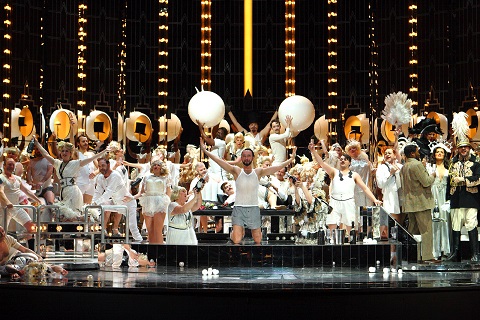 ENO cast and chorus. Photo credit: Catherine Ashmore.
ENO cast and chorus. Photo credit: Catherine Ashmore.
Kramer's production was far too inclined to tell us what to think, rather than allowing us to make our own decisions. The party scenes were desperately insistent, but more worrying was the emphasis on death. In Act Two scene one, the flow bed could be read as a grave and Violetta gathers flowers, Ophelia-like, and at one point hides herself beneath the turf. Then at Flora's party, the women's make-up seemed to evoke the Mexican day of the dead, and of course, in the last act, we had Violetta digging her own grave in the cemetery. One idea would be interesting, but all of them together became rather too much.
Soprano Claudia Boyle has formerly sung Leila in The Pearl Fishers and Mabel in The Pirates of Penzance at ENO, and Violetta is a big leap but she has also been on the young artist programme at the Salzburg Festival. The staging in Act One was very unhelpful both to her and Lukhanyo Moyake's Alfredo, the chorus was visually and aurally too dominant so that Kramer seemed to be blurring the boundaries between solo and ensemble, but this meant Boyle's contributions were insufficiently spot-lit. For the great Act One finale, she showed sparkling style with the coloratura, but the desperation present in her acting did not quite connect with her singing but this is something which will come. Lyric sopranos tend to find the subsequent acts of La traviata difficult as they require remarkable reserves of strength. Whilst never displaying a lyrico spinto amplitude, Boyle developed a remarkably wiry sense of strength. The scene with Alan Opie's dignified and beautifully detailed Germont certainly raised the level of intensity, with the feeling the veteran singer urging Boyle to greater dramatic heights. She coped heroically with the final act's dramatic requirements and created a genuine sense of Violetta's illness. In fact, this was a noticeable thread running through the opera, we very rarely forgot that Violetta was ill, even in the pastoral moments at the start of Act Two. This was a promising role assumption, with the sense that there will be striking developments to come as Boyle's experience with the role develops.
Lukhanyo Moyake was South Africa's representative in the 2017 BBC Cardiff Singer of the World, and he has been singing with Cape Town Opera Company since 2010. He has a robust tenor voice and an engagingly puppyish stage presence. His Alfredo was a naive countryman (distinguished by his clothing from the sophisticated party-goers), thankfully lacking the feeling of idiocy which bedevils some performances. His singing had remarkable power, and though there were one or two rough edges and an occasional steely top, this was a finely engaging performance. You feel that the voice is moving towards spinto territory, and Moyake's performance had a wonderful generousness to it, allied to a vibrancy of tone. He is definitely someone I would like to hear more of, and his English was creditably comprehensible.
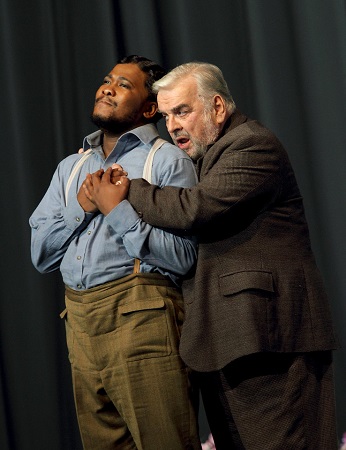 Lukhanyo Moyake and Alan Opie. Photo credit: Catherine Ashmore.
Lukhanyo Moyake and Alan Opie. Photo credit: Catherine Ashmore.
Alan Opie (celebrating his 73rd birthday later this month) was simply remarkable as Germont. There was little feeling of age in the voice and a wonderful sense of the experience behind the performance. This was a finely subtle account of the role, we lacked the determined martinet which has been in evidence in other recent productions, instead Opie's Germont was someone with different expectations the scene with Boyle's Violetta was a fine example of two different views coming together, and each singer showed how, as the scene progressed, their character was forced to re-assess the other. Opie's Germont was relatively understated, but each gesture whether vocal or physical told volumes. This was a fine ensemble performance, one which through craft and experience lifted the general level of the drama.
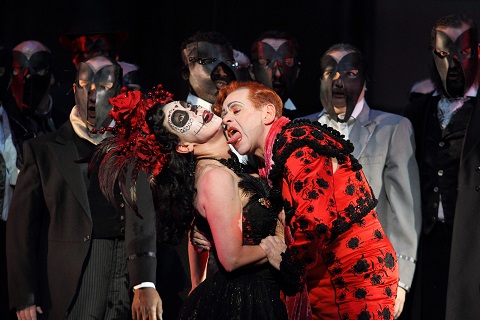 Heather Shipp and Aled Hall. Photo credit: Catherine Ashmore.
Heather Shipp and Aled Hall. Photo credit: Catherine Ashmore.
Heather Shipp made a strong impression as Flora, rising above some unflattering make-up in Act Two and managing to bring out a sense of care for Violetta despite the determinedly 'sexy tart' depiction of the character. The men were strongly cast but rather depicted as types rather than characters. The biggest impression was made by Aled Hall as Gaston thanks to a series of outrageous costumes, but there was good support from Benjamin Bevan as the Baron, Bozidar Smiljanic as the Marquis and Henry Waddington as Doctor Grenvil. Martha Jones gave a powerfully characterised performance as Annina, without ever over-dominating the scene, and I hope to hear more of her.
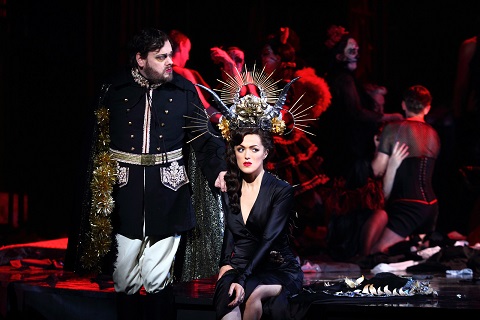 Benjamin Bevan and Claudia Boyle. Photo credit: Catherine Ashmore.
Benjamin Bevan and Claudia Boyle. Photo credit: Catherine Ashmore.
The chorus did everything required of them, entering into the party hi-jinks with a will and there were no additional dancers for Flora's party scene. Whatever you thought of the production, the chorus performance was a real tour-de-force. The two small Act Two roles, Joseph and the messenger, were provided admirably by chorus members Pablo Strong and David Campbell.
Leo McFall drew a fine-grained performance from the orchestra. Highly fluid with plenty of rubato, McFall also kept things moving and Act Two (the longest of the three acts) flew by without ever seeming pushed. This was a very modern take on the piece, clean and lithe, but one which did not eschew tradition either and drew very fine playing from the orchestra.
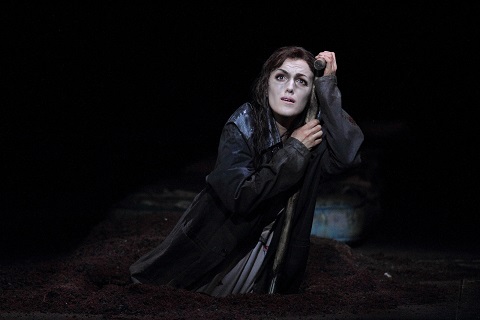 Claudia Boyle. Photo credit: Catherine Ashmore.
Claudia Boyle. Photo credit: Catherine Ashmore.
Kramer's production ultimately seemed a little too eager, too desperate to please and there were moments when you wanted it to calm down a little. The result is promising, if Kramer is willing to allow the piece to develop, and I certainly feel that as the run progresses the performances from Claudia Boyle and Lukhanyo Moyake will continue to grow and deepen, aided by the remarkably generous performance from Alan Opie.
Robert Hugill
Verdi La Traviata
Violetta - Claudia Boyle, Alfredo - Lukhanyo Moyake, Germont - Alan Opie, Dr Grenvil - Henry Waddington, Viscount Gaston - Aled Hall, Baron Bouphol - Benjamin Bevan, Marquis - Božidar Smiljanic, Flora Bervoix - Heather Shipp, Annina - Martha Jones;
director - Daniel Kramer, conductor - Leo McFall, set design - Lizzie
Clachan, costume design - Esther Bialas, Chorus and Orchestra of English
National Opera.
English National Opera at the London Coliseum; 17th March 2018.
Photo credit: Catherine Ashmore
March 16, 2018
Haydn's Applausus: The Mozartists at Cadogan Hall
In this concert at Cadogan Hall, the programme was devoted singularly to Haydn who in 1768 received a commission from a Cistercian monastery in the northern Austrian town of Zwettl, for an Applausus cantata to celebrate the fiftieth anniversary of the ordination of their Abbot, Raynor I. Kollmann.
Haydn would have known what was expected of him: as the name implies, an Applausus cantata was designed to laud and applaud a worthy individual, and commonly took the form of a series of recitatives and da capo arias, à la opera seria. The Latin text (presumably written by one of the Abbot’s Cistercian brothers, and in this case more of an extended poem than a libretto) of Haydn’s Applausus Jubilæum Virtutis Palatium is sung by four allegorical Virtues - Temperance, Prudence, Justice and Fortitude - who are guided and encouraged by the measured words of the wise Theologia as they extol the pietistic life within the establishment and take turns to praise their honoree. The vocal soloists are accompanied by an orchestra of strings, oboe, bassoon, two horns, trumpet, and timpani, with harpsichord obbligato.
Occupied by his duties at Esterházy, Haydn was unable to attend either rehearsals or the performance, which took place on 15th May, of the commissioned cantata and so sent a memorandum enumerating his wishes about its production. Some instructions were of a practical nature: should two violin parts be required (an indication of Haydn’s expectations about the likely size of the instrumental forces) the copyist must ensure that the page-turns were arranged differently in each part to avoid half of the fiddle section falling silent at the same time. Elsewhere the composer offered musical mandates: the allegros should be played ‘a bit more quickly than usual’, fortes and pianos should be ‘observed exactly’, and violinists should avoid their frequent, and in his view lamented, practice of articulating tied notes.
This fascinating and valuable historical document - reproduced in the evening’s progamme booklet - has received rather more attention than Haydn’s score itself. For, the acclamatory sentiments of the extended arias - some lasting almost twenty minutes - and the absence of dramatic or narrative impetus, might make Applausus seem like heavy weather for all but the most enthusiastic devotee of opera seria or cantatas.
In an introductory note in the programme, Ian Page poses some sensible questions and provides thoughtful answers. Does it matter that an aria is long and repetitive, if the music is beautiful? If we hear the same line of text many times, does it affect the way we respond to its meaning? Page suggests that as ‘the work has virtually no plot’ the listener should ‘banish any expectations of story or narrative’ and allow him/herself to be transported by the ‘meditative nature of the music’: to become captivated - as Page and his singers had been during rehearsal - by the ‘slow-burn grip’ of the ensembles and arias which ‘pulled us into an enchanting and uplifting reverie’.
Given that there are almost two hours of music, that the text is in abstruse Latin which might perplex even the most able classicist, and that modern audiences are unlikely to share the Cistercian brethen’s taste for moralising laudation, Page issues quite a challenge to the average listener’s powers of concentration! Reverie can quite easily slip into day-dream.
However, the elegant and gracious vocal and instrumental performances that we enjoyed at Cadogan Hall offered plentiful prompts if attentions were prone to wander or wane. Page had obviously taken a great deal of care over the preparation of this performance, not just in terms of attentiveness to Haydn’s specific instructions and the observance of an idiomatic performance style and expressive aesthetic, but also with regard to the musical details of the score itself, many of which were clearly cherished. I felt that, somewhat surprisingly, this especial care was often most persuasively evident in the accompanied recitatives in which instrumental details engaged beguilingly and bewitchingly with the vocal lines - the latter combining textual nuance with declamatory effect, to hint at a specifically dramatic textual energy sometimes absent elsewhere. Accompanied by perfectly tuned violin scurrying, Fortitudo assured Justitia, ‘The sneers of your enemies are held in low esteem here’; Prudentia’s rich-toned celebrations of the delights and wisdom of the Palace were given addition weight by the well-shaped arguments of Luise Buchberger’s cello. Page’s direction of these recitatives was excellent: authoritative but admitting personal expression from his superb instrumentalists.
The helpful acoustic of Cadogan Hall also enhanced the clarity of the orchestral textures and the expressive impact of the inner voices within that texture. The Allegro di molto of the two-movement overture alertly balanced bright violins with nasal brass and wind, and the dynamic contrasts and nimble finger-work of this opening contrasted with the delicate beauty of the ensuing Andante molto. No wonder the Virtues were full of wonder ‘at the beauty of their Palace, an admiration expressed in the opening Quartet, ‘Virtus inter ardua’, sung by Temperantia (Ellie Laugharne), Prudentia (Elspeth Marrow), Justitia (Thomas Elwin) and Fortitudo (John Savournin) in which the soloists’ voices blended warmly, and Page made much of the harmonic arguments.
Haydn must have been assured that there were five talented singers in Zwettl and its environs, as he requires his soloists to deliver both affecting melodic grace and coloratura sparkle. The tenor role of Justinia was performed by a singer well-known to Haydn and who was entrusted to direct the rehearsals: for his efforts, he was rewarded with two exquisite arias, whose potential ‘long-windedness’ is alleviated by a mini-concerto for harpsichord (at the close of ‘O pii Patres Patriae!’) and a charming violin obbligato (in ‘O beatus incolatus!’), here performed with technical assurance and convincing stylish grace by Steven Devine and leader Daniel Edgar respectively. The former aria was strengthened by lovely woodwind playing and Page’s keen seen of the rhythmic discourse between steady tread and syncopation, but some momentum was lost. Tenor Thomas Elwin did not always make the extended melodic gestures cohere, but his tone was appealing and ‘O beatus incolatus’ was characterised by greater fluency of line and persuasive expressive intensity.
John Savournin’s energised rendering of Fortitudo’s shorter ‘Si obtrudat ultimam’ (If destiny should swallow us up) made a case for the less-might-have-been-more argument: the contrast between the buoyant top and dark bottom of his bass-baritone, coupled with the furious momentum garnered by leaping octaves and striking accents in the accompaniment, and the cello’s continuous racing against the oboe’s interjections, made for real excitement and interest.
At the first performance the soprano parts were taken by ‘two boys’ - Haydn’s letter of instruction shows that he trusted his experienced tenor to offer these young singers appropriate guidance - but here soprano Ellie Laugharne and mezzo-soprano Elspeth Marrow stepped into the shoes of Temperance and Prudence, initially joining forces in a delightful duet which, despite lying quite low in the voice for both singers, was well-projected and further enhanced by gentle trumpet colouring. Of all the soloists, Laugharne appeared most engaged in the unfolding sentiments of the work, and in her aria, ‘Rerum, quas perpendimus’, she made light of the virtuosic demands, engaging intelligently with the horns and cello to suggest a real musical conversation. Laugharne’s vocal commitment did not flag for one moment in this twenty-minute stamina-challenge; nor did her judgement - the chromaticism of the B section was thoughtfully exploited and the trills judiciously brief. No wonder, despite the silent respect shown elsewhere, the audience felt compelled to applaud.
David Shipley took a while to warm up in Theologia’s first admonition to the over-adulatory Virtues but after an initial slightly inhibited tone and lack of melodic elegance, the bass found greater ease of projection and vocal presence.
We can’t know what Haydn though would come of this ‘occasional’ work. But, some of the music was plundered subsequently, with sacred texts replacing the original secular words to render it suitable for church services. Thereafter, Applausus languished in the margins of music history, until in 1958 Haydn scholar H. C. Robbins Landon and conductor Harry Newstone reintroduced the cantata to audiences via a BBC series titled The Unknown Haydn, Newstone conducting the Haydn Orchestra with a solo quartet comprising Joan Sutherland, Marjorie Thomas, Richard Lewis and John Cameron. The Boston Symphony Orchestra, under Erich Leinsdorf, gave a full performance at Tanglewood in 1964; and, there have been three commercial recordings to date, including a 1991 modern-instrument recording led by Patrick Fournillier on Opus 111.
In giving the first live UK-performance, The Mozartists/Classical Opera offered both musical pleasure and food for thought. Though the absence of narrative momentum occasionally led to a sense that Haydn’s invention was cruising on autopilot, and though in the extended arias the relationship between the sentiments of the text and their musical embodiment threatened at times to disappear, this was a performance which skilfully and expressively communicated the solemnity, sensitivity and sublimity of Haydn’s varied score.
Claire Seymour
Haydn: Applausus
The Mozartists: Ian Page (conductor), solo violin (Daniel Edgar), solo harpsichord (Steven Devine).
Temperantia - Ellie Laugharne, Prudentia - Elspeth Marrow, Justitia - Thomas Elwin, Fortitudo - John Savournin, Theologia - David Shipley.
Cadogan Hall, London; Thursday 15th March 2018.
image=http://www.operatoday.com/Ellie%20Laugharne.jpg image_description=Haydn’s Applausus: The Mozartists/Classical Opera at Cadogan Hall product=yes product_title=Haydn’s Applausus: The Mozartists/Classical Opera at Cadogan Hall product_by=A review by Claire Seymour product_id= Above: Ellie Laugharne (Temperantia)March 14, 2018
Schubert Schwanengesang revisited—Florian Boesch, Wigmore Hall
Since Schwanengesang is not a song cycle, there's no reason why song order can't be altered. Boesch and Martineau began with Liebesbotschaft, following it with Frühlingssensucht and Ständchen, forming a bouquet, where the songs complemented each other. This meant that Boesch could focus on emotional finesse. We're so used to good baritone performances that it's easy to underestimate the delicacy in these songs, but Boesch, despite the firmness in his timbre, achieves an almost tenor-like freshness, which is very moving. Martineau's opening notes in Ständchen floated gracefully : you could imagine the plucking of lute strings on a warm summer evening. Boesch has an uncanny ability to sound much younger than he is, without sacrificing the poise that comes with maturity, but what was most impressive here was the way he conveyed the innate intimacy in the songs. The words were shaded as if they were spontaneous, private exchanges. Nothing "troubadour" here. Real lovers, real feelings.
Then in flew Abschied. A farewell so early in the journey? The vigorous figures in the piano part suggest speed and forward thrust. But a clue is hidden in the last strophe. Not all the stars in heaven can replace "Der Fensterlein trübes, verschimmerndes Licht". Boesch shaped the phrase deliberately. Beneath the blustery surface, we glimpse once again the intimacy we heard in the first three songs, and feel the loss more strongly. When Boesch sang the first line of In der ferne, "Wehe, den Fliehenden, Welt hinaus ziehenden", my blood ran cold. Suddenly it hit me why that line spans two rhyming phrases. The two songs Abschied and In der Ferne form a pair, one pretending denial, the other unmasked grief. Thus the logic of grouping them with the turmoil of Aufenthalt and with Kreigers Ahnung, which in the Haslinger edition comes as the second song and here forms the end of the Rellstab settings. In Kreigers Ahnung, the poet is on a battlefield. He's afraid, his heart heavy with foreboding. And what thought gives him comfort ? "Herzliebe - gute Nacht!", sang Boesch, his voice ringing first with tenderness, then with a kind of haunted resignation, the song quietly fades, and the poet falls asleep.
Boesch and Martineau's re-ordering of the Rellstab songs makes sense, musically and in terms of meaning, bringing out depths in the material which can be overlooked in comparison with the more sophisticated Heine songs. No-one knows what Schubert might have done, had he lived longer. How much more of Heine would he have set ? And would more Heine have developed him as a composer, in the way that Schumann was shaped by Heine ? Boesch and Martineau paired Das Fischermädchen with Am Meer, but the connections are deeper than images of the sea, which in any case is a metaphor for emotion, which the Fischermädchen is right to fear. The lilting lyricism of the first song gives way to the more disturbing undercurrents of "Der Nebel stieg, das Wasser schwoll" in Am Meer. Boesch's voice rose for a moment before receding backwards, like the ebb and flow of a tide. The two pairs of strophes mirror one another. Am Meer thus flowed into Ihr Bild, with its dark piano chords and penitential pace. Ihr Bild flowed into Die Stadt. In both texts, the imagery is almost supernatural. In Die Stadt the piano line is almost impressionistic, a painting in sound. Only in the last verse does the mood lift, "leuchtend vom Boden empor", Boesch's voice is suddenly defiant, but the mists descend again.
Thus we were prepared for the final pairing, Der Doppelgänger and Der Atlas, first and last in the Haslinger Heine set and here heard in reverse order. The pattern of sombre pace and short-lived protest that has gone before returns in Der Doppelgänger but hearing Der Atlas last restores the balance in favour of protest. Martineau defined the piano part so it felt monumental, and Boesch's singing took on majesty. Like the Doppelgänger, Atlas has lost what made him happy, and is doomed to suffer for eternity. He is cursed, but he is strong and will not crumble. Boesch and Martineau's song order has musical and textual insight, and deserves great respect. This is a refreshing new way of listening to a group of songs that otherwise can sometimes, in less capable performances, seem uneven. Seeing microphones in the auditorium suggests that a recording will be in the offing, and well worth getting even if you already have rows of Schwanengesangs, or even the previous recording Boesch and Martineau made for Onyx a few years back. This unique performance is in an altogether different league than most.
In the intermission before the Rellstab and Heine songs Boesch and Martineau did Grenzen von Menschheit D 716, Meeres Stille D 216 and Der Fischer D225 - which also form a mini-cycle of their own amd fit in very well with the songs that make up Schwanengesang. At the very end, though, Boesch and Martineau found a way to incorporate Die Taubenpost, D 965 A, Schubert's setting of a poem by Johann Gabriel Seidl, which the publishers Haslinger added to Schwangesang but which has little connection, otherwise. Boesch's face lit up in a broad grin, and he danced a cheerful shimmy before he started to sing, banishing the ghosts of loss and despair. Yet again this made musical sense, since like Abschied, the carefree mood in Der Taubenpost belies its message : the dove's name is Sehnsucht, but, being a bird, it doesn't know what that means.
Anne Ozorio
image=https://upload.wikimedia.org/wikipedia/commons/thumb/c/cf/Caspar_David_Friedrich_-_Mondaufgang_%28ca.1835-37%29.jpg/256px-Caspar_David_Friedrich_-_Mondaufgang_%28ca.1835-37%29.jpg
image_description=Caspar David Friedrich : Mondaufgang
product=yes
product_title= Franz Schubert: Schwanengesang D957—Florian Boesch, Malcolm Martineau, Wigmore Hall, London 9th March 2018
product_by=A review by Anne Ozorio
product_id=Above: Caspar David Friedrich : Mondaufgang
Rinaldo: The English Concert at the Barbican Hall
And, Almirena’s incredulity might be shared by the audience at the denouement of Handel’s Rinaldo which, to the common-place cat’s-cradle of romantic cross-threads adds a swift lieto fine reversal which sees a pair of supernatural and mortal evil-doers overcome by love - for each other, for their enemies and for the latter’s Christian god. “O clemency of Heaven!”, “Blessed Fate!”, “Virtue has triumphed!” cry the elated, conquering Crusaders. “O happy we!” is the choric conclusion.
Indeed, even Handel’s contemporaries - particularly those English commentators and musicians who resented the adulation and success that the newly arrived Saxon composer and the Italianate operatic forms, styles and singers that he brought with him were enjoying in London - were quick to ridicule the lavish extravagance and artifice of the first production of Rinaldo, which opened at the Queen’s (later King’s) Theatre on Haymarket on 24th February 1711.
‘Spectatum admissi risum teneatis?’ - ‘If you were admitted to see this, could you hold back your laughter?’ - was the epigraph, drawn from Horace’s The Art of Poetry, that the esteemed essayist John Addison chose for an article in The Spectator, 6th March 1711, in which he derided the ‘painted dragons spitting wildfire, enchanted chariots drawn by Flanders mares, and real cascades in artificial landscapes’, as well as the sight of ‘Nicolini [Nicolò Grimaldi, who created the principal role in both Rinaldo and Amadigi] exposed to a tempest in robes of ermine, and sailing on an open boat upon a sea of paste-board!’ [1]
But, if Addison delighted in mocking the real-life ‘sparrows’ which took flight during Almirena’s ‘bird-song aria’ - ‘there have been so many flights of them let loose in this opera that it is feared the house will never get rid of them’ - and the need for a team of stand-by firefighters in case the fireworks which illuminated the lightning and thunder caused a conflagration, then the London public loved Handel’s setting of the 24-year-old writer-impresario Aaron Hill’s adaptation of Torquato Tasso’s epic poem Gerusalemme liberate, and didn’t share Addison’s objections to Giacomo Rossi’s libretto, with its ‘florid … tedious circumlocutions’.
Although Hill’s resourceful imagination and youthful ambition were not complemented by financial acumen - failure to pay both the tradesman who built the set and supplied the costumes and the musicians resulted in the immediate termination of Hill’s contract to manage the Queen’s Theatre - Rinaldo had a triumphant first-run of fifteen performances and, re-staged 53 times, it was Handel’s most popular opera during his life-time. At the Barbican Hall, a fantastic cast of soloists alongside Harry Bicket’s English Consort showed the capacity audience just why Rinaldo achieved and deserved such success, then and now.
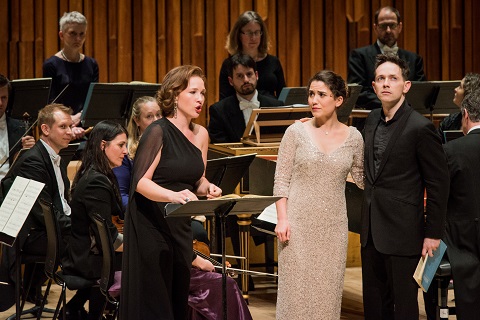 Sasha Cooke (Goffredo), Joélle Harvey (Almirena) and Iestyn Davies (Rinaldo). Photo credit: Robert Workman.
Sasha Cooke (Goffredo), Joélle Harvey (Almirena) and Iestyn Davies (Rinaldo). Photo credit: Robert Workman.
As the eponymous warrior-saviour, Iestyn Davies exhibited all of the ‘infinite variety of colour’ and ‘expressive depth’ which I admired when countertenor and ensemble shared the Barbican Hall stage for a superb performance of Handel’s Orlando in 2016 - to which he here added the stamina, expressive compass and extensive vocal range required to exploit the musical and dramatic diversity of the eight arias and two duets which Handel composed for Nicolini. Davies knows this role well and, though this was a ‘concert performance’, his characterisation and dramatic credibility were unwavering and as compelling as his singing. From Rinaldo’s first recitative, Davies’ countertenor was imbued with a penetrating dynamism which captured the hero’s impetuousness, passion and conviction. When the Amazonian sorceress Armida kidnapped Almirena, disappearing into the black clouds of flame and smoke which spew from her bellowing monsters, this Rinaldo stared into the orchestra, in disbelief at his loss, as if some answers could be gleaned from the spiteful assertions of the instrumentalists’ sinfonia. His grief found expression in both the beauty and rhetoric of ‘Cara sposa’, in which Bicket encouraged the strings to make much of their chromatic nuances and to swell with heartfelt warmth in the ritornelli. Davies ability to sing through the line with mesmerising communicativeness and expressive intensity, and his ease of movement across and between registers, was simply stunning.
And, if the firmness, warmth and expressive sincerity of Davies’ lower range impressed in this aria, in ‘Cor ingrato, ti rimembri’ it was the fluidity of both the vocal line and Joseph Crouch’s eloquent, responsive cello counter-melody that so naturally captured the pain of a heart so distressed that it must surely break in two. Then, quicksilver agility and sweetly piercing clarity marked ‘Venti, turbini, prestate’, with leader Nadjz Zwiener and bassoonist Alberto Grazzi matching the fiery nimbleness of the vocal whirlwinds. Even at the close, Davies’ countertenor sounded fresh and vigorous, equal to the challenge not just of matching the might and majesty of the four trumpets who enliven the triumphant ‘Or la tromba’, but to engaging in well-considered ‘duets’ and trilling in consort with the instrumentalists.
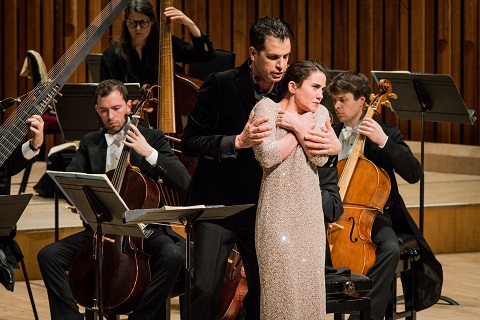 Luca Pisaroni (Argante) and Joélle Harvey (Almirena). Photo credit: Robert Workman.
Luca Pisaroni (Argante) and Joélle Harvey (Almirena). Photo credit: Robert Workman.
Davies’ fellow cast members were no less impressive, though. The first phrase of Armida’s ‘Furie terribili’ flashed with fire as Jane Archibald summoned an almost burning gloss at the top to convey the evil enchantress’s fury, and she wasn’t afraid to introduce an occasional nasal glint to suggest duplicity and cunning. Archibald was untroubled by the extravagant coloratura of her second Act 1 aria, but in the following Act’s grief-laden ‘Ah crudel, il pianto mio’ she found beautiful tonal richness to convey an affecting sorrow which was complemented by plaintive oboe and bassoon.
Recorder player Tabea Debus charmingly evoked pastoral purity in Almirena’s ‘Augelletti’, her rapid-fire whistling conjuring an angelic aviary to dispel the image of Addison’s scorned sparrows. Here, Joélle Harvey’s crystalline soprano matched Debus’ sparkling spotlessness, while the freshness of Harvey’s opening aria, in which Almirena urges her beloved warrior to victory, was tinted with just a glint of passion at times, suggesting a flash of the silvery sword that Rinaldo will carry with him into battle. In Act 3, both the unison between voice and violins and the synchronisation of the fluid changes of metre in ‘Bel piacere’ were flawless. But, before that, Harvey had held the Barbican Hall audience spellbound in ‘Lascia ch’io pianga’: Handel could recognise when he had a hit on his hands, borrowing this aria from his 1707 Roman oratorio, Il trionfo del Tempo e del Disinganno (which had itself made use of material derived from the sarabande in Almira of 1705), but even he would surely have delighted in the grace, beauty and dignity that Harvey bestowed upon the deeply expressive simplicity of this aria, in which Crouch and theorbo player William Carter added discerning and delicate detail.
The plum-coloured hues and consoling warm of Sasha Cooke’s mezzo conveyed all of Goffredo’s regal composure and goodness in the ruler’s first aria of faith and contentment, while the effortless elegance and melodic fluency of ‘Sorge nel petto’ in Act 3 made Goffredo’s calm joy and deep familial love palpable. As Goffredo’s brother, Eustazio, countertenor Jakub Józef Orliński offered a slightly mellower, darker complement to Davies. The easy flow and even colour of ‘Col valor, colla virtù’ at the close of Act 1 impressed, while the lyricism and alertness to textual nuance of ‘Siam prossimi al porto’ evoked both the confident faith and the tender love of the three crusaders as they arrived at Armida’s sure to liberate Almirena from the sorceress’s clutches. Owen Willetts effectively characterised Armida’s supernatural opponent, the Christian conjuror Mago and light-heartedly injected a little comedy into the rescue mission, furnishing the Christian champions with an outsized magician’s wand which would have done a pantomime fairy proud.
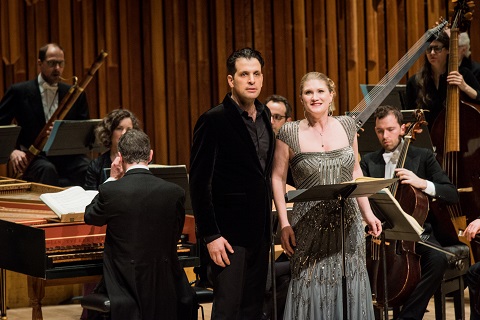 Luca Pisaroni (Argante) and Jane Archibald (Armida). Photo credit: Robert Workman.
Luca Pisaroni (Argante) and Jane Archibald (Armida). Photo credit: Robert Workman.
Supernatural egos and volte-faces provided opportunity for wry humour and wit elsewhere, too, in Armida’s sparring duet with Rinaldo, and when the spurned sorceress put emotional neediness before pride in acceptance the apology of her errant mortal lover, Argante. As the leader of the Islamic forces occupying Jerusalem, Luca Pisaroni made a tremendous impression of bravado and self-righteousness in his entrance aria, ‘Sibillar gli angui d’Aletto’, squaring up vocally and physically to the threat from his Christian challengers and pouring his bass-baritone vigorously but smoothly through the long, running lines. Pisaroni acted superbly, through both voice and demeanour: when appealing to Alminera’s affections, his tone was tender; when responding to her rejection, his voice drew renewed strength from indignation.
Bicket’s direction was not overly demonstrative but small gestures made their mark and there was telling control of cadential hiatuses and resolutions. Understandably, in the light of the terrific instrumental playing we enjoyed, Bicket simply allowed his musicians to demonstrate their excellence, none more so than harpsichordist Tom Foster whose flamboyant rendition of the breath-taking virtuosic improvisatory interludes within Armida’s vengeful war-mongering at the close of Act 2 received perhaps the loudest applause of the evening.
In rejecting what he saw as the childish absurdities of that first production of Rinaldo, Addison did allow that an opera ‘may be allowed to be extravagantly lavish in its decorations, as its only design is to gratify the senses, and keep up an indolent attention in the audience’. There was nothing ‘indolent’ about the attentiveness of the hugely appreciative Barbican Hall audience on this occasion, however, and only the skill, care and insight which Bicket, the English Consort and the superb cast lavished on Handel’s music was required in order for our senses to be satisfyingly and enchantingly gratified.
Claire Seymour
Handel: Rinaldo
The English Concert: Harry Bicket (conductor)
Rinaldo - Iestyn Davies, Armida - Jane Archibald, Goffredo - Sasha Cooke, Almirena/Siren - Joélle Harvey, Argante - Luca Pisaroni, Eustazio - Jakub Józef Orliński, Araldo/Donna/Mago - Owen Willetts.
Barbican Hall, London; Tuesday 13th March 2018.
[1] Reprinted in Oliver Strunk (ed), Source Readings in Music History (Norton & Co., 1998), pp.683-86.
Photo credit: Robert Workman
March 11, 2018
Hamlet abridged and enriched in Amsterdam
This production, enhanced with cinematography, is a triumph of the imagination over limited resources. Even the chronic coughing of a rather restless Amsterdam audience could not diminish its visual impact and raw emotion. So how does a small opera outfit successfully adapt a five-act grand opera?
First, by cutting a good chunk of the score. This version is not for purists, although it is for everyone who appreciates take-no-prisoners theatre. Gone are the ballets, marches and spring festivals. With the focus on the dysfunctional royal family and Ophelia, secondary characters like Ophelia’s father Polonius fade into the periphery. Since Thomas diverges at several plot points from Shakespeare, these reductions bring the opera closer to the play. Voice-over fragments from Hamlet’s Shakespearean monologues in French translation upgrade Carré and Barbier’s effective but conventional libretto. There is no chorus. The soloists, supplemented by three highly competent female singers as courtiers, sing the choral parts. This approach passed the acid test of the opera’s most dramatic moment, when, aided by Hernán Schvartzman’s driven conducting, the singers rose to the challenge of the Act 2 finale. The spine-tingling ensemble after Hamlet publicly accuses his stepfather of murdering his father was satisfyingly grand of gesture. Later on, the women’s singing at Ophelia’s funeral was both tonally glowing and incredibly touching. In the same way, the New European Ensemble, a chamber-sized orchestra, played with a keen sense of drama. Schvartzman led them in an unflaggingly expressive and suspenseful performance. Technically they were challenged by the rapidly ascending and descending figures that mark moments of psychological crisis. The exquisite solo intros, however, were of a different caliber altogether. The onstage brass band, who later doubled as pallbearers, also acquitted themselves commendably. Although not always polished, the orchestral playing never lost sight of the emotional heart of the score.
The visual trump card onstage is the projection of filmed sequences both on a backdrop and on a scrim at the front, creating a striking three-dimensional effect. Quivering images in mossy shades reveal Hamlet’s mind’s eye while the elegantly costumed singers act out the plot. Director Serge van Veggel deliberately smudges the line between real events and the prince’s imagination, keeping the viewer continuously engaged. This juxtaposition of reality and fantasy yields unforgettable images, none more so than Ophelia’s harrowing suicide in front of an idealized image of her floating corpse. But all this sophistication of form would mean little without the fine cast of singing actors. In the title role Quirijn de Lang looks like an English Romantic poet, John Keats at Elsinore as it were. His plangent, slightly nasal baritone fits the character and the language. De Lang produces his voice skillfully across all registers and is a gifted, instinctive actor. His Hamlet hurts so intensely and behaves so insufferably that, like his mother, you want to protect him, but you also feel like slapping him, like his stepfather. The signs of vocal tiredness towards the end were a small trade-off for the fierceness of his interpretation.
Soprano Lucie Chartin’s Ophelia starts out with a charming twinkle in her eye, then gradually collapses into the frangible victim of Hamlet’s bullying and abandonment. After taking a few phrases to settle vocally, Chartin sang very naturally, as if she were speaking, which rendered her portrayal intimate and immediate. In her mad scene she dispensed with pretty warbling and mined deep pathos from Ophelia’s folk song. Accurate and tortured, her high-flying cadenzas sliced the air like stiletto knives. The other singers all delivered the goods. Martijn Sanders and Martina Prins were vocally commanding as the royal couple, Sanders an unempathic and stiff Claudius and Prins a regal and soft-hearted Gertrude. Gertrude is written for a mezzo-soprano and Prins, being a dramatic soprano, had easy, ringing high notes as well as a formidable middle range. Jan-Willem Schaafsma’s willowy tenor left a very favorable impression as Laertes, Ophelia’s brother. The quality bass of Yavuz Arman İşleker was on double duty, most memorably as the ghost of Hamlet Senior. Bass-baritone Patrick Pranger and tenor Georgi Sztojanov completed the estimable roster of soloists as Hamlet’s friends Horatio and Marcellus. They also added a touch of gruesome humor as a pair of skull-tossing gravediggers.
This distilled Hamlet, adapted with informed respect and performed with passion, is a gripping music drama. It continues to tour until April. The last two dates are at the company’s home base, the Koninklijke Schouwburg in The Hague. Performances are subtitled in Dutch and English.
Jenny Camilleri
Cast and production information:
Hamlet: Quirijn de Lang; Ophélie: Lucie Chartin; Claudius: Martijn Sanders; Gertrude: Martina Prins; Laërte /Player Queen: Jan Willem Schaafsma; Horatio/First Gravedigger: Patrick Pranger; Marcellus/Second Gravedigger: Georgi Sztojanov; Polonius/Ghost (Voice)/ Player New King: Yavuz Arman İşleker; Ghost (Actor)/ Player Old King: Joop Keesmaat; Courtiers: Judith Pranger, Sonja Volten and Adélaïde Rouyer; Hamlet Voice-Over: Jonathan Rouah. Director: Serge van Veggel; Play Director: Femke Luyckx; Set Design: Herbert Janse; Costume Design: Mirjam Pater; Lighting Design: Uri Rapaport; Film: Margo Onnes; Sound Design: Arne Bock. Conductor: Hernán Schvartzman. New European Ensemble. Seen at the Royal Carré Theatre, Amsterdam, on Saturday, 10th of March, 2018.
image=http://www.operatoday.com/1494253061.png image_description=Courtesy of OPERA2DAY product=yes product_title=Hamlet abridged and enriched in Amsterdam product_by=A review by Jenny Camilleri product_id=Above courtesy of OPERA2DAYOpera in Amsterdam in 2018-2019
The Nederlandse Reisopera takes its productions on tour across the country and they also perform in Amsterdam, at the Royal Carré Theatre. Smaller touring companies such as Opera Zuid, Opera Trionfo and OPERA2DAY also visit the capital, with increasingly interesting productions and emerging talent. Not all their projects and performing dates for next season are public knowledge yet, but the big companies and venues have all announced their 2019-2018 season. Here’s a look at some of the vocal highlights.
Dutch National Opera (DNO) opens its season, an interesting mix of traditional and modern, with an “old” production, Simon McBurney’s darkly fascinating Die Zauberflöte. For those who have already seen it, there are at least three new casting reasons to return: sopranos Mari Eriksmoen (Pamina) and Kathryn Lewek (Queen of the Night) and tenor Stanislas de Barbeyrac (Tamino). Robert Wilson’s minimalistic Madama Butterfly, inspired by Japanese Noh theatre, will also be revived. Russian soprano Elena Stikhina, whose star is on the rise, sings Cio-Cio-San. Two new productions, Rossini’s The Barber of Seville and Gershwin’s Porgy and Bess, are marked out as family entertainment, with attractive pricing for the under-sixteens. This is the first time DNO is presenting Porgy and Bess and the cast includes Eric Owens, Adina Aaron and Latonia Moore. The Baroque era is served by a new staging of Vivaldi’s biblical oratorio Juditha triumphans. Floris Visser directs and Andrea Marcon conducts. The all-female cast is led by mezzo-soprano Gaëlle Arquez. DNO Principal Conductor Marc Albrecht continues his Wagner series with Tannhaüser in a new production by Christof Loy. In the title role, tenor Daniel Kirch is torn between the Elizabeth of Svetlana Aksenova and the Venus of Ekaterina Gubanova. Co-productions making their way to Amsterdam include Àlex Ollé’s staging of George Enescu’s only opera, Oedipe. Johan Reuter and Sophie Koch are the incestuous couple and Amsterdam audience favorite Violeta Urmana sings the Sphinx.
In March DNO organizes the Opera Forward Festival (OFF) to explore future directions in opera. Four new or very recent operas are programmed for 2019, including György Kurtág’s setting of Samuel Beckett’s play Fin de partie (Endgame), which gets its world premiere at La Scala in November of this year. For the Holland Festival, which takes place every June, DNO is putting on 15 hours of Karlheinz Stockhausen’s seven-opera cycle LICHT. Spread across three days, the performances are at the Gashouder, a circular industrial space within an old gasworks complex. Also on the Holland Festival programming is a new production of Debussy’s Pelléas et Mélisande. Daniele Gatti conducts the Royal Concertgebouw Orchestra (RCO), in their single appearance at DNO, and Olivier Py directs. The cast is yet to be revealed.
The Nederlandse Reisopera kicks off its season with Puccini’s Tosca. As usual, this imaginative company has put together a short but assorted season. Their other two travelling productions will be Erich Korngold’s Die tote Stadt and Stephen Sondheim’s musical A Little Night Music. Amsterdam has to do without staged Verdi next season, but the NTR ZaterdagMatinee series at the Concertgebouw includes a concert version of Nabucco conducted by Giancarlo Andretta. Franco Vassallo sings the title role and Tatjana Serjan is Abigaille. Other operatic matinees include Andrea Marcon conducting Vivaldi’s L’Olimpiade and Mark Elder conducting A village Romeo and Juliet by Frederick Delius. The NTR ZaterdagMatinee season opens with Mussorgsky’s masterpiece Boris Godunov under the leadership of Pablo Heras-Casado.
There are more full-length operas in concert at the Concertgebouw. Barbara Hannigan conducts the LUDWIG ensemble and a cast of young soloists in Stravinsky’s The Rake’s Progress. Daniel Harding leads the RCO in Bartok’s Bluebeard’s Castle, with Hungarian bass Gábor Bretz as the Duke. The RCO will also perform non-operatic vocal works, including Arthur Honegger’s oratorio Jeanne d'Arc au bûcher. The conductor is Stéphane Denève and the cast includes celebrated soprano Christine Goerke. Mariss Jansons conducts Britten’s War Requiem with soloists Elena Stikhina, Mark Padmore and Michael Volle. Antonio Pappano is on the rostrum for the Grande Messe des Morts by Berlioz, with tenor Javier Camarena. Continuing their Eastertide passion tradition, the RCO have invited William Christie to conduct Bach’s St. John Passion. Holland around Eastertime becomes Passionland and there are several other Bach Passion performances, at the Concertgebouw and other venues.
The virtuosic Cecilia Bartoli returns to the Concertgebouw, as she does practically every year, for an evening of Vivaldi. The intimate Concertgebouw Recital Hall hosts great song interpreters such as Sarah Connolly, Simon Keenlyside, Christopher Maltman and Roderick Williams. Soprano Anna Lucia Richter and baritone Georg Nigl perform Hugo Wolf’s Italienisches Liederbuch. Soprano Renée Fleming is also performing a program of French and German songs, but will appear in the Main Hall. Two other American opera stars, Lawrence Brownlee and Michael Spyres, promise an evening of tenorial prowess during a joint program of operatic arias.
The art song series at the Muziekgebouw aan ’t IJ complements the recitals at the Concertgebouw. Next season it features both of Schubert’s great song cycles. Tenor Michael Schade sings Die schöne Müllerin and baritone Florian Boesch takes on Winterreise. Anne Sofie von Otter visits with an intriguing Shakespeare-themed program. The season at this waterside concert hall opens on the 8th of September with a celebration of conductor and composer’s Reinbert de Leeuw’s 80th birthday. Soprano Barbara Hannigan performs Erik Satie’s Socrate. The rest of the program will be a surprise for both De Leeuw and the audience. In May 2019 the Muziekgebouw hosts a festival celebrating the 80th birthday of another Dutch contemporary great, Louis Andriessen, including a staged double bill of his operas Odysseus' Women and Anaïs Nin.
With so much going on, there is a good chance that a visit to Amsterdam can include a classical vocal event somewhere. For those who want to make music the main item on their itinerary, some weeks offer richer pickings. Here are some suggestions.
Season Opener Weekend 7-8 September, 2018:
Friday, September 7: Die Zauberflöte, Dutch National Opera & Ballet at 19:30 hrs
Saturday, September 8: Boris Godunov, Concertgebouw at 12:00 hrs
Saturday, September 8: Reinbert de Leeuw 80th Birthday Concert, Muziekgebouw aan ‘t IJ at 20:15 hrs
Midweek Opera 6-7 December, 2018:
Thursday, December 6: Oedipe premiere, Dutch National Opera & Ballet at 20:00 hrs
Friday, September 7: Bluebeard’s Castle (+Dvořák’s Piano Concerto), Concertgebouw at 20:15 hrs
Vivaldi 7-9 February, 2019:
Thursday, February 7: Juditha triumphans, Dutch National Opera & Ballet at 20:00 hrs
Saturday, February 9: L’Olimpiade, Concertgebouw at 13:00 hrs
Contemporary Opera at the Opera Forward Festival 7-10 March, 2019:
Thursday, March 7: The Second Violinist by Donnacha Dennehy, Muziekgebouw aan ‘t IJ at 21:00 hrs
Friday, March 8: Caruso a Cuba by Micha Hamel, Stadsschouwburg at 20:30 hrs
Saturday, March 9: Girls of the Golden West by John Adams, Dutch National Opera & Ballet at 19:30 hrs
Sunday, March 10: Fin de partie by György Kurtág, Dutch National Opera & Ballet at 14:00 hrs
Opera and Oratorio May 1-4, 2019:
Wednesday, May 1: Tannhäuser, Dutch National Opera & Ballet at 18:30 hrs
Thursday, May 2: Madama Butterfly, Dutch National Opera & Ballet at 20:00 hrs
Friday, May 3: Grande Messe des Morts, Concertgebouw at 20:15 hrs
Saturday, May 4: Missa solemnis (Beethoven, conducted by René Jacobs), Concertgebouw at 14:15 hrs
Holland Festival June 1-8 2019:
Saturday, June 1: Die Gezeichneten (Schreker), Concertgebouw at 13:00 hrs
Tuesday, June 4, aus LICHT Part 1, Gashouder, Westergasfabriek at 19:30 hrs
Wednesday, June 5, aus LICHT Part 2, Gashouder, Westergasfabriek at 13:15 hrs
Thursday, June 6, aus LICHT Part 3, Gashouder, Westergasfabriek at 12:30 hrs
Saturday, June 8, Pelléas et Mélisande, Dutch National Opera & Ballet at 19:30 hrs
DNO performances are subtitled in English and Dutch, those of most other opera companies and the NTR ZaterdagMatinee only in Dutch. Printed text translations at concerts and song recitals, when provided, are in Dutch. Buying tickets ahead online is pain free. All venues accept credit cards, allow you to choose your seat and issue e-tickets for printing at home. Single tickets for the coming season at the Concertgebouw go on sale on the 1st of June, 2018. DNO staggers its single ticket sales throughout the season. Detailed information is available on their website. Tickets for the Opera Forward Festival are also sold via DNO. Muziekgebouw aan ‘I IJ single tickets are already on sale. Tour dates for the Nederlandse Reisopera will be published soon. Their website will have links to online ticket sales at the various venues.
Jenny Camilleri
image=http://www.operatoday.com/bereikbaarheid-emmely-siebrecht-1.png image_description=Het Concertgebouw © Emmely Siebrecht product=yes product_title=Opera in Amsterdam in 2018-2019 product_by=A commentary by Jenny Camilleri product_id=Above: Het Concertgebouw © Emmely SiebrechtLyric Opera of Chicago to Premiere Fellow Travelers—A Preview
The story focuses on the tensions between the private and public lives of the two protagonists, Timothy Laughlin and Hawkins Fuller. In those days, being identified as sexually different was tantamount to being labeled a Communist, a charge that suggested treason. Mallon’s novel offers a point of departure for this musical setting, which has been acclaimed in BroadwayWorld as having “some of the most gorgeous opera music in recent memory.” The New York Times review of a production at the Prototype Festival calls attention to the strength of Spears’s score’s focus on the gay couple as “daring to envelop these men in rapturous music of almost cinematic lushness. . . .”
Lyric’s production of Fellow Travelers includes tenor Jonas Hacker and baritone Joseph Lattanzi in the lead roles of Timothy Laughlin and Hawkins Fuller. Soprano Devon Guthrie will sing the role of Mary Johnson, Hawkins’s assistant and Timothy’s confidante. The Chicago premiere of Fellow Travelers will also feature soprano Vanessa Becerra as Miss Lightfoot, baritone Marcus DeLoach as Senator McCarthy, soprano Amy Kuckelman as Lucy, baritone Will Liverman as Tommy McIntyre, baritone Reginald Smith, Jr. as Senator Charles Potter, and bass-baritone Sam Handley as Potter’s Assistant. In her Lyric debut in the pit, Daniela Candillari will conduct the 17-piece orchestra and Kevin Newbury will direct the production.
This production fits well into Lyric’s fine tradition of performing new and recent operas, like Jimmy López’s Bel Canto in the 2015-2016 season and André Previn’s A Streetcar Named Desire in 2015. Performances of Fellow Travelers will be given in Chicago’s Athenaeum Theater, with performances on 3/17, 3/21, 3/23, and 3/25. More information on this production is available online here.
James L. Zychowicz
image=http://www.operatoday.com/Cincinnati-Opera-Fellow-Travelers-005%2C-credit-Philip-Groshong.png
image_description=Scene from Fellow Travelers [Photo © Philip Groshong]
product=yes
product_title=Lyric Opera of Chicago to Premiere Fellow Travelers—A Preview
product_by=A commentary by James L. Zychowicz
product_id=Above: Scene from Fellow Travelers [Photo © Philip Groshong]
March 9, 2018
The ROH's first production of From the House of the Dead
‘We lived in a heap together in one barrack. The flooring was rotten and an inch deep in filth, so that we slipped and fell. When wood was put into the stove no heat came out, only a terrible smell that lasted through the winter.’ So wrote Dostoevsky, in a letter to his brother, about his experiences in the Siberian prison camp at Omsk where he was incarcerated between 1850-54, because of his association with a group of political dissidents who had tried to assassinate the Tsar. It was the quasi-fictionalised account of Dostoevsky’s imprisonment, published predominantly in the journal Vremya between 1860-62, that was Janáček’s source for the libretto of From the House of the Dead. The composer selected characters and incidents - events that occurred in the prison hospital, the celebration of feast days - and assembled them into a mosaic punctuated by three extended narratives in which individuals recount the violent crimes and contexts that have resulted in their incarceration and suffering.
Warlikowski tells us that he ‘made a conscious decision not to re-read Dostoevsky’s novel’ wanting to keep at bay his youthful fascination with this text, and ‘focus more directly on Janáček’s adaptation of the novel, and use his score and libretto to create a world not specifically ‘Russian’, but more universal in feel.’
Nothing wrong with that: violence, (in)justice and freedom are universal concerns, and all human existence involves suffering in some form. But, the practical outcome might lead one to think that the opera had been based upon a text which read, ‘We lived together in a shabby recreation hall, playing basketball, lounging about in smart tracksuits, watching football on a plasma television screen. A prostitute was made readily available, and on public holidays we were treated to champagne and soft-porn entertainment.’ Warlikowski titles his programme article ‘A Journey into Hell’ but in fact these detainees seem to be having quite an indulgent - if not very salubrious - time.
Warlikowski and his designer Małgorzata Szczęśniak have replaced Dostoevsky’s Siberian gulag with a modern penitentiary. The open stage is vast and bare. Stage right is a glass office where the Prison Commander reads a newspaper, occasionally looking up to check the cctv surveillance monitor, as prisoners wander in and out to do business with the drug-dealing guards. The office swivels and, from my position in the Balcony, the glass frequently reflected conductor Mark Wigglesworth in the pit, weakening the realism, physical and psychological, that Janáček’s music so powerfully establishes.
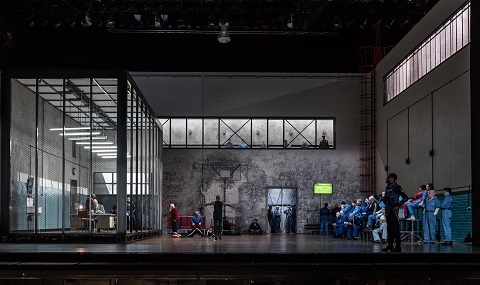 Photo credit: Clive Barda.
Photo credit: Clive Barda.
During the overture it becomes clear that when Warlikowski says he wants to make the opera ‘more universal’ what he actually means is more ‘ideological’. Projected onto the steel squares which form a bulwark of a stage curtain, a film of Michel Foucault critiquing the prison system unfolds. If the French philosopher’s words have power they don’t really have relevance here - Janáček and Dostoevsky were more interested in man’s potential if not for forgiveness then at least for understanding, than in the notion that the justice system only exists to justify the existence of the police.
Moreover, the video images distract from what we are hearing - an objective representation of social reality: that is, the clinking chains, whiplash sounds and screams, mechanical sounds and the drum rolls which break up the day as the opera proceeds. And, this is the principal problem with Warlikowski’s production: it doesn’t listen to what the music is saying and doesn’t respect the balance between realism and escapism that the score achieves, as Janáček’s bitter extremes of harmony, orchestration and tessitura suddenly surge with a lyrical beauty so intense that it is almost painful.
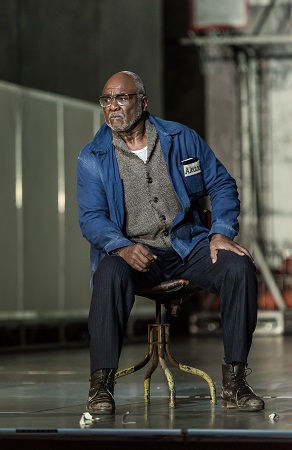 Willard W. White as Alexandr Petrovič Gorjančikov. Photo credit: Clive Barda.
Willard W. White as Alexandr Petrovič Gorjančikov. Photo credit: Clive Barda.
Time after time I found myself distracted by the frenetic stage activity - such as the hyper-manic break-dancing of four black dancer-prisoners - which obscured significant events and overpowered the libretto’s moments of narrative focus and stillness. The arrival and humiliation of Petrovič at the start of Act 1, and his subsequent flogging, for example, almost passed me by, and this was not because Willard White was anything less than superb as he tried to maintain the ‘aristocratic’ prisoner’s human dignity. The prisoners may be indifferent to the beating Petrovič receives, as he stands for their own sufferings; but we are not, and it matters that his abusive treatment is pushed by Warlikowski to the margins, not least because the beating mirrors the violence in the tale which Luka is narrating - thus merging prison life with the world outside, as direct and reported intersect.
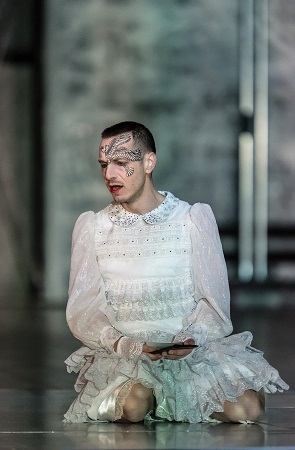 Pascal Charbonneau as Aljeja. Photo credit: Clive Barda.
Pascal Charbonneau as Aljeja. Photo credit: Clive Barda.
Moreover, Petrovič is central to the opera’s shifting energies: at the close, his freedom is emblematic, bound with both the release of the eagle that has been cruelly baited by the prisoners and with the sadness of separation felt by Aljeja, who is losing a friend - but also indicative of renewal.
But, Warlikowski is not much interested in such renewal, or in the eagle, though the latter’s instinct for freedom is associated with Dostoevsky’s definition of the psychological motive behind crime as a burst of free will, thus blending freedom and captivity in a single motif. Here, ‘The Eagle’ is the name of a black basketball player who may or may not lob the ball through the hoop in the final moments of the opera.
This opera is not concerned with philosophical speculations about justice and the police force but with human motivations, acts and humanity’s desire for freedom - as expressed in the three main solo narrations. One could not fault the performances of Štefan Margita as Luka Kuzmič or Ladislav Elgr as Skuratov. But, the energy with which their strong, unflinching tales of violence begetting violence should surge was blunted by the onstage busyness, and in Skuratov’s case by another pre-Act projection, this time of the real-life reflections of a prisoner on death row: truly distressing but, in this context, also diverting. For Skuratov’s narration should hint at the outside world, the freedom of the limitless steppes, releasing the tension and admitting romance and heterosexual love into the prison as it is listened to by the fascinated prisoners. And, Warlikowski once again added unnecessary action - in this case, a mime by Pascal Charbonneau’s Aljeja, to the tale.
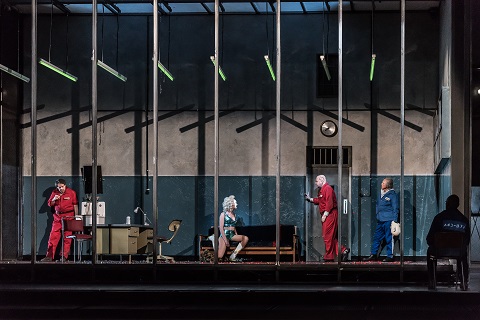 Štefan Margita as Luka Kuzmič, Allison Cook as Prostitute, Johan Reuter as Šiškov, Alexander Kravets as Čerevin. Photo credit: Clive Barda.
Štefan Margita as Luka Kuzmič, Allison Cook as Prostitute, Johan Reuter as Šiškov, Alexander Kravets as Čerevin. Photo credit: Clive Barda.
Similarly, the festive atmosphere of the following Easter celebrations further heightens the emotion and evokes freedom. Warlikowski took the ironic parallels which the festive entertainments offer to the tragic drama of sexual love to extremes, however, as the men resorted to battering and abusing inflatable dolls in a soft-porn extravaganza fuelled by champagne.
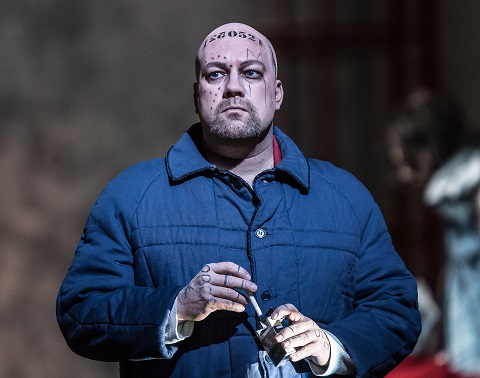 Johan Reuter as Šiškov. Photo credit: Clive Barda.
Johan Reuter as Šiškov. Photo credit: Clive Barda.
We had to wait until Act 3 for the feverish intensity to find a focus, in Šiškov’s terrible narrative about the tragic mistreatment of Akulka. Wanton and worthless, despised by his fellow prisoner he may be, but Johan Reuter’s warm and commanding delivery made Šiškov’s narrative utterly compelling, as the orchestral music, punctuated by the moans of pain of the patients in the hospital prison, invited our sympathy. But, even here, Warlikowski could not quite trust the score, and Allison Cook’s Prostitute was called upon to mime the narrative - yet another needless intrusion.
The entire cast sang and acted with captivating conviction: the sufferings and sorrows, flaws and failings of Nicky Spence’s Nikita, Grant Doyle’s Čekunov, Graham Clark’s Antonič, and the prisoners enacted by Jeffrey Lloyd-Roberts, Peter Hoare, Aleš Jenis, Florian Hoffmann, Alexander Kravets and John Graham-Hall were all brought affectingly to life. Wigglesworth delineated the score’s tensions and jagged edges with precision but did not always allow the moments of lyrical release to surge with warmth.
For this listener, the opera’s real power lies in the moments when the prisoners’ bitter alienation from the ‘real’ world is overcome, when outside world and prison converge, such as when Šiškov recognises and attacks Luka at the close and is reminded by the old prisoner that ‘He was born of a mother too’, sobbing as he makes the sign of the cross over Luka’s corpse, ‘There are bright moments in house of the dead.’ Such moments affirm the value of humanity and the purpose of existence, even amongst the lowest fallen.
As the score’s inscription states, in every creature there is a spark of God. Warlikowski’s production fails to embody this small optimism which is ever present in both the free and the captured.
Claire Seymour
Leoš Janáček: From the House of the Dead
Alexandr Gorjancikov - Willard W. White, Aljeja - Pascal Charbonneau, Luka Kuzmič - Štefan Margita, Skuratov - Ladislav Elgr, Šiškov/Priest - Johan Reuter, Prison Governor - Alexander Vassiliev, Big Prisoner/Nikita - Nicky Spence, Small Prisoner/Cook - Grant Doyle, Elderly Prisoner - Graham Clark, Voice - Konu Kim, Drunk Prisoner - Jeffrey Lloyd-Roberts, Šapkin - Peter Hoare, Prisoner/Kedril - John Graham-Hall, Prisoner/Don Juan/Brahmin - Aleš Jenis, Young Prisoner - Florian Hoffmann, Prostitute - Allison Cook, Čerevin - Alexander Kravets, Guard - Andrew O'Connor; Director - Krzysztof Warlikowski, Conductor - Mark Wigglesworth Designer - Małgorzata Szczęśniak, Lighting designer - Felice Ross, Video designer - Denis Guéguin, Movement director - Claude Bardouil, Dramaturg - Christian Longchamp, Royal Opera Chorus and Orchestra.
Royal Opera House, Covent Garden; Wednesday 7th March 2018.
image=http://www.operatoday.com/From%20the%20House%20of%20the%20Dead%20production%20image%20Photo%20by%20Clive%20Barda.jpg image_description=From the House of the Dead, Royal Opera House, Covent Garden product=yes product_title=From the House of the Dead, Royal Opera House, Covent Garden product_by=A review by Claire Seymour product_id=Above: Production imagePhoto credit: Clive Barda
March 8, 2018
Così fan tutte at Lyric Opera of Chicago
The cast features Ana María Martínez and Marianne Crebassa as the sisters Fiordiligi and Dorabella; their suitors Guglielmo and Ferrando are performed by Joshua Hopkins and Andrew Stenson. The worldly Don Alfonso is Alessandro Corbelli, the sisters’ housemaid Despina is Elena Tsallagova. The performances are conducted by James Gaffigan. This production is owned by the San Francisco Opera and Opéra de Monte Carlo. The original director is John Cox, the Revival Director is Bruno Ravella. The Lyric Opera Chorus is prepared by its Chorus Master Michael Black. Sets and costumes are designed by Robert Perdziola, the Lighting Designer is Chris Maravich, and wigs and makeup are designed by Sarah Hatten. Ms. Tsallagova and Mr. Gaffigan make their debuts at Lyric Opera of Chicago in these performances, and in the case of Tsallagova, her U.S. debut.
The dispute concerning fidelity that had already begun among the male principals before the start of Act One continues as the curtain rises, appropriately, on the gaming room of a Mediterranean resort hotel. The wager initiated by Don Alfonso follows protests by both Guglielmo and Ferrando that their prospective lovers would never waver. In his defense of Dorabella, Mr. Stenson’s impassioned portrayal in the concluding trio results in variable projection. Mr. Hopkins’s steady melodic line is matched by Mr. Corbelli in his self-assured depiction of Don Alfonso as a prophet of human foibles. Corbelli’s easily produced runs and embellishments of key lines suggest a natural emphasis on the part of a realistic adviser. Both young men submit to the wager of “cento zecchini” while Corbelli’s imperturbable coolness invites the audience to a display worth watching.
In the following scene the sisters show equivalent devotion to their respective partners. Ms. Martínez communicates emotional confidence in her “guerriero ed amante” (“soldier and lover”) Guglielmo by means of enhanced vibrato. Ms. Crebassa’s Dorabella shows her insistence more pointedly and with expressive runs leading to a delightful appoggiatura. The calm of both women is interrupted by Don Alfonso’s entry and announcement that the men have been called to the battlefield. This production draws on the identification of Guglielmo and Ferrando as officers to fix a tense date of August 1914 for the action. Accompanying production details, such as dress and props, conform then to this chronology. The sisters react with perfect unison on “Ohimè, che sento?” (“Alas, what do I hear?”), before Corbelli summons the men now in uniform onto the scene. In the following series of quintets and recitatives the lovers vary in emphasis while reacting to their imminent separation. Hopkins and Crebassa are especially importunate before Don Alfonso celebrates the moment of departure by means of a period, group photo. The gentle, moving trio, “Soave sia il vento” (“Soft be the breeze”), is exactly that, as Martínez and Crebassa express their misgivings with Corbelli’s voice affecting a thread of unity.
The first entrance of Despina injects a touch of lightness into this officially somber mood. Ms. Tsallagova not only acts convincingly but she also uses her perky voice to counter the sisters’ pessimism. Her response to Crebassa’s forte approach in “Smanie implacabili” (“Implacable pangs”) exemplifies Despina’s realistic philosophy in the aria concluding “amiam per comodo” (“Let us love to suit our convenience”). In this solo Tsallagova provides choice decoration on “fedeltà” with top notes scattered and pointed throughout. After a brief conspiratorial scene between the three men and Despina the sisters return to witness unrecognized “uomini in casa nostra.” Although Don Alfonso vouches for the disguised suitors as close friends, their presence evokes surprise and consternation. Crebassa’s reaction suggests already a nascent curiosity while Martínez remains steadfast “Come scoglio” (“Like a rock”). In this touchstone of an aria Martínez displays an even and confident approach with measured embellishments on significant lines. The comparable responses in subsequent solo pieces for the disguised suitors allow the men to remain sure in their wager with Don Alfonso. Stenson reclines on a chaise longue to sing “Un’ aura amorosa” (“A breath of love”) as a dreamy self-reflection. Stenson’s breath control and light voice communicate the delicacy of the sentiment while his transition into the repeat is accomplished with an effortlessly arching glide.
The conclusion of Act One, in keeping with this production’s fiction, features the sisters wearing Red Cross symbols while surveying the wounded. Soon after the entrance of the disguised suitors, the men claim to have taken poison. The further disguise of Despina— in pit-helmet and glasses—as a doctor fetched to remedy adds to the madcap hilarity and emotional indecision of the final scene.
At the start of Act Two sufficient possibility and self-doubt has been sown such that Despina’s encouragement begins to bear fruit. In her aria “Una donna a quindici anni” (“At fifteen a woman”) she encourages the worldly and wise demeanor to which her ladies should have recourse. Tsallagova’s self-congratulatory and controlled ending, “Viva Despina, che sa server” (“Cheers for Despina, she knows how to do it”), leads directly into the sisters’ examination of their future conduct. After a spirited self-defense they begin to relent and to use Despina’s very words from a previous scene, e.g., “divertirsi” (“amuse ourselves”). In this production the transition is not staged as a mere reversal, since the sisters continue to touch the pendants with portraits of their true loves—while choosing a dalliance with the other. In the first scene of surrender Dorabella walks alone with Guglielmo; their playful dialogue extends to vocal decorations of highlighted emotion. When Hopkins describes his heart “e spasima per voi” (“that longs for you”), he urges Dorabella to take his symbolic pendant (“L’accettate?” [“Will you acceprt it?”]) with both phrases showing urgency through increasing rubato. In their subsequent duet Hopkins expresses excitement by rolling playfully the letter "r" in “furbetta” (“you little rogue”) while Crebassa extends repeated top notes on the “Vesuvio” (“volcano”) in her breast.
A comparable trajectory for the second couple simply shows more extensive resistance. In her ultimate statement of loyalty Martínez transforms the aria “Per pietà, ben mio” (“In pity’s name, my dearest”) into a showcase of exciting, vocal decoration. While left alone and protesting her devotion to Guglielmo, the range from “fra quest’ ombre” (“among these shades”) upward to top pitches on “sempre ascoso” (“evermore hidden”) is taken by Martínez at a moderate and challenging pace. The attempt to convince herself that she will spare her lover the knowledge of unfaithful thoughts is conclusively embellished by Martínez with repeated melismas on “Caro bene” (“Dear heart”). Once the suitors have compared their experiences Ferrando realizes that he must redouble his efforts in order to keep pace with Guglielmo. In his aria “Tradito, schernito” (“Betrayed and scorned”) Stenson’s voice rises from understated anger to rage on “perfido cor” (“by her faithless heart”). His extended notes on “Le voci d’amor” (“The voice of love”) exemplify his resolve to conquer the determination of Fiordiligi.
Once the stage of equality among the couples is reached, it remains for Don Alfonso and Despina to guide the strands of love back into place. In the ultimate making and unmasking of the final scenes the phrase “bella calma troverà” (“he will find sweet peace”) speaks for a resolution of confusion and uncertainty. As the men in this production march off at the close into military conflict, one must presume that the “calma” will remain, for the most part, emotional.
Salvatore Calomino
image=http://www.operatoday.com/Ana%20Mari%CC%81a%20Marti%CC%81nez_Joshua%20Hopkins_Andrew%20Stenson_Marianne%20Crebassa_COSI%20FAN%20TUTTE_37A6378_c.Cory%20Weaver.png
image_description=Ana María Martínez, Joshua Hopkins, Andrew Stenson, and Marianne Crebassa [Photo © Cory Weaver]
product=yes
product_title=Così fan tutte at Lyric Opera of Chicago
product_by=A review by Salvatore Calomino
product_id=Above: Ana María Martínez, Joshua Hopkins, Andrew Stenson, and Marianne Crebassa [Photo © Cory Weaver]
WNO's Wheel of Destiny rolls into Birmingham
David Pountney’s production, which uses a new critical edition based on the 1869 version but which reverts to parts of the original 1862 score in Act 3, is the first of three Verdi operas which will be conducted by Carlo Rizzi over the next three years, with Un ballo in maschera andLes vepres siciliennes following in 2019 and 2020 respectively.
Pountney wastes no time confirming that Fate is exerting its inexorable grip on the protagonists. Projected onto the plain, angled walls of designer Raimund Bauer’s set, a wheel spins, slowly gaining momentum, metamorphosing into a pistol which releases a bullet which surges forward, unstoppably, towards its target. And, blood will beget blood. The opera’s first death, of the Marchese di Calatrava, is marked by a blood-splattered wall which continually weeps red tears in which both of his offspring, Leonora and Carlo, smear their hands. Religion will offer no consolation: the monks who watch the disguised Leonora make her ritual progress into the seclusion of the holy cave in the mountain side, later don blood-stained mitres.
Verdi, well-known for his adulation of Shakespeare, seems to have tried to embrace ‘all of life’ - its variety, contrasts, contradictions, epic events and insignificancies - in this opera. Spanning ten or more years, the drama ignores the unities of time and action, as his librettist Piave noted in the opera’s production book: ‘About 18 months pass between the first and second acts; several years between the second and the third; more than five years between the third and the fourth.’ (quoted in Julian Budden, The Operas of Verdi, vol.2, (Cassell, 1978)). The opera’s geography is no less expansive, as the drama travels from an aristocratic dwelling in Seville, to an inn and hillside monastery near Hornachuelos, and on to Italy, to a wood and military encampment near Velletri, and back again to Spain.
And during these years and travels, much happens, as epitomised by a letter from Verdi to Cammarano, in which he envisages a military camp which later made its way into La forza: ‘There is a grand scene in this style in Schiller's Wallenstein [Wallensteins Lager]: soldiers, camp followers, gypsies, fortune-tellers, even a monk who preaches in the world’s most deliciously comic style. You cannot put in a monk, but you can put in all the rest, and you even can make a little dance for the gypsies. In short, make me a characteristic scene that will give a true picture of a military camp.’ (quoted in Franco Abbiati, Giuseppe Verdi, vol.2 (Ricordi, 1959)).
It is surely no accident that the two words which Pountney projects to preface the two parts of his production, ‘Peace’ and ‘War’, evoke Tolstoy’s epic historic chronicle. But, Pountney to some extent mimics Fate, in that he exerts a firm grip on Verdi’s rambling and unwieldy, but potent, account of Leonora’s elopement with the immigrant Alvaro, a dispossessed Inca prince, following the accidental death of her father, and the subsequent vengeful pursuit of her brother Carlo, who refuses to believe in the lovers’ innocence and for whom only their deaths will suffice as familial restitution.
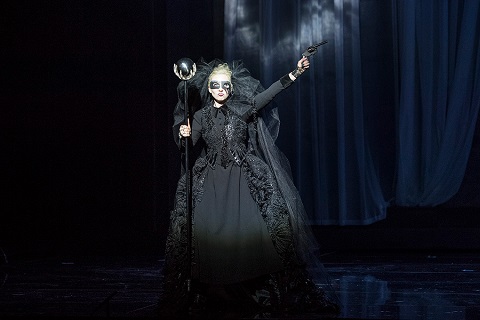 Justina Gringytė (Preziosilla). Photo credit: Richard Hubert Smith.
Justina Gringytė (Preziosilla). Photo credit: Richard Hubert Smith.
There are, inevitably, some gaps and non-sequiturs that cannot quite be made to cohere, such as the disconcerting suddenness of the lyrical outpouring of reunited love in the final act - when Alvaro is recognised by the presumed-dead Leonora when the latter emerges from a hermitage, after the lovers have been kept apart for ten years, two acts, and two hours of music. But, Pountney and Bauer both simplify and unify, to good effect, making Preziosilla - the young gypsy whose rousing song in Act 2 spurs the young Spaniards to do battle against the Germans and who predicts for Carlo, who is disguised as a student, a tragic end - an embodiment of Fate itself. This black figure - who at times resembles the Queen of the Night, and elsewhere a cabaret singer from Weimar - prowls through each act, having initiated the fateful trajectory of the drama with three violent bangs of her staff in unison with the blaring three chords for brass, horn and bassoon which open the opera. Justina Gringytė’s powerful, supple mezzo really makes its presence felt, infusing the drama with a vibrant energy, and Gringytė doubles effectively as Leonora’s maid, Curra, who in this production is particularly keen to hasten Leonora’s elopement in the opening scene.
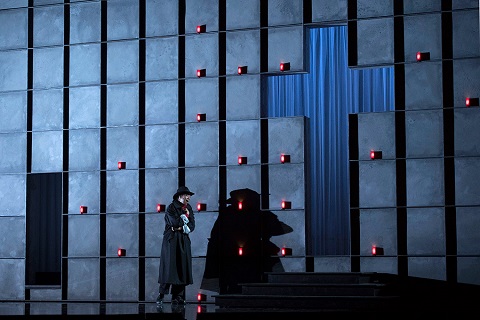 Mary Elizabeth Williams (Leonora). Photo credit: Richard Hubert Smith.
Mary Elizabeth Williams (Leonora). Photo credit: Richard Hubert Smith.
Moreover, the WNO cast live up to Verdi’s hope - expressed in a letter to his friend Vincenzo Luccardi in February 1863 - that ‘Certainly, in La forza del destino the artists need not know how to sing coloratura, but they must have some soul and understand the words and express them.’ (see Franz Werfel and Paul Stefan (eds), Verdi: The Man in His Letters (Vienna House, Inc., 1973)). And, none more so than Mary Elizabeth Williams, whose soft-edged gracefulness and ability to withdraw her gentle soprano to the merest pianissimo conveyed all of Leonora’s dignity, sincerity and sorrow. The intonation took a little while to settle, and at her quietest she was not always able to sustain the lyricism of the line, but the emotional impact of Williams’ singing was considerable, and she acted with nuance and conviction. ‘Madre, pietosa Vergine’, in which the kneeling Leonora begs for divine forgiveness from the Father Superior whose protection she seeks, was charged with urgency and redolent with both religious belief and anguished guilt; her final plea for peace, ‘Pace, pace’, rose persuasively to the top in sublime intensity.
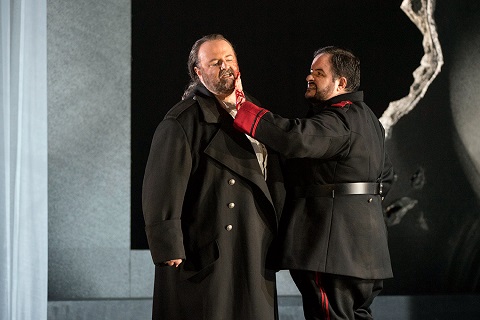 Gwyn Hughes Jones (Don Alvaro) and Luis Cansino (Don Carlo). Photo credit: Richard Hubert Smith.
Gwyn Hughes Jones (Don Alvaro) and Luis Cansino (Don Carlo). Photo credit: Richard Hubert Smith.
I thought that Pountney might have made more of Don Alvaro’s status as an outsider, and ‘other’, but Gwyn Hughes Jones used his ringing tenor to establish Alvaro’s bravado and courage; his sweeping arrival via Leonora’s balcony was equal in panache to Otello’s ‘Exultate!’, while his third-act aria, ‘La vita e inferno’, demonstrated expressive nuance. Luis Cansino’s baritone was full of dark resentment, but his Carlo was rather stiff dramatically.
I was impressed by Miklós Sebestyén’s Padre Guardiano: the considerable texture of his bass-baritone brought the character to life, establishing the Father Superior’s gravitas and empathy, while as the unsympathetic patriarch, Il Marchese, he was fittingly implacable and resonant. Donald Maxwell was less full-voiced as the disdainful Friar Mellitone but conveyed all of the latter’s irascibility.
The WNO chorus were in fine voice, impersonating foolhardy fascists, an impoverished populace and merciless monks with equal fervour. Carlo Rizzi demonstrated his innate appreciation of Verdi’s rhythmic arguments - the tense syncopations of the overture undeniably signalling trouble ahead - and balanced tempest and tenderness with discernment.
WNO’s spring tour continues: https://www.wno.org.uk/season/rabble-rousers
Claire Seymour
Verdi: La forza del destino
Leonora - Mary Elizabeth Williams, Don Alvaro - Gwyn Hughes Jones, Preziosilla/Curra - Justina Gringytė, Don Carlo Di Vargas - Luis Cansino, Il Marchese di Calatrava/Padre - Guardiano Miklós Sebestyén, Fra Melitone - Donald Maxwell, Mastro Trabuco - Alun Rhys-Jenkins, Alcade Wyn Pencarreg; Director - David Pountney, Conductor - Carlo Rizzi, Set Designer - Raimund Bauer, Costume Designer - Marie-Jeanne Lecca, Lighting Designer - Fabrice Kebour, Choreographer Michael Spenceley.
Welsh National Opera, Birmingham Hippodrome; Tuesday 6th March 2018.
image=http://www.operatoday.com/WNO%20La%20forza%20Hippodrome.jpg image_description=La forza del destino, Welsh National Opera at the Birmingham Hippodrome product=yes product_title=La forza del destino, Welsh National Opera at the Birmingham Hippodrome product_by=A review by Claire Seymour product_id=Above: Mary Elizabeth Williams (Leonora)Photo credit: Richard Hubert Smith
March 7, 2018
A Midsummer Night's Dream at the Royal College of Music
In his new production of Britten’s A Midsummer Night’s Dream for the Royal College of Music, director Liam Steel seems to want to seek out the play’s, and the opera’s, darker purposes - to ‘re-instate the seminal strand of sexuality and abandonment at the heart of Shakespeare’s original creation’. So far, so good. But, when Steel decides that Shakespeare’s depiction of Midsummer Eve licentiousness was ‘a reaction to a fundamentalist society in the grip of Puritanism’ (when the play was written in 1595/96?) and that therefore it would be a good idea to set his production in the Weimar Republic - which, he argues, ‘essentially became the “Midsummer Woods” of Elizabethan England’, and which, lacking censorship and promoting sensuality, is ‘the world into which our lovers and Bottom fall’ - he steps, like Shakespeare’s mortals, from the path of reason.
Admittedly, the 1920s underground cabaret scene, in which sex and politics were served up as sensuous satire, might serve as a parallel for the liberation which Shakespeare’s mortals, fleeing from courtly and social mores, momentarily find in the forest. Indeed, Stefan Zweig’s condemnation of Berlin’s cabaret scene, ‘Amid the general collapse of values, a kind of insanity took hold of precisely those middle-class circles which had hitherto been unshakeable in their order’, isn’t so far from the experience of Shakespeare’s lovers.
And, there’s plentiful bawdiness in Shakespeare’s text, even in the opening court scene (omitted in Britten’s opera): from Theseus’s initial lament of impatience that the ‘old moon … lingers my desires/Like to a step-dame, or a dowager,/Long withering out a young man's revenue’, with its plentiful double entendres, to his declaration to Hippolyta, ‘I wooed thee with my sword/ And won thy love, doing thee injuries’, which may celebrate a double conquest, on the battlefield and in bed.
Moreover, the play abounds with meta-theatrical references and devices, and so when George Longworth’s Puck rattled the cabaret club shutters to usher us into the party, the invitation didn’t seem out of place. Were we to enter a Berlin Baccanalia where lovers swapped partners in a psychedelic trance?
No, is the short answer. Although, Shakespeare’s wood - as Britten’s score confirms - is a world ruled by a magic which conjures desire, delirium and danger in equal measure, Steel’s concept never comes close to matching this power of enchantment. Lights pulse in the darkness of Michael Pavelka’s mirror-strewn set, illuminated by Andy Purves’ streaks of colour and gleam. An iron-framed four-poster bed is wheeled back and forth, and the mortals’ ‘Shadows’ slink through the eponymous gloom, clad in black leather and lace. But, there’s little that is risqué, reckless or red-blooded.
Timothy Morgan’s Oberon is neither a monstrous tormentor nor mischievous mocker, though he looked strikingly seedy! While ‘I know a bank’ gleamed purely, Morgan struggled with the shift to the chest voice needed to project Britten’s low-lying lines with sufficient expressive warmth to assert the Fairy King’s authority - though, guided by conductor Michael Rosewell, the cellos and basses provided sensitive support. Similarly, Longworth’s Puck was more merry sprite than devil’s spirit and displayed little delight in torturing the mortals, concerned more with winning his master’s affectionate attentions.
Harriet Eyley - whom I admired very much as the Vixen in RCM’s production of Janáček’s own forest foray last autumn, and in Poulenc’s Les mamelles de Tirésias at the College earlier that year - was, as Tytania, once again tremendously glossy of voice, adding some much needed glamour. She was ‘protected’ by a fairy chorus comprising dulcet-voiced members of Trinity Boys Choir who, attired in evening dress and round, tinted specs, seemed to be ‘black’ versions of the school-boy sprites seen in Netia Jones’ Snape Maltings production last year. Not only were they ineffectual sentries - simply hoisted and carried off by the mortals’ Shadows - as apparently aged spectators at the show, they looked thoroughly bored. If they’d paid for the ‘cabaret’, they might well have demanded their money back.
Shakespeare and Britten juxtapose the reason of daytime, as advocated by Theseus, with the irrationality of the night, as ruled by Oberon, but there’s no such dichotomy in Steel’s production. Lauren Joyanne Morris’s Hermia may pack her suitcase during Britten’s opening ‘sleep chords’ - disturbing the glissandi dreams with irreverent hustle and bustle - but where are the lovers escaping from and to, and to where will they return? It’s pitch black to begin with, so there can be no sense of deepening darkness as the four aristocrats venture further into the forest. Moreover, what are a troupe of ‘rustics’ doing in Weimar Berlin?
Thankfully, Steel’s concept is so illogical that neither he, nor the audience, feel the need to ‘follow it through’. It was easy to ignore the anachronisms, though the frequent references to the moon were irritating, and simply enjoy some very strong singing from the Royal College postgraduates. I particularly admired the strong melodic lines of the four lovers, Morris, Josephine Goddard (Helena), Joel Williams (Lysander) and Kieran Rayner (Demetrius): the quartet made much of Britten’s predominantly scale-based lines and create dramatic distinctiveness too. All demonstrated superbly clear diction.
When Peter Quince and his would-be thespians gathered for their rehearsal, they might as well as have landed on the moon: their first scene was even more disorientating than usual, although Hugo Herman-Wilson’s Quince worked hard to keep ‘both’ shows on the road. The mechanicals sang and acted with equal skill but Steel’s decision to resort to the usual broad humour in the play-within-a-play was surely an opportunity missed. Britten may burlesque his own genre - Flute’s Donizettian flights were reputed a vehicle for Peter Pears’ party-trick lampooning of Joan Sutherland - but the ‘perfectly’ executed maladroitness of the Pyramus and Thisbe stage-business seemed a weak choice given the chance offered by Steel’ locale for more biting satire.
Every time I hear Ida Ränzlöv sing, I want to hear more! She stole the show in the title role of Faramondo at last year’s London Handel Festival, was a lustrous-voiced, haughtily-mannered Fox in the RCM’s Cunning Little Vixen in November, and also greatly impressed as the Daughter in British Youth Opera’s production of Judith Weir’s The Vanishing Bridegroom’s last September. Here, even though in the fairly small role of Hippolyta Ränzlöv had less opportunity to shine, shine she certainly did - despite Steel’s best efforts to subdue the Amazonian Queen by throwing, quite literally, some domestic violence into the nuptial celebrations of Theseus (confidently sung by Peter Edge) and his new bride.
In Shakespeare’s final scene Theseus speaks seriously and sensitively to Hippolyta. She is a vanquished Amazonian Queen, forced to marry her conqueror, but within the world of the play their courtly marriage is decorous and controlled, a symbol of concord and order. Shakespeare, as so often, employs a musical metaphor to confirm this: at the end of Act IV the sound of Theseus’s baying hounds is joined with the pitches of his horns, which are blown to wake the lovers, and the King declares, ‘Theseus: ‘We will, fair queen, up to the mountain’s top/And mark the musical confusion/ Of hounds and echo in conjunction.’ Fortunately, Ränzlöv’s vocal dignity injected some reason and restraint into the proceedings.
Timothy Edlin was an excellent Bottom, but in this production his ‘Dream’ - the heart of the play, and the opera, in which Bottom, in the words of one critic, ‘reconfirms himself as a comic mirror for the general human condition’ - failed to make much of a dramatic mark.
There was much fine singing, supported by excellent work by the orchestral musicians who, despite their small numbers, conjured Britten’s musical mysteries. But, Steel’s production has surprisingly scant dark disorder and no midsummer magic.
Claire Seymour
Britten: A Midsummer Night’s Dream Op.64
Oberon - Timothy Morgan, Tytania - Harriet Eyley, Hermia - Lauren Joyanne Morris, Helena - Josephine Goddard, Lysander - Joel Williams, Demetrius - Kieran Williams, Bottom - Timothy Edlin, Quince - Hufo Herman-Wilson, Snout - Robert Forrest, Snug - Conall O’Neill, Flute - Thomas Erlank, Starveling - Dan D’Souza, Theseus - Peter Edge, Hippolyta - Ida Ränzlöv, Puck - George Longworth, Cobweb - Freddie Jemison, Mustardseed - Ethan Hocquellet, Moth - Felix Barry-Casademunt, Peasblossom, Alexander Chan, Fairies - Samuel Adebajo, Andrew Ah Weng, James Blaire, Joseph Cassidy, Sacha Cooper, Simeon Wren; Director - Liam Steel, Conductor - Michael Rosewell, Costume designer - Michael Pavelka, Lighting designer - Andy Purves, Royal College of Music Opera Orchestra.
Britten Theatre, Royal College of Music, London; Monday 5th March 2018.
image=http://www.operatoday.com/MSND%201.jpg image_description=A Midsummer Night’s Dream, Royal College of Music product=yes product_title=A Midsummer Night’s Dream, Royal College of Music product_by=A review by Claire Seymour product_id=Above: George Longworth: PuckPhoto courtesy of Royal College of Music
March 3, 2018
Les Funérailles Royales de Louis XIV recreated at Versailles
When Louis took control of his kingdom, he marked the occasion with an extravaganza, Le Concert Royal de la Nuit, a grand statement that was as much political as artistic. Just as the Sun King announced his arrival at Dawn, dressed as the sun, his funeral was staged in darkness : the Sun having gone down on his world. Everything Louis XIV did was a form of theatre, from the audacity of his vision for France, to Versailles, and even to his wigs and clothing.
Though extremely well played and sung, this performance needs to be experienced visually for maximum impact. Night time shrouds the architectural splendours of the Chapelle Royale, but this is how things should be. In the presence of death, material glory is nothing. In the presence of God, even the Sun King is mortal man. The original funeral rites took place over a period of 24 hours, with ovations, prayers and lying in state. Here, instead, we focus on the music, and its liturgical meaning. Darkness enhances the experience, intensifying the mystery that is life and death.
A single bell tolls. Out of the gloom we hear the Subventi sancti Dei, sung as if by monastic choir. The voices echo out into the distance, filling the recesses of the chapel. The echo in this performance space is glorious, more otherworldly and spiritual than can be replicated in modern buildings or studios. We catch quick glimpses of marble alcoves, lit for a moment before darkness falls again. Later the spotlight lingers on a soprano/tenor/baritone trio. The black and white starkness is warmed by flashes of golden light, contrasting with blue light through the windows beyond, reinforcing the idea of "eternal light" in the distance. But the days of wrath are still to come. The "monastic choir" intones, led at times by a bass baritone. A descent into total darkness, the silence broken by the thud of a single drum. André Danican Philidor Marche pour le Convoy du roi accompanies the procession of the King's simple black-draped coffin as it slowly enters the chapel and down the nave. Even in death, Louis XIV recognized the power of symbolism. The chapel door closes. The King is no longer "of the world". An extended De profundis by Michel-Richard de Lalande, led by the magnificent bass baritone of Christian Immler, reminds us of the achievements of the King's past. From a position near the roof, a solo bass voice intones,imploring God to grant mercy. His voice, and the voices of the two small choirs in balconies above the nave, reverberate as if unto the Heavens. The haute-contre, Samuel Boden sings an unearthly In paradisum. He isn't visible, but his voice is heard as we ponder the ornate ceiling fresco which depicts God. A de Lalande Dies Irae follows, Immler singing of the trumpet call that shall awake the dead to the Day of Judgement. A beautiful passage, where Samuel Boden sings of hope and redemption. Light is beginning to fill the chapel. The cameras linger on the singers and players, the mortals Jesus was sent to Earth to save. "Lord grant him Mercy" : soloists, choirs, and players all together in harmony, as the camera pans on the image of the sun above the altar, painted gold, its rays descending on the ensemble below. Soloists included Céline Scheen, Lucile Richardot, Samuel Boden, Marc Mauillon and Christian Immler. Realisation for film was by Stéphanien Vérité, lighting by Bertrand Coudere. Raphaël Pichon conducted the Ensemble Pygmalion orchestra and choirs. We're not supposed to "enjoy" funerals, but Louis XIV must have gone out in style.
Anne Ozorio
image=https://upload.wikimedia.org/wikipedia/commons/thumb/c/cd/LouisXIV-Bernini.jpg/256px-LouisXIV-Bernini.jpg
image_description=Gian Lorenzo Bernini : Bust of Louis XIV
product=yes
product_title=Les Funérailles Royales de Louis XIV, Ensemble Pygmalion, Raphaël Pichon (conductor), Céline Scheen, Lucile Richardot, Samuel Boden, Marc Mauillon and Christian Immler.
product_by=A review by Anne Ozorio
product_id=Harmonia Mundi HMD 9909056.57 DVD, Blu-ray
price=
product_url=
March 2, 2018
Robert Carsen's A Midsummer Night's Dream returns to ENO
Carsen's production debuted at Aix-en-Provence in 1991, was first given by ENO in 1995 and last performed by them in 2004, and for this revival, the cast featured the ENO Harwood Artists strongly. Christopher Ainslie was Oberon and Soraya Mafi was Titania, with Clare Presland, David Webb, Matthew Durkan and Eleanor Dennis as the lovers, Joshua Bloom was Bottom with Graeme Danby, Simon Butteriss, Timothy Robinson, Robert Murray and Jonathan Lemalu as the Mechanicals, Andri Bjorn Robertsson was Theseus and Emma Carrington was Hippolyta, with Milto Yerolemou as Puck. The conductor was Alexander Soddy, who is currently musical director of the Nationaltheater, Mannheim.
The forest in Carsen's production is the world of sleep and dreams, and beds feature heavily in Michael Levine's decor, and costumes give clear visual definition to the various groups in the opera, complementing the musical stratification which Britten uses to define his characters. There is a big cuteness element in the treatment of the fairies (the excellent Trinity Boys Choir) with their tailcoats, very formal manners and elaborate choreography (originally Matthew Bourne, revived by Daisy May Kemp). Perhaps the production does not dig very deep into the opera's psyche and is a little too keen to please, but it forms an excellent vehicle for such a revival with a large contingent of young singers.
Yet, A Midsummer Night's Dream was originally written for the Jubilee Hall in Aldeburgh, which seated just over 300 as opposed to the London Coliseum which seats over 2000. Like the recent productions of G&S at by ENO, there is a sense of Britten's opera having to be re-invented to fill the Coliseum spaces, and you felt that not all the performers in this revival had yet found their feet.
Christopher Ainslie looked superb as Oberon, tall and aristocratic with a slightly icy demeanour which works well with Britten's writing for the counter-tenor voice (as originally sung by Alfred Deller). But the tessitura of the role is rather low for a modern counter-tenor, and though Ainslie sang with a lovely warm timbre and flexible sense of line, his voice did not project with the sort of commanding grace which the role needed though having so much of the action up-stage did not help. Alexander Soddy's speeds seemed, at times, dangerously slow and Ainslie's 'I know a bank' was rather slower than was ideal.
By comparison, Soraya Mafi as Tytania had got the measure of the venue and projected the role's coloratura with personality and ease. She made a delightful Tytania, not as bitchy as some, and brought real charm to Britten's roulades and an underlying sense of humour in the scenes with Joshua Bloom's bottom. Given her fine performance has Handel's Cleopatra in Giulio Cesare for English Touring Opera, Mafi is clearly a talent to watch in this repertoire.
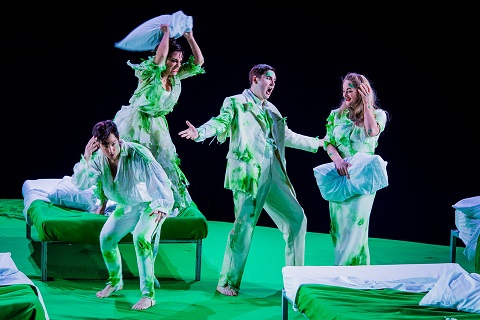 David Webb, Clare Presland, Matthew Durkan and Eleanor Dennis. Photo credit: Robert Workman.
David Webb, Clare Presland, Matthew Durkan and Eleanor Dennis. Photo credit: Robert Workman.
Clare Presland as Hermia, David Webb as Lysander, Matthew Durkan as Demetrius and Eleanor Dennis as Helena made a lovely, well-characterised group of lovers, clearly relishing the opportunities that the second acts confusions gave them. Each brought a nice sense of character to the role with Eleanor Dennis's rather uptight, blue-stocking Helena (who loosens up considerably), Clare Presland's spunky Hermia, David Webb's nice but dim Lysander and Matthew Durkan's bellicose Demetrius. In a smaller venue this would have worked very well, young voices singing roles just right for them, but in the Coliseum, an element of the drama did not quite cross the footlights and though it looked good, the singers' sense of engagement did not quite project. But this is something which will develop over the run.
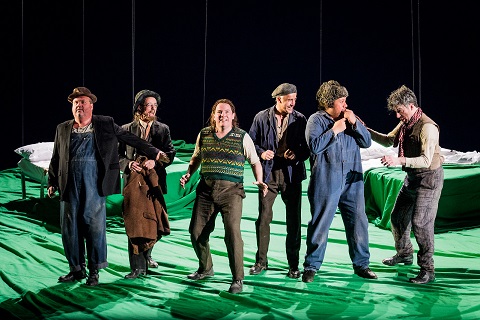 Graeme Danby, Simon Butteriss, Robert Murray, Timothy Robinson, Jonathan Lemalu and Joshua Bloom. Photo credit: Robert Workman.
Graeme Danby, Simon Butteriss, Robert Murray, Timothy Robinson, Jonathan Lemalu and Joshua Bloom. Photo credit: Robert Workman.
With such an experienced group of Mechanicals, there was little danger of the drama failing to project here. Joshua Bloom made an engaging Bottom, well sung and nicely characterised with an arrogant swagger but without too much of the self-importance which can be a bit annoying. He had great fun with the suggestiveness of the donkey costume. The others were all effectively and colourfully projected, with Robert Murray's bashful Flute, Graeme Danby's officious Quince, Simon Butteriss's rather overlooked Starveling, Timothy Robinson's delightful Snout and Jonathan Lemalu as an engagingly dim Snug. They had great fun with all the comic business, and frankly, the only way to play the operatic send-up of 'Pyramus and Thisbe' is to play it to the hilt, which they did.
Andri Bjorn Robertsson and Emma Carrington made a noble looking Theseus and Hippolyta, joining with the lovers in the third act to make terrible fun of the Mechanicals.
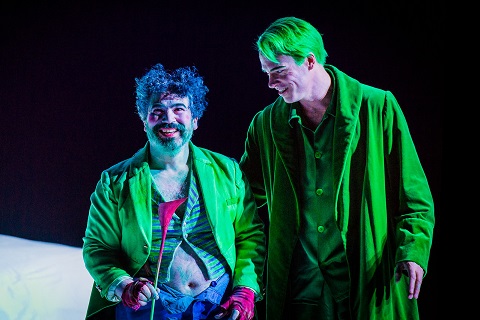 Miltos Yerolemou and Christopher Ainslie. Photo credit: Robert Workman.
Miltos Yerolemou and Christopher Ainslie. Photo credit: Robert Workman.
Miltos Yeremolou made a very funny Puck. A very physical performer, sometimes you wondered whether it was a little too much, should the production be quite as funny as that. But then, Carsen's overall conception does not really mine the darker side of the opera, and I rather longed for something which sat between Carsen's cuteness and Christopher Alden's dark dystopian view.
The Trinity Boys Choir performed admirably as the fairies, dealing admirably with the complexity of the staging along with Britten's music. The four young soloists, Aman de Silva, Lucas Rebato, Caspar Burman and Dionysius Sevastakis made a fine quartet of solo fairies.
Conductor Alexander Soddy, making a rare appearance in the UK, brought a great sense of detail to Britten's score and drew out some lovely and evocative textures from the players. The opening string glissandi were simply magical, but on occasions, Soddy seemed to rather linger too long over lovely details. In what is quite a long piece, you wanted a bit more dramatic impetus.
This was a revival which you feel needs a little more time to come into focus, but it presents a welcome opportunity to hear five of the current ENO Harewood Artists alongside other young singers, complemented by a fine group of Mechanicals.
Robert Hugill
Britten: A Midsummer Night’s Dream
Oberon - Christopher Ainslie, Tytania - Soraya Mafi, Puck - Miltos
Yerolemou, Hermia - Clare Presland, Lysander - David Webb, Demetrius -
Matthew Durkan, Helena - Eleanor Dennis, Quince - Graeme Danby, Bottom -
Joshua Bloom, Starveling - Simon Butteriss, Snout - Timothy Robinson, Flute
- Robert Murray, Snug - Jonathan Lemalu, Theseus - Andri Bjorn Robertsson,
Hippolyta - Emma Carrington; Director - Robert Carsen, Conductor -
Alexander Soddy, Associate director - Emmanuelle Bastet, Designer - Michael
Levine, ENO Orchestra, Trinity Boys Choir.
English National Opera, Coliseum, London; Thursday 1st March 2018.
image=http://www.operatoday.com/Christopher%20Ainslie%20Soraya%20Mafi%20Trinity%20Boys%20Choir%203%20%28c%29%20Robert%20Workman.jpg image_description=Robert Carson’s A Midsummer Night’s Dream at English National Opera product=yes product_title=Robert Carson’s A Midsummer Night’s Dream at English National Opera product_by=A review by Robert Hugill product_id= Above: Christopher Ainslie, Soraya Mafi, Trinity Boys ChoirPhoto credit: Robert Workman
Turandot in San Diego—Prima la voce
Lise Lindstrom has been performing her signature title role in all of the world’s leading houses and it is easy to see why she is in demand. Ms. Lindstrom has all the stamina, range, and vocal quality required to succeed in this fiendishly difficult “sing.” Her searing upper range is steady and full without ever becoming acidic. Her low and middle ranges have a round, warm appeal that help humanize the icy princess to a certain degree.
Lise is also a lovely presence on the stage, dramatically committed and exuding an unerring musicality. That the voice still sounds fresh and free after so many outings with this punishing part (and others) attests to her rock solid technique. That she still communicates spontaneity and truthfulness in her portrayal attests to her intelligent artistry. I’m not Guinness, but I am guessing that the diva is setting a world record with her career totals of singing this part.
She was well matched by the solid tenor Carl Tanner. The role of Calaf in general and the aria Nessun dorma in particular are weighted with the baggage of expectations. Corelli, Carreras, Del Monaco, Domingo and most especially Pavarotti scored legendary successes in the role. Luciano’s famed rendition of the aria was nearly inescapable in its popularity. Mr. Tanner (who has performed the part over 100 times) makes the part his own sporting a sturdy, engaging instrument that is even throughout the range.
While his voice has considerable weight, he can soar above the staff with skill and an easy power. He embodies all the pathos required inNon piangero Liu, and checks all the blocks with an assured Nessun dorma. If he doesn’t have quite the final Italianate ping and sheen we are accustomed to, his knowing portrayal is nonetheless immensely affecting.
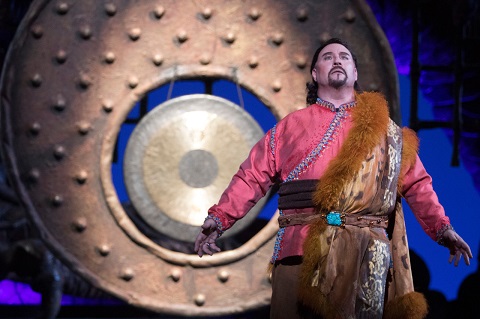 Tenor Carl Tanner (Calaf). Photo credit: J. Katarzyna Woronowicz Johnson.
Tenor Carl Tanner (Calaf). Photo credit: J. Katarzyna Woronowicz Johnson.
As can happen, Liu threatens to run away with the show. Part of the reason is that she is the only sympathetic character in this oft troublesome piece of writing. But she still has to deliver the goods and in a role debut, the buoyantly appealing Angel Joy Blue does all that and more. Ms. Blue has an uncommonly alluring spinto soprano, limpid and secure, and she knows just how to caress a phrase and touch the soul. Her two famous arias are served up with heartfelt investment in every utterance, and her floated high notes were particularly ravishing.
Brian Kontes offered a notably well sung Timur. Mr. Kontes has a rolling, charismatic bass with dusky overtones and wonderfully weighted presence. He found every inch of measured pathos in a part that sometimes gets short shrift. His assured stage presence made a substantial contribution to the evening’s success.
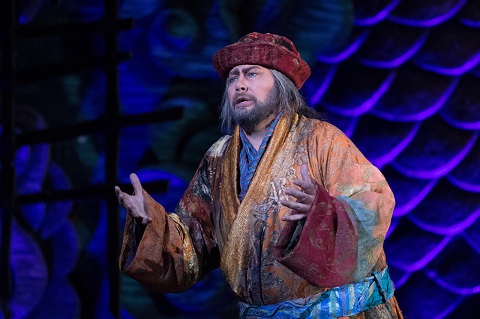 Bass Brian Kontes (Timur). Photo credit: J. Katarzyna Woronowicz Johnson.
Bass Brian Kontes (Timur). Photo credit: J. Katarzyna Woronowicz Johnson.
Ping, Pang and Pong were enthusiastically embodied by respectively, Marco Nistico; Joseph Gaines, and Joel Sorenson. Mr. Nistico’s Ping was warm-voiced and stylistically secure, although his substantial baritone sometimes seemed a bit covered in the upper middle. Mr. Gaines, as Pang, showed off his well-schooled, poised tenor all the while investing the part with his usual animation and dramatic commitment. Pong was well taken by Mr. Sorenson, who has a lean, shining tenor that admirably rounded out the trio.
While the three meshed beautifully as a team, at times functioning like a manic Commedia troupe, they found fully-realized, personalized characterizations. Their introspective yearnings for home in the Act II opening scene, were spell-binding in their melancholy and vocal beauty. Rounding out the cast, Chad Frisque’s plaintive, steady tenor made a good impression as the Emperor, and Scott Sikon’s stentorian bass-baritone made the most of the Mandarin’s declamations. Bruce Stasyna’s well-tutored chorus proved a powerful presence and their nuanced vocalizing was another potent element in the night’s musical arsenal.
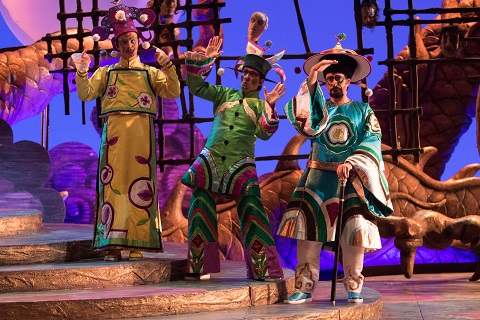 Tenor Joseph Gaines (Pang), tenor Joel Sorensen (Pong) and baritone Marco Nistico (Ping). Photo credit: J. Katarzyna Woronowicz Johnson.
Tenor Joseph Gaines (Pang), tenor Joel Sorensen (Pong) and baritone Marco Nistico (Ping). Photo credit: J. Katarzyna Woronowicz Johnson.
In the pit, conductor Valerio Galli whipped up a rousing reading , delighting in the detailed, angular chinoiserie, and eliciting a fine sense of ensemble that fully supported the singers without ever once overwhelming them. Maestro Galli’s winning grasp of the verismo style was evident throughout, and he ably coaxed and encouraged the talented orchestra to cover itself in glory.
The physical production was all one could wish. Allen Charles Klein has used a huge, snaking Chinese dragon as the basis for his set design and it was a strikingly effective solution. Mr. Klein borrowed a page from Wieland Wagner and has a large raked disc center stage, from which steps of circles spill downstage and to the sides, creating other playing spaces. With the addition of steps up to a higher stage right platform (for Altoum), and steps to an upturned “claw” that reaches right, giving us a wonderful playing space that offers plenty of levels. At one point a giant crystal ball is being held by said “claw.” A gong unit cleverly descends from the flies on cue.
Although this is the basis for the design, it never feels like a unit set. In Act One, grids of oversized, criss-crossed pick up sticks frame the action. Act Two begins with a black scrim isolating part of the downstage “discs” which become the library for the ministers of state, with the simple addition of chests/desks that contain their scholarly scrolls. For Act III, a mid-stage foliage-like arch hovers over the stage, obscuring the basic structure until the re-entrance of the full cast for the climax.
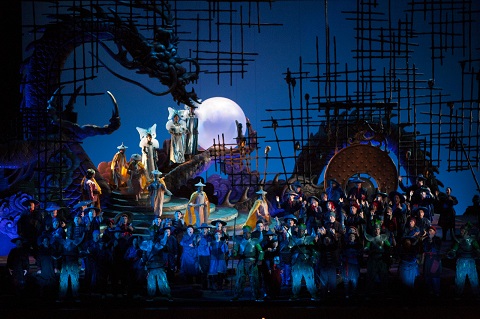 Scene from San Diego Opera’s Turandot. Photo credit: J. Katarzyna Woronowicz Johnson.
Scene from San Diego Opera’s Turandot. Photo credit: J. Katarzyna Woronowicz Johnson.
All of this was made to look atmospheric and sumptuous thank to the vibrant, well-judged lighting design from Lucas Krech. Mr. Krech calibrated a full palette of color washes, created good area definition, and utilized effective isolated specials to marvelous effect. The transition from the ominous bluish night of fear and threats, to the dawn of love and absolution was particularly striking. Willa Kim’s colorful, lavish costumes were a visual delight. Ms. Kim manages to dazzle the eye even while dressing the commoners in rich earth tones befitting their station. Steven W. Bryant’s skillful wig and make-up design completed the total success of the physical production.
Keturah Stickann has staged the epic with care and imagination. There are long stretches of massed ensemble singing, and Ms. Stickann manages to move the traffic to ever more interesting groupings and stage pictures. She makes excellent use of the levels to suggest the shifting power between the principles.
Although Puccini and his librettists have not given a wealth of detailed background to the characters (Calaf is especially undefined if tuneful), this director has worked with her cast to provide as much specificity as possible, while creating believable character relationships. Keturah has found a wealth of humor in the lively antics of the ministers, and created a truly moving moment after Liu’s suicide. I won’t completely give it away but it evokes a sort of touching “walk to paradise garden.”
This commendable production does exactly what any fine rendition must do: maximize the substantial musical excellences and successfully distract from the vagueness of characters’ individual emotional journeys. As the rafters rattled with some pretty thrilling singing, you knew you were at the right address.
It is hard to believe that a company capable of such a top tier assemblage of internationally acclaimed talent almost slipped from the opera scene two years ago. I hope that that problem is firmly behind SDO, since there is decidedly no problem with high quality of the product.
James Sohre
Puccini: Turandot
Mandarin: Scott Sikon; Liu: Angel Joy Blue; Calaf: Carl Tanner; Timur: Brian Kontes; Ping: Marco Nistico; Pang: Joseph Gaines; Pong: Joel Sorenson; Emperor Altoum: Chad Frisque; Princess Turandot: Lise Lindstrom; Prince of Persia: Felipe Prado; Handmaidens: Sarabeth Belon, Caroline Nelms; Conductor: Valerio Galli; Director: Keturah Stickann; Set Design: Allen Charles Klein; Costume Design: Willa Kim; Lighting Design: Lucas Krech; Wig and Make-up Design: Steven W. Bryant; Chorus Master: Bruce Stasyna.
image=http://www.operatoday.com/Lise%20Lindstrom%20Turandot.jpg image_description=Turandot at San Diego Opera product=yes product_title=Turandot in San Diego—Prima la voce product_by=A review by James Sohre product_id= Above: Soprano Lise Lindstrom (Turandot)Photo credit: J. Katarzyna Woronowicz Johnson